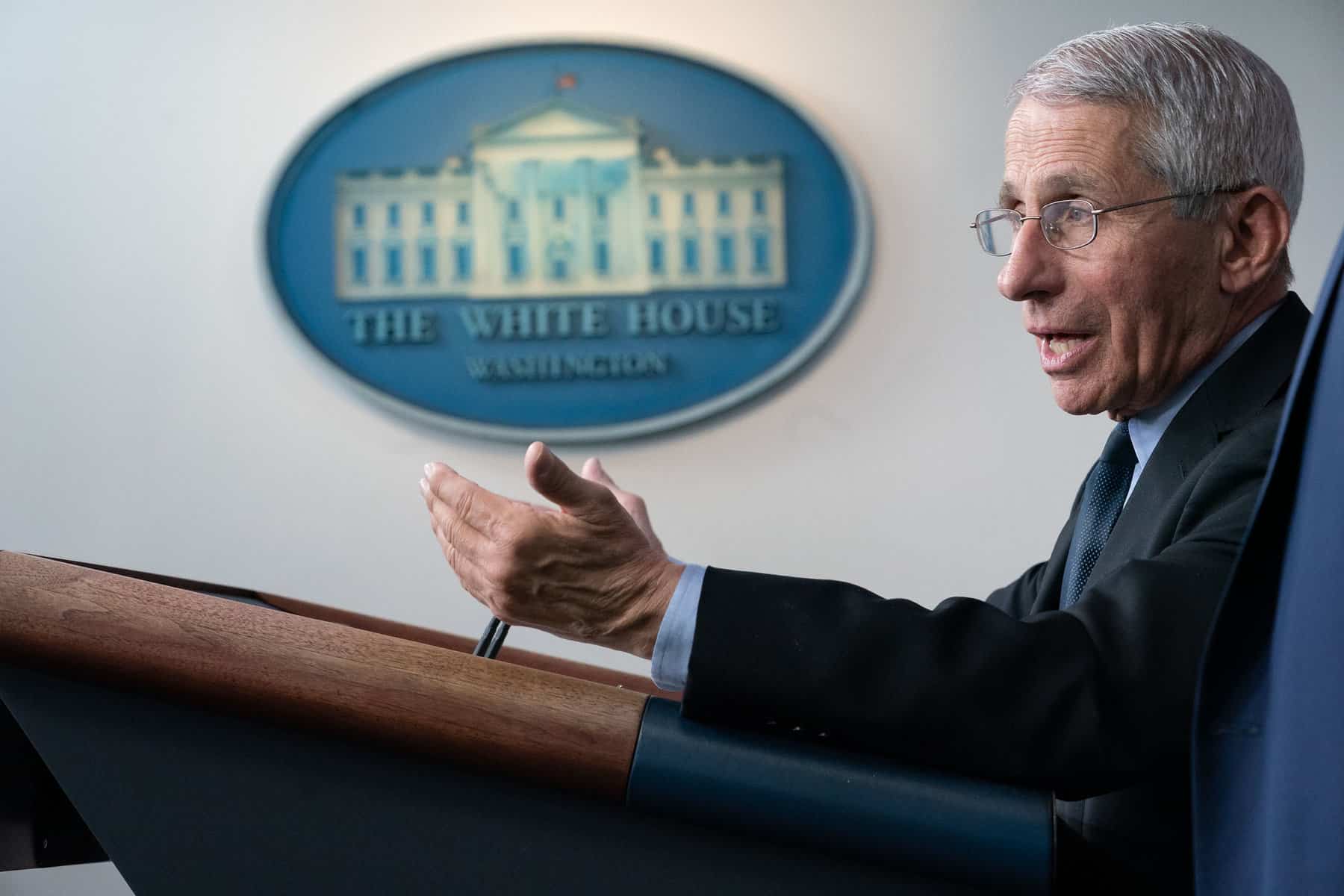
Updated: July 17, 2023
Introduction
“The proximal origin of SARS-CoV-2” is one of the most influential scientific articles in history.
In February 2020 — about a month before a pandemic had been declared — five top virologists huddled to examine aspects of a rapidly emerging coronavirus that seemed primed to infect human cells. In particular, a unique feature called the furin cleavage site caused concern, and even kept one virologist up all night. A few days later, the virologists concluded the virus had not been engineered. In March, their conclusions were published in Nature Medicine.
“We do not believe that any type of laboratory-based scenario is plausible,” the article read.
The article assured much of the media, Washington and the broader infectious disease community that there was no need to scrutinize the labs at the pandemic’s epicenter in Wuhan, China. The Wuhan Institute of Virology is well known for research on SARS-like coronaviruses, including gain-of-function research. Though a “correspondence” and not a formal paper, the article has been cited in the press 2,127 times. It ranked as the most impactful medical science article of 2020, the year in which millions around the globe first became familiar with COVID-19.
It took 15 months and Freedom of Information Act lawsuits to reveal that each of the five authors had expressed private concerns about engineering or the Wuhan Institute of Virology’s store of novel coronaviruses and work in relatively low biosafety levels.
Also troubling: A confidential teleconference had framed early drafts of the article. But several scientists on the call had undisclosed conflicts of interest.
Wellcome Trust Director Jeremy Farrar organized the teleconference at the request of National Institute of Allergy and Infectious Diseases Director Anthony Fauci.
NIAID had funded the Wuhan Institute of Virology — a fact Fauci had been alerted to by late January. Minutes after being alerted by one of the virologists to gain-of-function research underway in Wuhan, Fauci dispatched an aide to determine whether his institute had funded this work. Fauci was conferring with the National Security Council and the White House almost daily at that time, his schedule shows.
Also present on the call for “advice and leadership” but not publicly credited: director of the National Institutes of Health Francis Collins.
Two authors were later found to have collaborated with the Wuhan Institute of Virology.
Christian Drosten, a prominent virologist who participated in the teleconference, was once listed as a participant in a “virus hunting” project co-led by EcoHealth Alliance, the Wuhan Institute of Virology’s chief American partner.
Ron Fouchier, another virologist who shaped the article’s central ideas without credit, is synonymous with controversial viral engineering.
The authors of the “proximal origin” article are Scripps Research virologist Kristian Andersen, University of Sydney virologist Edward Holmes, Tulane School of Medicine virologist Robert Garry, University of Edinburgh virologist Andrew Rambaut and Columbia University virologist Ian Lipkin.
Another virologist was notably absent.
To Farrar, Holmes and Andersen, the work of another American virologist appeared to be “a how-to manual for building the Wuhan coronavirus in a laboratory.”
North Carolina University virologist Ralph Baric, a close collaborator of the Wuhan Institute of Virology, is a leading expert on coronaviruses and engineering techniques. His research had been at the center of the gain-of-function debate in the U.S. a few years earlier, sparking concerns it could generate “SARS 2.0.”
Several of his papers were discussed on the call, according to presentation slides obtained under FOIA.
But because of his ties to the Wuhan lab, he was left out of the discussion, according to Holmes.
“We decided not to invite Ralph Baric just because he was too close to the WIV. … He’s a great virologist. He’s guilty of nothing, I’ll tell you that right now. But we wanted to make it a proper investigation,” Holmes said in a December 2022 interview.
This timeline compiles numerous sources in an effort to covey the backstory of the enormously influential article. The timeline is likely to grow as more information emerges. All times have been approximated to Eastern Time.
Farrar said that “proximal origin” was motivated by the absence of an investigation by the WHO. However, emails show that Farrar simultaneously shepherded along the article and appealed to the WHO. Farrar also looped in the National Academies, which was tasked by the White House to investigate the origins of COVID-19.
In reality, Farrar expressed a desire to leaders at the WHO to “get ahead of the science and the narrative of this.” Fauci agreed.
Four days after flagging aspects of the genome that appeared engineered, Andersen coauthored an early draft which stated that such a scenario would be “largely incompatible with the data.” After days of discussing the possibility of the furin cleavage site arising from serial passage in the lab — a method of making a virus more dangerous in the lab without engineering — the possibility was dismissed in the final report. The article did not consider the possibility of a natural virus emerging from a lab, despite Andersen privately acknowledging it could not be ruled out.
Farrar described the frenzy and panic preceding the publication of “proximal origin.”
“Just a few of us – Eddie, Kristian, Tony and I – were now privy to sensitive information that, if proved to be true, might set off a whole series of events that would be far bigger than any of us. It felt as if a storm was gathering,” he said.
The aim, Farrar told his colleagues at the time, was to “lay down a respected statement to frame whatever debate goes on – before that debate gets out of hand with potentially hugely damaging ramifications.”
The scientists’ familiarity with the Wuhan Institute of Virology’s work on novel coronaviruses calls into question a central premise of the paper — that SARS-CoV-2 could not have been engineered because it appeared to be novel.
Two of the paper’s authors, Andersen and Holmes, have in particular come under scrutiny for an abrupt about-face — from suspecting the virus was engineered to viewing that suspicion as “crackpot” within a few days — as well as several conflicting public and private statements:
- Publicly, Andersen denied that Fauci was involved with the publication. But when privately appealing to the journal Nature to publish it, Andersen wrote that it had been in part “prompted” by Fauci to tamp down on “conspiracies.”
- Publicly, Andersen has said that his reversal represented a genuine shift as more evidence emerged. But in private emails Andersen assured other virologists that the express purpose of the paper was to refute a lab origin.
- Publicly, Andersen has pointed to the emergence of similar coronavirus sequences in pangolins as key to his 180 degree turn. But in private emails, Andersen stated that the pangolin sequences “do not… refute a lab origin.”
- Publicly, the article stated that “we do not believe that any type of laboratory-based scenario is plausible.” Privately, Andersen conceded that a natural virus that had escaped from a lab would be indistinguishable from a virus that emerged from nature.
- A central premise of the article was that a lab origin was unlikely because “SARS-CoV-2 is not derived from any previously used virus backbone.” Privately, Andersen conceded that this argument was “subjective.”
- Publicly, scientists who called attention to SARS-CoV-2 being well adapted to infect human cells as compared to early strains of SARS stood alone. In private, Holmes said the apparent preadaptation of SARS-CoV-2 and its early epidemiology as compared to SARS was “worrying.”
- The “proximal origin” article mentions a cousin coronavirus to COVID-19 called RaTG13. Privately, Andersen and Holmes worried about the implications of this close cousin virus having been discovered at the Wuhan Institute of Virology.
In addition to its massive influence on the press, the publication had behind-the-scenes impact too, helping to delay serious consideration of the lab leak theory among many officials within the U.S. government.
As the article was being drafted, Andersen briefed national security officials. Garry, another coauthor, was among the virologists who briefed the intelligence community on the pandemic’s origins. Officials at the State Department would cite the article to oppose scrutinizing the Wuhan Institute of Virology. The National Academies committee tasked by the White House to advise on the pandemic’s origins in 2020 was told their work was completed by early February 2020.
Summary
January 27, 2020: Fauci learned he funds the Wuhan Institute of Virology.
January 29, 2020: Andersen discovered a paper describing gain-of-function techniques with coronaviruses involving the Wuhan Institute of Virology. Farrar asks to speak with Fauci.
January 31, 2020: Fauci and Andersen spoke privately. Four virologists, including three authors of the article — Andersen, Holmes and Garry — found the virus to be “inconsistent with expectations from evolutionary theory.”
February 1, 2020: Farrar organized a secret teleconference between the virologists and NIH. Separately, Fauci sought to learn more about which projects NIAID funded at the lab.
February 2, 2020: The virologists exchanged thoughts. Several leaned toward a lab origin. Garry said he cannot understand how SARS-CoV-2 could have emerged naturally after comparing it to RaTG13. The scientists express concerns about work with coronaviruses being done in Wuhan in BSL-2 conditions. “Wild west,” said Farrar. Farrar emphasized the importance of publishing something quickly to counteract “lurid” claims emerging about a lab origin.
February 4, 2020: A draft was circulated. Holmes, “60-40 lab,” said the draft, “does not mention other anomalies as that will make us look like loons.” Andersen derided the idea of an engineered virus as “crackpot” and promoted the phrase “consistent with natural evolution” to scientists outside of the confab.
March 6, 2020: Andersen thanked Farrar, Collins and Fauci for their “advice and leadership.”
April 17, 2020: Fauci told reporters COVID-19 is “totally consistent with a jump of a species from an animal to a human,” citing the paper.
August 19, 2020: Collins and Fauci discussed the termination of an EcoHealth Alliance grant and the lab leak theory. Eight days later, a new grant is extended from NIAID to EcoHealth and Andersen’s lab.
June 20, 2021: Collins, Fauci, Andersen and Garry encouraged a researcher to rethink a preprint about early SARS-CoV-2 sequences that NIH improperly spiked from its database. Andersen proposed deleting it from a preprint server.
July 31, 2022: New entries to an NIH database indicated a relationship between Holmes and the Wuhan Institute of Virology, including work on RaTG13.
Timeline
‘Mid-January’: CDC director sounds the alarm
Robert Redfield, director of the Centers for Disease Control and Prevention and a virologist, voiced the concern that a lab accident occurred at the Wuhan Institute of Virology. He shared this concern with Fauci, Farrar, and World Health Organization Director-General Tedros Ghebreyesus, Vanity Fair first reported.
Despite these early warnings, Redfield was not included in subsequent conversations about the issue.
“They wanted a single narrative and I obviously had a different point of view,” Redfield said.
Fauci has denied purposefully excluding Redfield.
Redfield has described the “proximal origin” paper as “antithetical to science” in that its purpose was apparently to preclude debate. He has called for it to be retracted.
January 14, 2020: Fauci meets with the National Security Council
Fauci met for the first time with the National Security Council about the novel coronavirus, according to a schedule obtained under FOIA by Open the Books and Judicial Watch.
Fauci would meet with the NSC 16 times in January and February, sometimes in a sensitive compartmented information facility (“SCIF”) at NIH and sometimes in the Eisenhower Executive Office Building.
The schedule shows Fauci meeting with NSC Director for Countering Biological Threats Phil Ferro, Senior Director for Counterproliferation and Biodefense Anthony Ruggiero, and NSC official Lauren Fabina. These meetings may have involved many officials across a constellation of agencies, according to a separate document obtained by U.S. Right to Know.
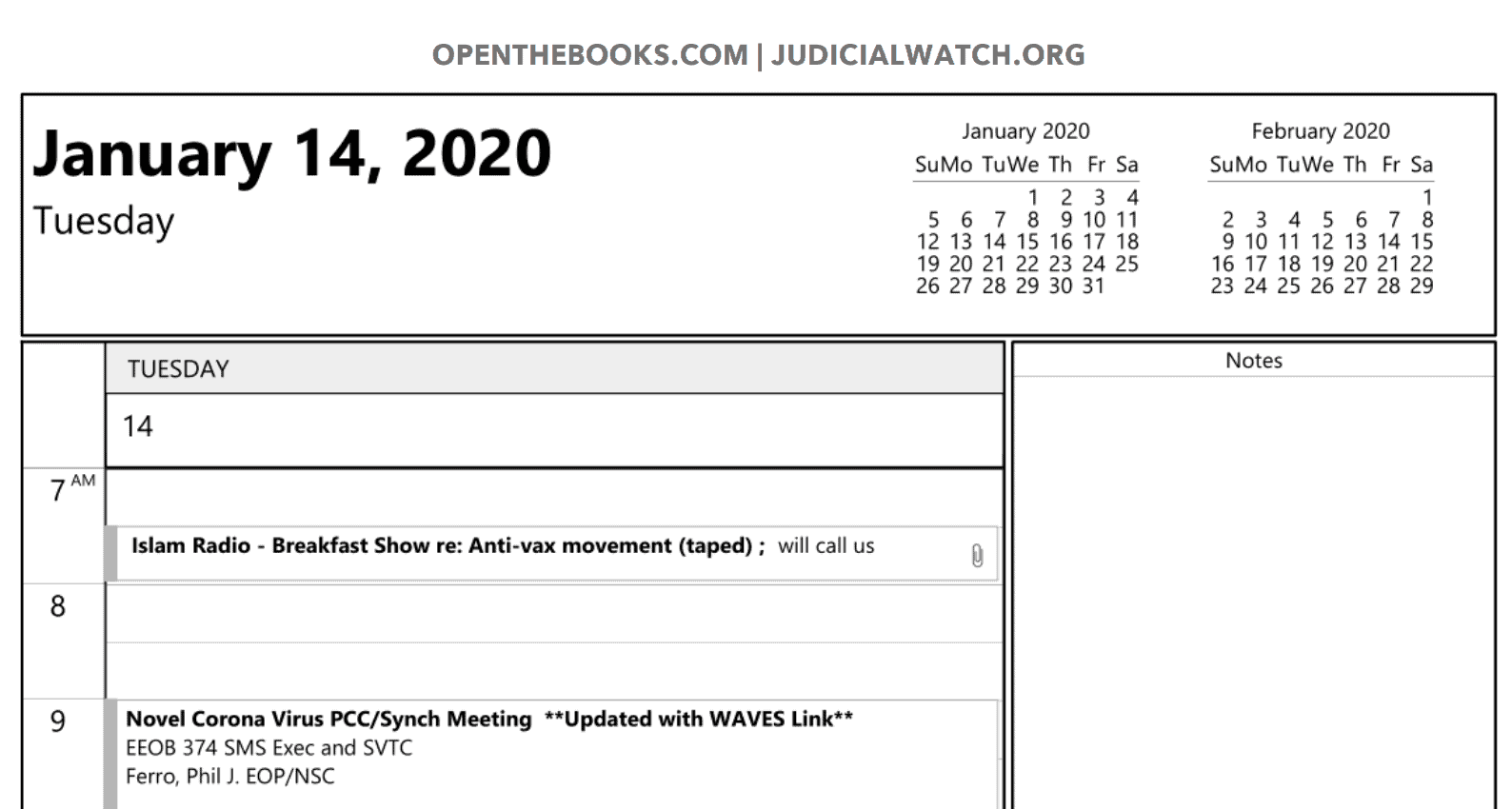
January 23, 2020: Fauci meets with biosafety advisor to Wuhan Institute of Virology
Fauci met with James Le Duc, then the director of a BSL-4 lab in Texas with a cooperative agreement with the Wuhan Institute of Virology and a global expert in biosafety.
Le Duc had penned an op-ed published a few days earlier that stated that “relations within the public health and scientific research arenas remain open and positive” with China.
In fact, Le Duc would be unsuccessful in his attempt to obtain more information about biosafety standards from his counterpart in Wuhan. He reached out to Yuan Zhiming, director of the Wuhan institute’s maximum biocontainment lab, but his lab’s cooperative agreement with the lab was fragile. He never received a reply to his questions, and the cooperative agreement allowed for any shared data to be deleted.
Le Duc at first assured Congress and the media that a lab accident was unlikely, but later quietly outlined how an investigation might be conducted to colleagues.
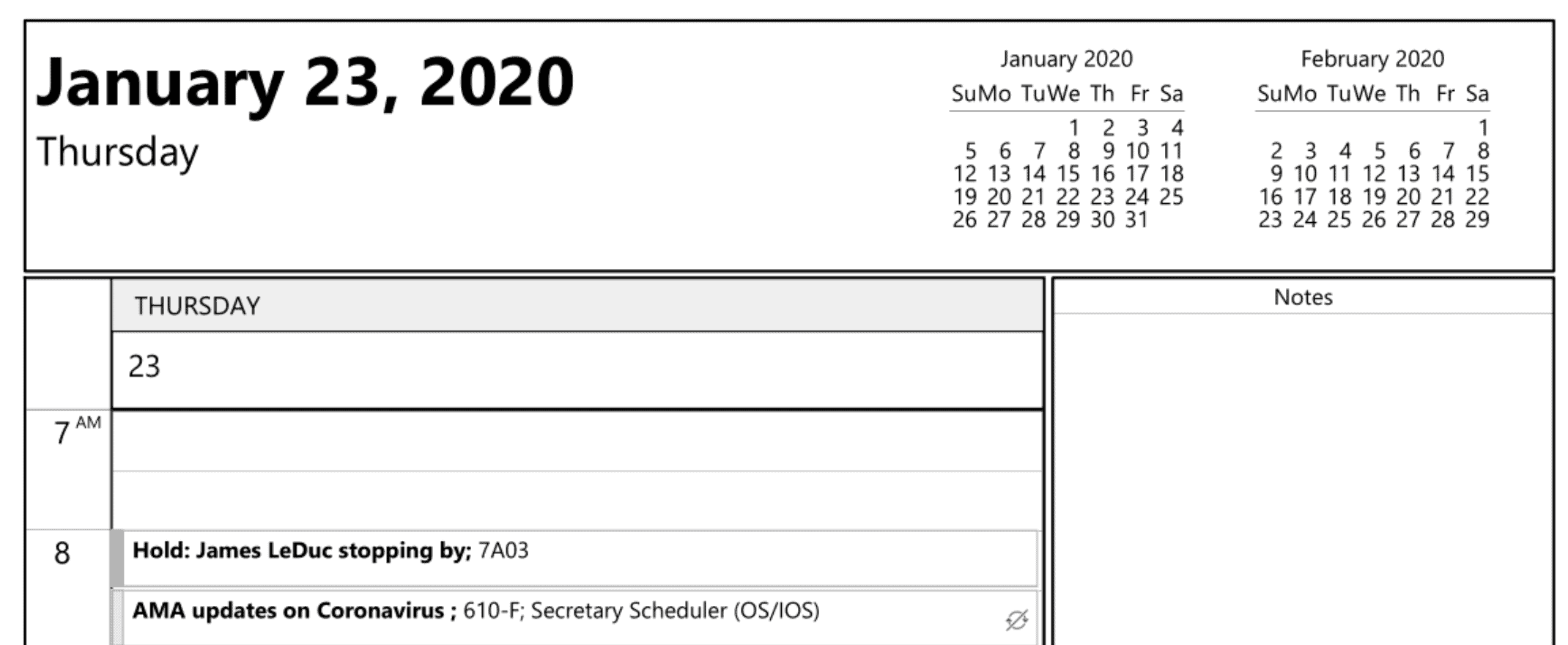
January 27, 2020: Fauci learns he funded the Wuhan Institute of Virology
In the last week of January, Farrar noticed email chatter among credible scientists “suggesting the virus looked almost engineered to infect human cells,” according to his memoir Spike.
6:59 a.m.
Farrar acquired a second phone for discussing the origin of SARS-CoV-2.

“We should use different phones; avoid putting things in emails; and ditch our normal email addresses and phone contacts,” Farrar wrote in his memoir. “I didn’t know the term then but I now had a burner phone, which I would use only for this purpose and then get rid of.”
6:24 p.m.
By January 27, Fauci knows his institute funded work on coronaviruses at the Wuhan Institute of Virology through the EcoHealth Alliance, according to an email obtained by the House Oversight and Reform Committee.
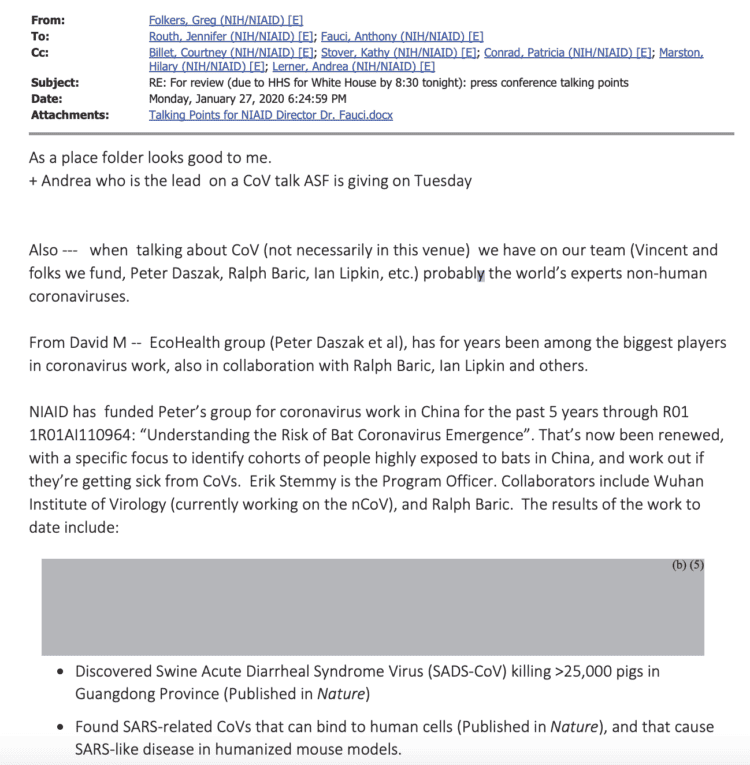
Some major takeaways from EcoHealth’s NIAID-funded research are shared with Fauci, but some details are redacted. One of the papers flagged to Fauci: A Nature study showing that SARS-related bat coronaviruses can bind to human cells and cause SARS-like disease in humanized mice.
This paper — coauthored by University of North Carolina coronavirologist Ralph Baric and Wuhan Institute of Virology coronavirologist Zhengli Shi — had fueled controversy around whether the gain-of-function research could generate “SARS 2.0” a few years earlier.
The paper appears to have figured into subsequent discussions under a shorthand name: “SARS gain of function.” It initially appeared to the group of virologists to be “a how-to manual for building the Wuhan coronavirus in a laboratory,” alarming Fauci.
But Baric was excluded from subsequent discussions because he was seen as too close to the Wuhan Institute of Virology, according to Holmes.
“We said ‘let’s not invite Ralph,’” Holmes said.
January 28, 2020: Discussions begin
Farrar called Holmes, concerned about chatter about the possibility of a lab accident and a recently published preprint on the server BioRxiv.
Farrar’s memoir does not name the preprint.
But Holmes identified the preprint in a 2022 interview as “Discovery of a novel coronavirus associated with the recent pneumonia outbreak in humans and its potential bat origin,” coauthored by Wuhan Institute of Virology Center for Emerging Infectious Diseases Director Zhengli Shi and published on January 23. The preprint described the sequence of SARS-CoV-2 and compared the virus to similar bat coronaviruses discovered by the Wuhan lab, including a coronavirus called RaTG13 with 96 percent similarity to SARS-CoV-2.
“I got an email from Jeremy Farrar saying, ‘There is some chatter in the U.S. about whether this virus has come out of a lab, do you have time for a talk now?’” Holmes said. “I think this is started because Zhengli Shi posts her first paper that ends up in Nature that has her sequence and RaTG13.”
“RaTG13 being the closest relative to SARS-CoV-2… so of course that leads to lots of chatter,” Holmes continued.
(Patrick Vallance, chief scientific advisor to the United Kingdom, may have also been on the line, Holmes said.)
Holmes was “indifferent” to the similarity between SARS-CoV-2 and RaTG13, according to Farrar’s memoir, finding the pattern of variation to be normal.
“I didn’t think much of it, if I’m honest. I was busy traveling and trying to write a scientific paper,” Holmes recounted to Farrar.
Holmes is a coauthor on partial sequences of RaTG13 alongside Shi. These partial sequences were submitted to NIH’s database in 2018, but published in July 2022.
January 29, 2020: Andersen flags gain-of-function research
Andersen became alarmed that a bat coronavirus may have been engineered to infect humans, pointing to the receptor binding domain and furin cleavage site, according to Farrar’s memoir.
He also flagged a gain-of-function study that “looked like a how-to manual for building the Wuhan coronavirus in a laboratory,” the memoir states.
“Andersen found a scientific paper where exactly this technique had been used to modify the spike protein of the original SARS-CoV-1 virus, the one that had caused the SARS outbreak of 2002/3,” Farrar wrote. “The pair knew of a laboratory where researchers had been experimenting on coronaviruses for years: the Wuhan Institute of Virology, in the city at the heart of the outbreak.”
The title of this paper is unknown.
But it is clear that Baric’s 2015 paper involving gain-of-function work with the Wuhan Institute of Virology appears to have alarmed Fauci a few days later. Baric had developed an expertise in how proteolytic cleavage sites like the furin cleavage site aid the entry of coronaviruses into mammal cells.
The 2015 paper had been given an abbreviated title in the emails: “SARS Gain of function.”
Andersen texted Holmes.
“Kristian said, ‘Eddie, can we talk? I need to be pulled off the ledge here, ‘” Holmes later recounted.
Andersen and Holmes met virtually on Zoom.
Andersen directed Holmes’ attention to a concerning part of the genome.
“He said there’s this furin cleavage site between the S1 and S2 junctions,” Holmes recounted. “There are two restriction sites, BamHI, around it. And that section, between the restriction sites, looks like it has reduced variation.”
“Bloody hell this is bad,” Holmes responded.
The furin cleavage site on the SARS-CoV-2 spike protein aids the virus’ entry to human cells. Research has indicated that without this feature, SARS-CoV-2 would not have posed a pandemic threat. No other known SARS-like betacoronaviruses have furin cleavage sites.
(Though not known at the time, the Wuhan Institute of Virology was interested in working with Baric on proteolytic cleavage sites in SARS-like coronaviruses, a leaked grant proposal shows.)
Other worrying information that Andersen shared with Holmes on that first Zoom call, according to Holmes’ retelling: Two restriction sites called “BamH” that approximately flanked the furin cleavage site along the virus’ genome. These restriction sites are commonly used for genetic engineering, but also occur in nature.
Both Andersen and Farrar were concerned that the closest known virus to COVID-19, RaTG13, had been recently identified inside the Wuhan Institute of Virology.
Finally, the virus appeared with few traces into the human population and appeared to be spreading quickly and efficiently.
“This virus has taken off like gangbusters from nowhere,” Holmes said.
Holmes immediately alerted Farrar of Andersen’s concerns.
“Call me now,” Holmes told Farrar.
Holmes said that the issue rapidly escalated after he shared Andersen’s concerns with Farrar.
“It goes from zero to 100,” he said.
1:32 p.m.
Farrar began asking Fauci to speak with him privately.

Within hours, Andersen spoke with intelligence officials in the U.S., Farrar spoke with intelligence officials in the United Kingdom and Holmes spoke with intelligence officials in Australia, according to Holmes.
“By a convoluted way … within an hour I’m talking to the head of the Office of National Intelligence in Australia,” Holmes said. “John le Carré stuff, right?”
January 31, 2020: ‘Inconsistent with expectations from evolutionary theory’
4:38 p.m.
While the precise timeline is unclear, sometime on Jan. 31, Farrar arranges for a call between Fauci and Andersen.
Fauci summarized his call with Andersen this way: “I just got off the phone with Kristian Andersen and he related to me his concern about the Furine [sp] site mutation in the spike protein of the currently circulating 2019-nCoV.”
“2019-nCoV” is an abbreviation for the 2019 novel coronavirus.
Fauci suggests a roundtable of experts to corroborate Andersen’s rapid analysis.
“I told him that as soon as possible he and Eddie Holmes should get a group of evolutionary biologists together to examine carefully the data to determine if his concerns are validated,” Fauci wrote. “It would be important to quickly get confirmation of the cause of his concern by experts in the field of coronaviruses and evolutionary biology.”
Fauci also suggests that law enforcement should be alerted.
“He should do this very quickly and if everyone agrees with this concern, they should report it to the appropriate authorities,” Fauci wrote. “I would imagine in the USA this would be the FBI and in the UK it would be MI5.”
At the same time, he volunteers to relay the news to “U.S. Government official colleagues.”
Given the debate that would unfold in the subsequent hours and days — as well as the absence of a formal investigation into the pandemic’s origins within the U.S. government for months — it’s not clear the authorities were alerted.
5:23 p.m.
Farrar asked to speak to Fauci.
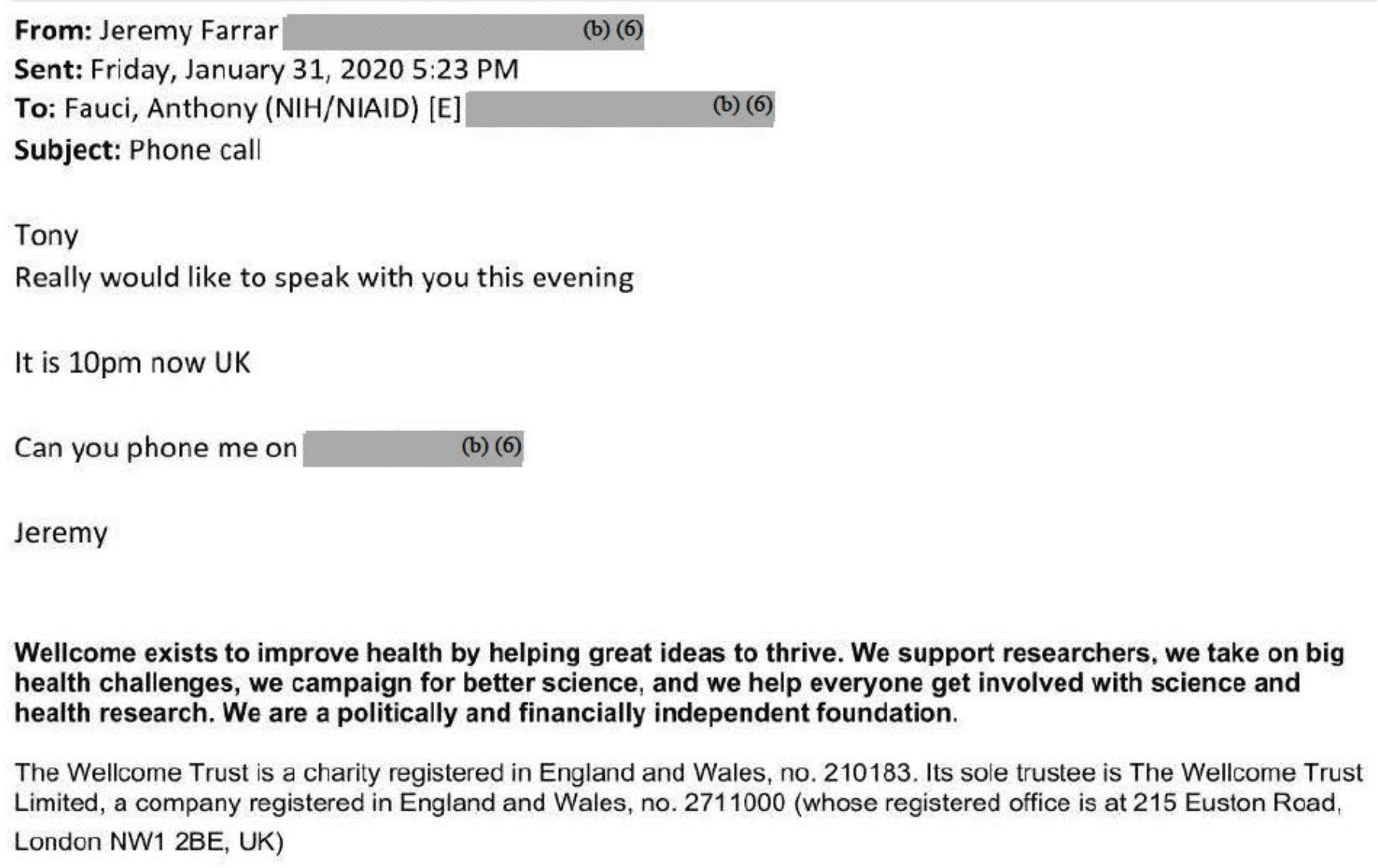
Farrar then told Fauci “the people involved” included three top virologists: Andersen, Garry and Holmes.
Fauci and Andersen also spoke privately.
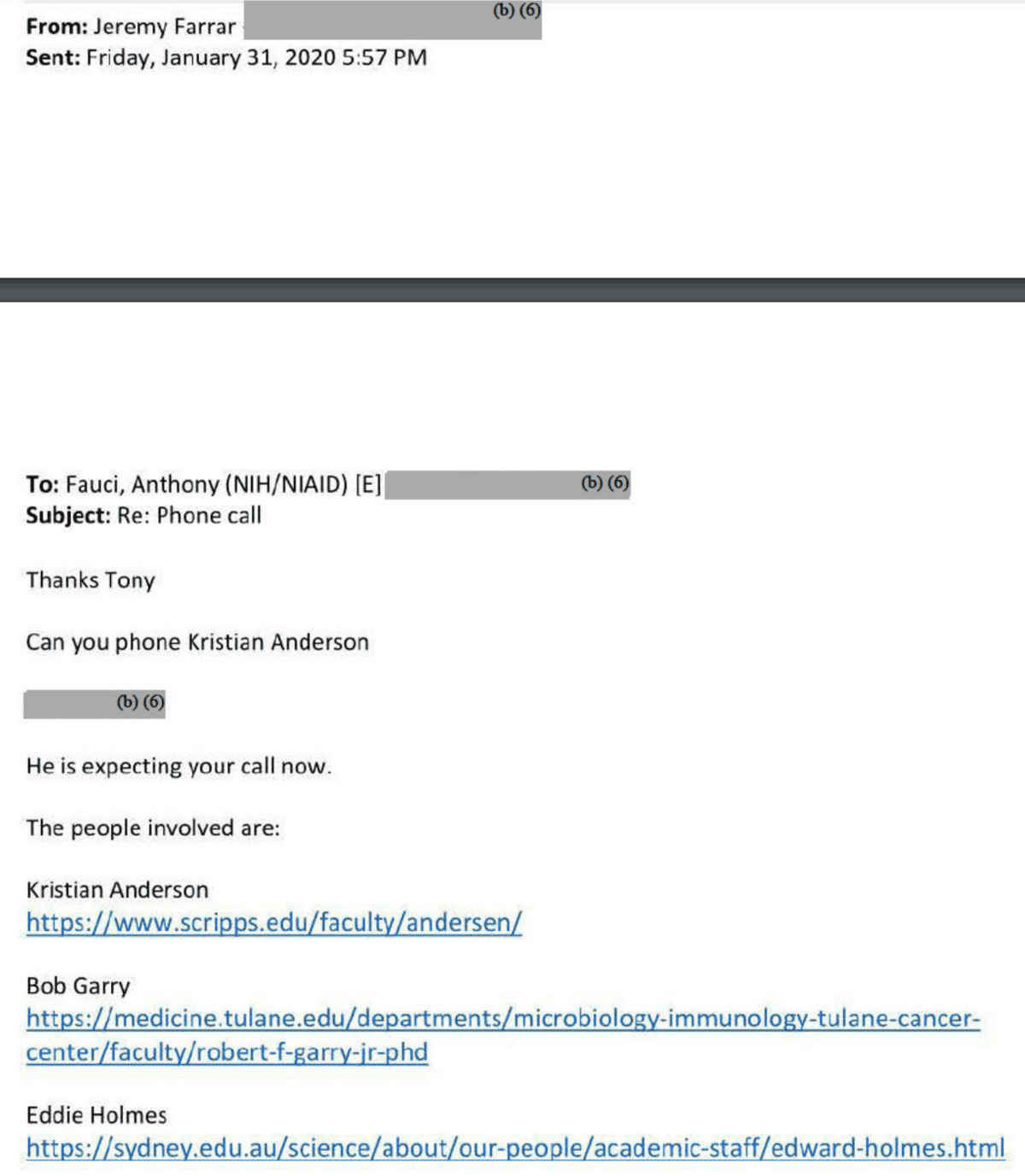
8:43 p.m.
Science Magazine published the article “Mining coronavirus genomes for clues to the outbreak’s origins” by staff writer Jon Cohen. The article quoted Holmes, Andersen and Rutgers Board of Governors Professor Richard Ebright, who told Cohen he had concerns about a new maximum biocontainment lab called the Wuhan Institute of Virology.
Fauci forwarded the article to Farrar and Andersen.
“It is of interest to the current discussion,” he wrote.
10:32 p.m.
Andersen wrote back to Fauci.
While SARS-CoV-2 fits within the family tree of bat coronaviruses, that doesn’t illustrate whether it has been engineered. Indeed, the virus looks unnatural to Andersen and three other virologists, he wrote.
“You have to look very closely at the genome to see features that are potentially engineered… I should mention that after discussions earlier today, Eddie, Bob, Mike, and myself all find the genome to be inconsistent with expectations from evolutionary theory,” he wrote. “We have a good team lined up to look at this, so we should know more by the end of the weekend.”
“Mike” referred to Michael Farzan, chair of the Scripps Research Department of Immunology and Microbiology, who has made key discoveries related to how SARS-CoV infects human cells.
Other members of the “team” looped into early conversations included Garry and Rambaut. Christian Drosten, director of the Institute of Virology at Charité Hospital, also participated in early discussions.
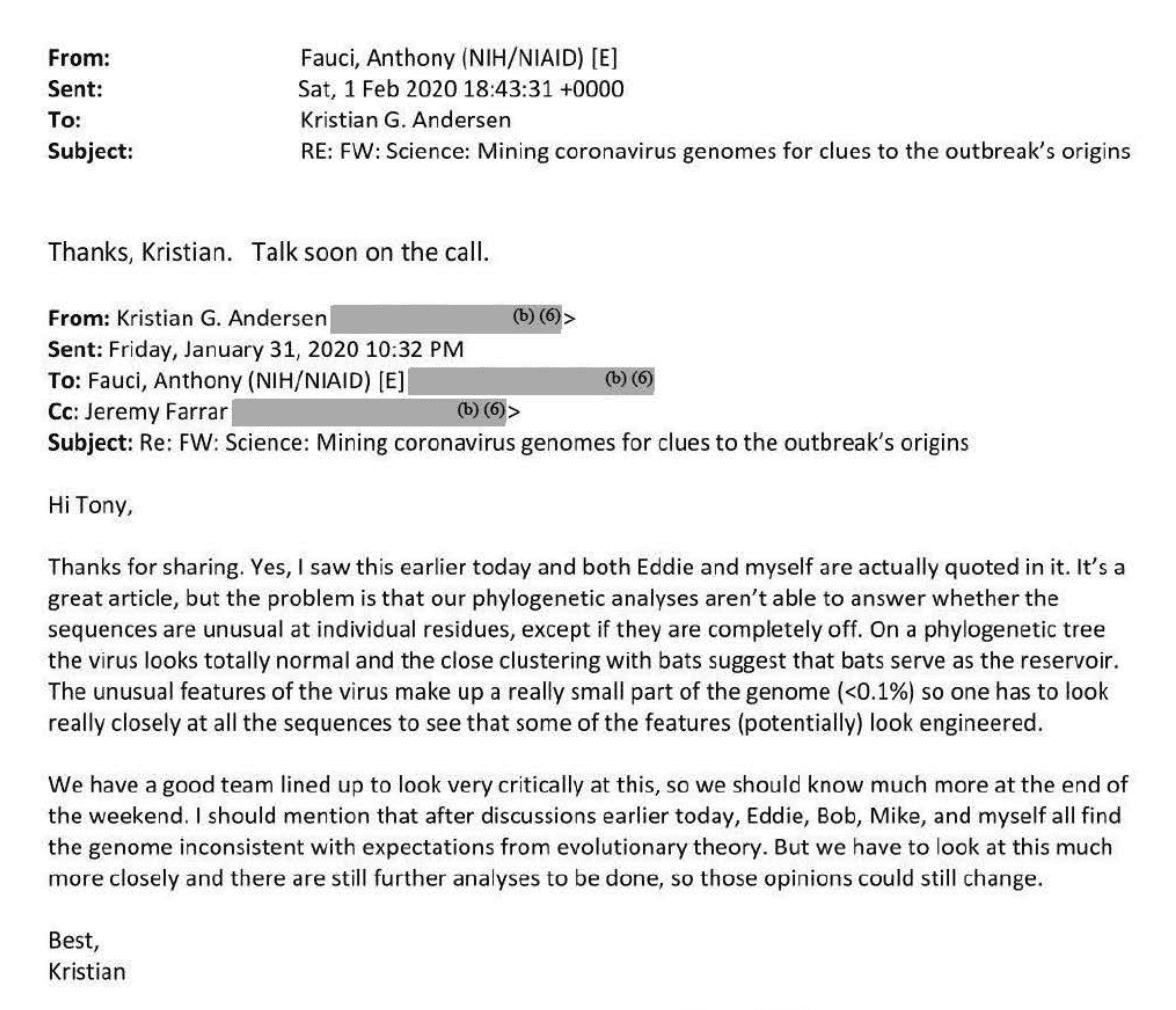
Christian Drosten – deputy coordinator for emerging infections at Charité Hospital and a prominent pandemic response figure dubbed “Germany’s Fauci” – was also on the call, according to the emails.
However, Drosten had a connection to the virus hunters with EcoHealth Alliance. Drosten had once been named as among the partners of PREDICT. PREDICT was a decade-long project uncovering animal viruses and studying them in the lab that concluded in 2020.
Drosten was listed as a member of the “PREDICT Consortium” in a 2014 paper.
PREDICT was a decade-long U.S. Agency for International Development “virus hunting” project co-led by EcoHealth Alliance that ended in 2020.
Drosten had also hunted for bat viruses in Germany, Bulgaria, Ghana and South Africa, according to news reports and scientific papers.
Drosten did not return requests for comment.
The “team” also sought the advice of a proponent of gain-of-function research, Erasmus MC virologist Ron Fouchier, and Erasmus MC Department of Viroscience Director Marion Koopmans.
Fauci spoke with Farrar, then with Andersen.
February 1, 2020: The teleconference
12:29 a.m.
“IMPORTANT,” Fauci wrote in the subject line of an email to an aide a little after midnight — about two hours after Andersen told him the genome may not have evolved naturally.
“Hugh: It is essential that we speak this AM. Keep your cell phone on,” he wrote.
He instructed Hugh Auchincloss, NIAID principal deputy director, to read the attached paper and added an urgent instruction: “You will have tasks today that must be done.”
The attached paper was likely a 2015 Nature paper titled “A SARS-like cluster of circulating bat coronaviruses shows potential for human emergence,” a study NIH had funded through a grant to EcoHealth Alliance — which Fauci had been alerted to in “talking points” on Jan. 27.
The file name included the phrase “SARS Gain of function.”
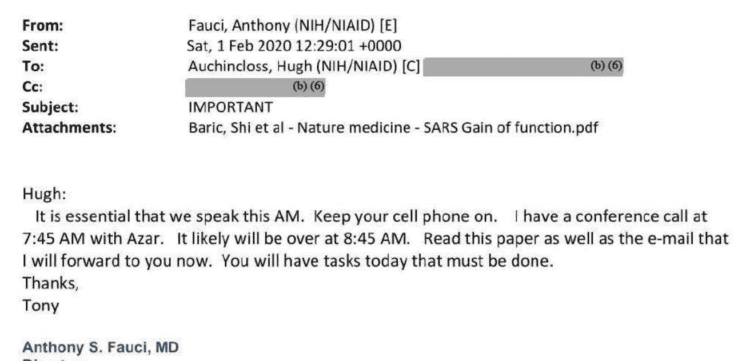
The paper shows that a team co-led by Baric and Shi had spliced the spike protein of one coronavirus into a SARS-CoV backbone. The authors wrote that future experimentation on these viruses “may be too risky to pursue.”
The paper is also one of multiple papers coauthored by Baric and Shi included in Andersen and Holmes’ presentation to a group of assembled virologists on Feb. 1, when they voiced concerns about possible engineering.
12:38 a.m.
Fauci called Andersen and told him to huddle with Holmes and other evolutionary biologists to examine Andersen’s concerns about engineering.
“He should do this very quickly and if everyone agrees with this concern, they should report it to the appropriate authorities,” he wrote. “I would imagine that in the USA this would be the FBI and in the UK it would be MI5.”
“It would be important to quickly get confirmation of the cause of this concern by experts in the field of coronaviruses and evolutionary biology,” he wrote.
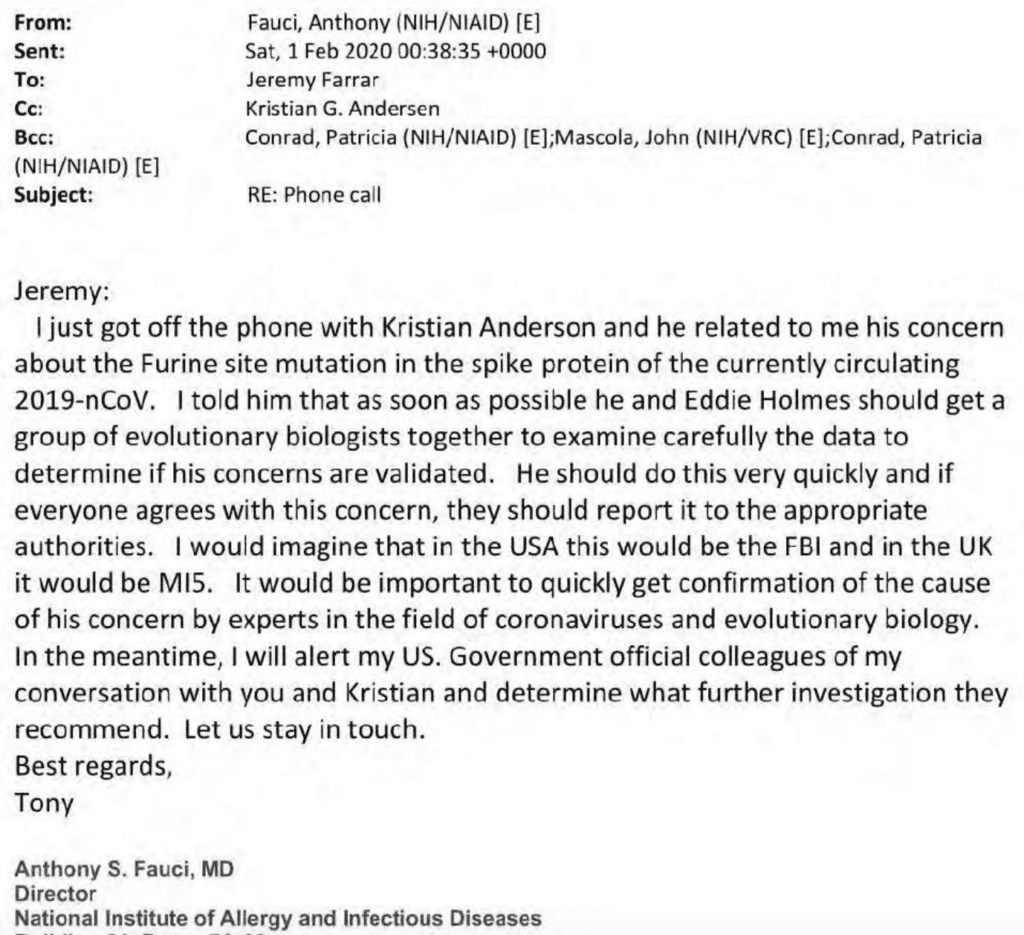
3:48 a.m.
Fauci informs Farrar that Collins will also be on the call.

10:55 a.m.
Farrar invited Fauci to a teleconference later that day.
“My preference is to keep this [a] really tight group,” Farrar wrote. “Obviously ask everyone to keep in total confidence.”
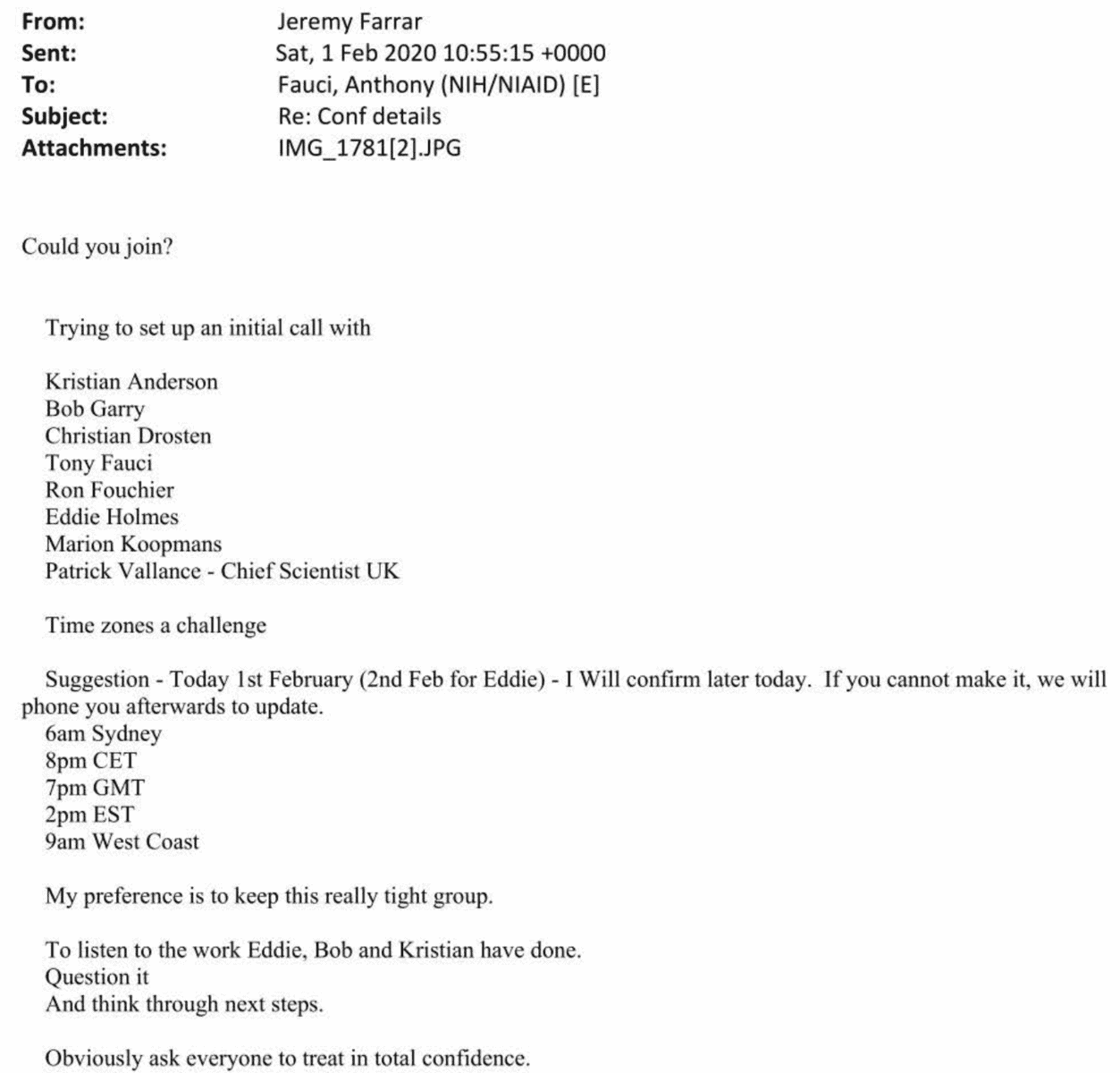
An analysis that framed the February 1, 2020, teleconference was titled “Coronavirus sequence comparison[1].pdf.”
That document shows that the virologists were comparing SARS-CoV-2 with RaTG13, a virus sampled by the Wuhan Institute of Virology that Holmes had previously studied.
That document indicates the following concerns were top of mind: the similarity between RaTG13 and SARS-CoV-2; a high level of mutations around key residues in the receptor binding domain; the furin cleavage site and its absence in SARS, MERS, and other bat coronaviruses; a restriction site commonly used in genetic engineering called BamHI located strategically at the end of the coronavirus’ spike; and the observation that “a ‘gain of function’ in spike reverts to SARS sequence in RBD.” (The slide refers to this paper.)
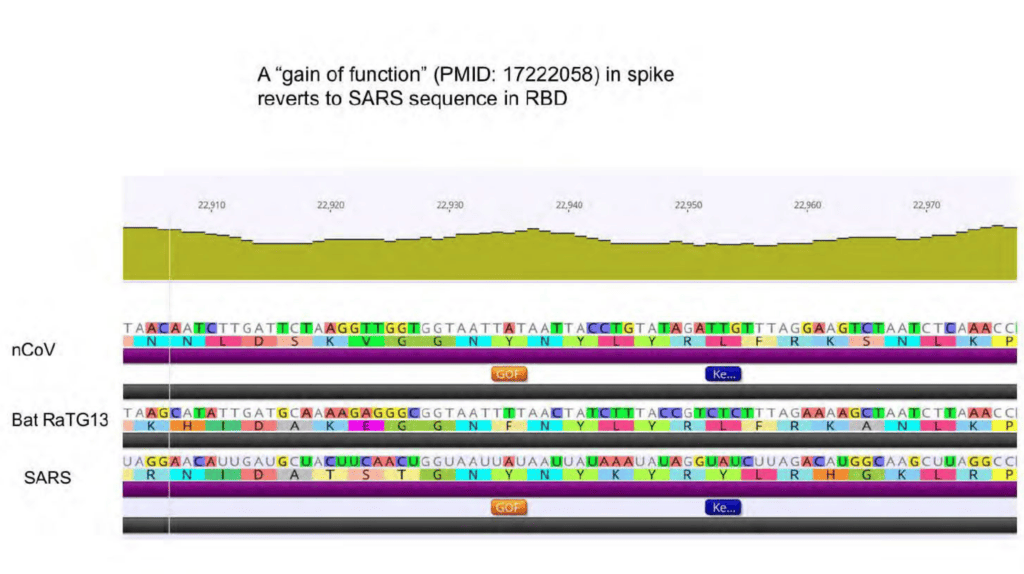
Holmes and Andersen reference six papers, all coauthored by Baric:
- A SARS-like cluster of circulating bat coronaviruses show potential for human emergence
- A mouse-adapted SARS coronavirus causes disease and mortality in BALB/c mice
- SARS-like WIV-1-CoV poised for human emergence
- Modeling pathogenesis of emergent and pre-emergent coronaviruses in mice
- Receptor recognition by novel coronavirus from Wuhan: An analysis based on decade-long structural studies of SARS
- Molecular determinants of severe acute respiratory syndrome coronavirus pathogensis and virulence in young and aged mouse models of human disease
Participants were asked to keep the call confidential until “next steps” are outlined.
11:47 a.m.
Auchincloss reported back to Fauci that the work was reviewed and approved by NIH but apparently had not undergone the “P3 framework,” a reference to regulations put in place to regulate the generation of pandemic potential pathogens after a temporary pause on gain-of-function work on SARS related viruses.
(In fact the research had moved forward in an exception to the gain-of-function pause because NIH did not consider it risky.)
In any case, this NIH aide will investigate “if we have any distant ties to this work abroad,” Auchincloss says.
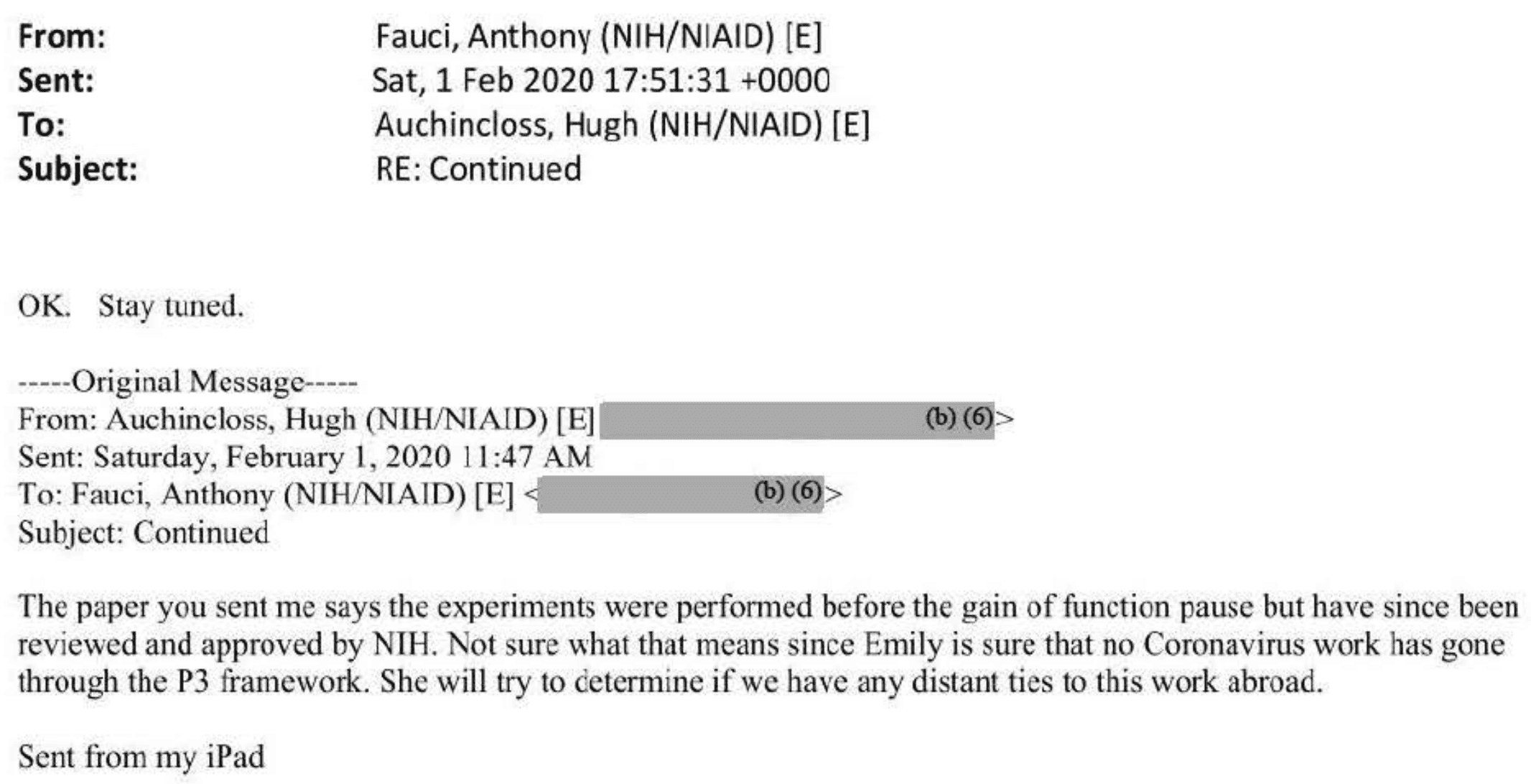
11:48 a.m.
Collins sent a recent preprint by Shi to Fauci. The preprint shared between NIH’s leaders described several coronaviruses, including RaTG13.
“No evidence this work was supported by NIH,” Collins wrote.
“I did see it, but did not check the similarities. Obviously we need more details,” Fauci wrote back.
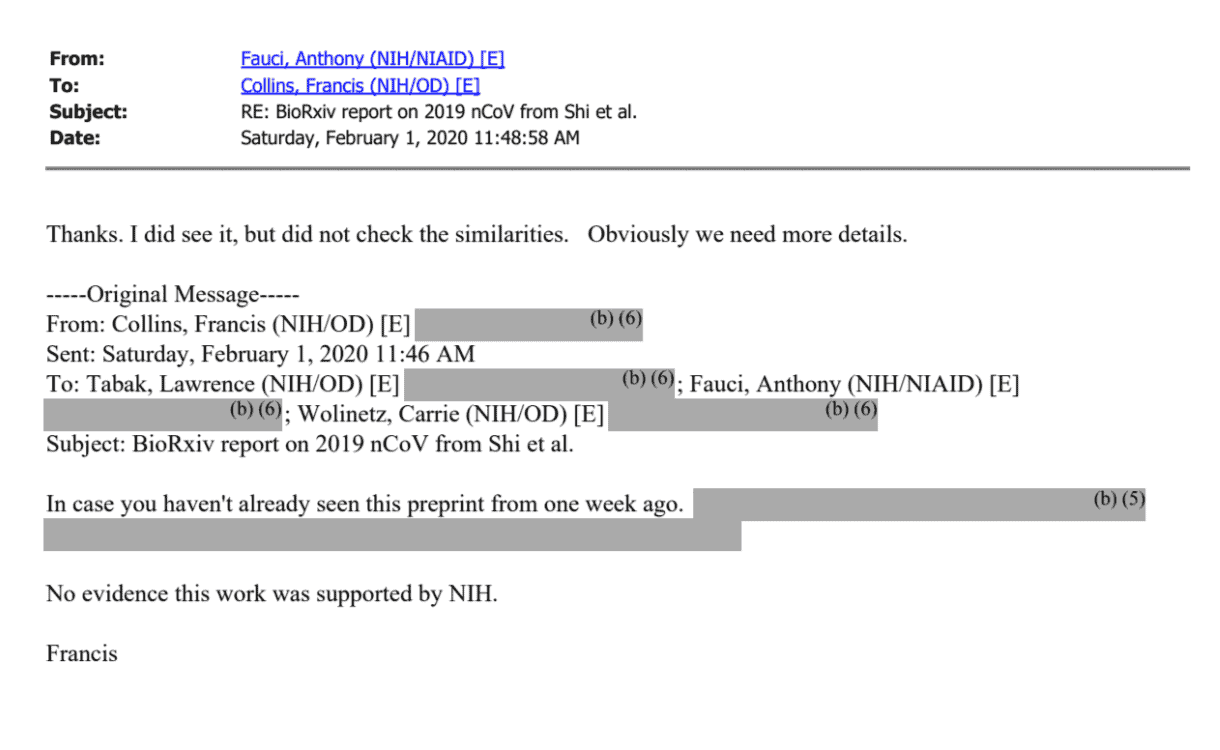
Any ties between the Wuhan Institute of Virology’s work on coronaviruses and NIH were apparently top of mind for Fauci and Collins just two hours before they conferred with the authors of the “proximal origin” paper.
2 p.m.
Collins and Fauci joined the teleconference at 2 p.m. Washington time (7 p.m. GMT and 6 a.m. in Sydney) along with Farrar, Andersen and Holmes.
Garry and Rambaut were invited by Andersen and Holmes.
Others on the call included: Vallance; Fouchier; Koopmans; Drosten; Stefan Pohlmann, a virologist at the German Primate Centre in Gottingen; Mike Ferguson, Wellcome’s deputy chair and a biochemist; Paul Schreier, also from Wellcome. Lawrence Tabak, a top aide to Collins who would later becoming Acting Director of NIH, may have also been present, according to one email.
Despite his appeals both to Fauci and Farrar, Redfield is left out of the teleconference.
Andersen presented slides to the group, with Holmes providing some input. A discussion follows.
Virologists on the call insist the NIH grantmakers did not seek to spin the science.
“Tony Fauci says very little. Francis Collins says even less,” Holmes recounted emphatically. “Their behavior was completely impeccable.”
Gain-of-function research practitioners were clearly influential, however.
Fouchier — who ignited a debate about gain-of-function research when he altered the highly lethal H5N1 virus to be airborne between ferrets — was among the first to voice the argument that would become central to the paper, according to Holmes.
“People like Ron very correctly point out that if you were going to do this … you would use a standard lab background, and this is not a standard lab background,” Holmes said. “They gave a whole set of very cogent points about what you would do if you were going to do this.”
Drosten and Koopmans, Fouchier’s boss, both agreed, Farrar recollected.
“The conference call finished and the conclusion was that we should write something up, a sort of summary statement,” Holmes said.
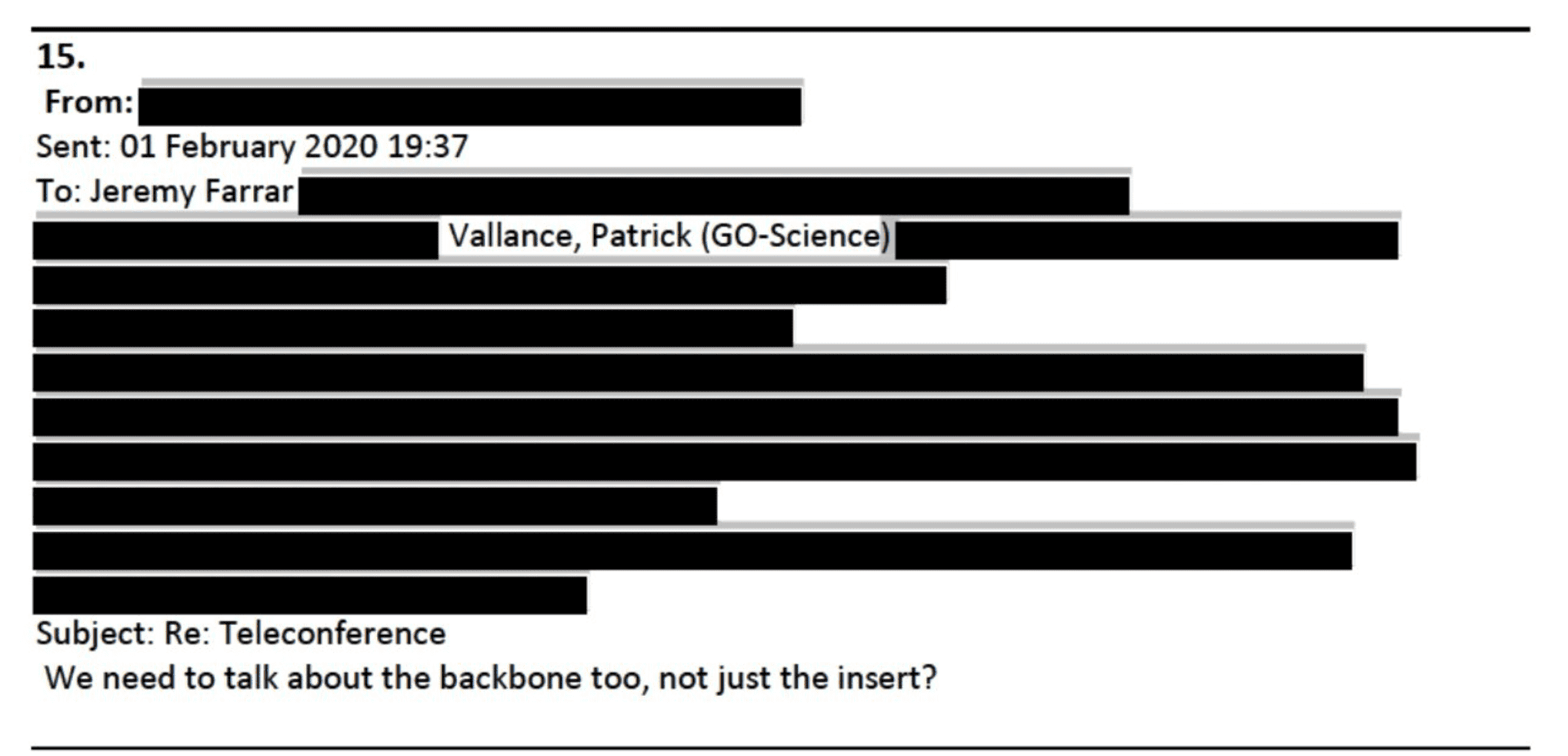
In an email sent after the call, one of the virologists referred to a viral “backbone” and “insert.”
After the call, Holmes was 80 percent sure the novel coronavirus had a lab origin, while Andersen favored a lab origin by about 60 to 70 percent, according Farrar’s memoir.
“Andrew and Bob were not far behind. I, too, was going to have to be persuaded that things were not as sinister as they seemed,” Farrar wrote.
Andersen would later say he was intimidated by the idea of breaking the news to the world that the virus may be engineered.
“I was battling with the idea that, having raised the alarm, I might end up being the person who proved this new virus came from a lab,” he told Farrar. “And I didn’t necessarily want to be that person.”
9:59 p.m.
Farrar thanks everyone for joining the call, and reiterates his desire to convene credible scientists to work with the WHO to help shape the discussion in light of growing concern about a lab leak on Twitter and WeChat, a Chinese social media platform, and “in order to stay ahead of the conspiracy theories.”
Farrar emphasizes framing that does not explicitly mention the elephant in the room — whether the pandemic emanated from a lab — but also reads as “neutral.”
“I do not believe this is a question of a binary outcome,” he wrote.
He suggested the framing of the debate be the following question: “What are the evolutionary origins of 2019-nCoV?”
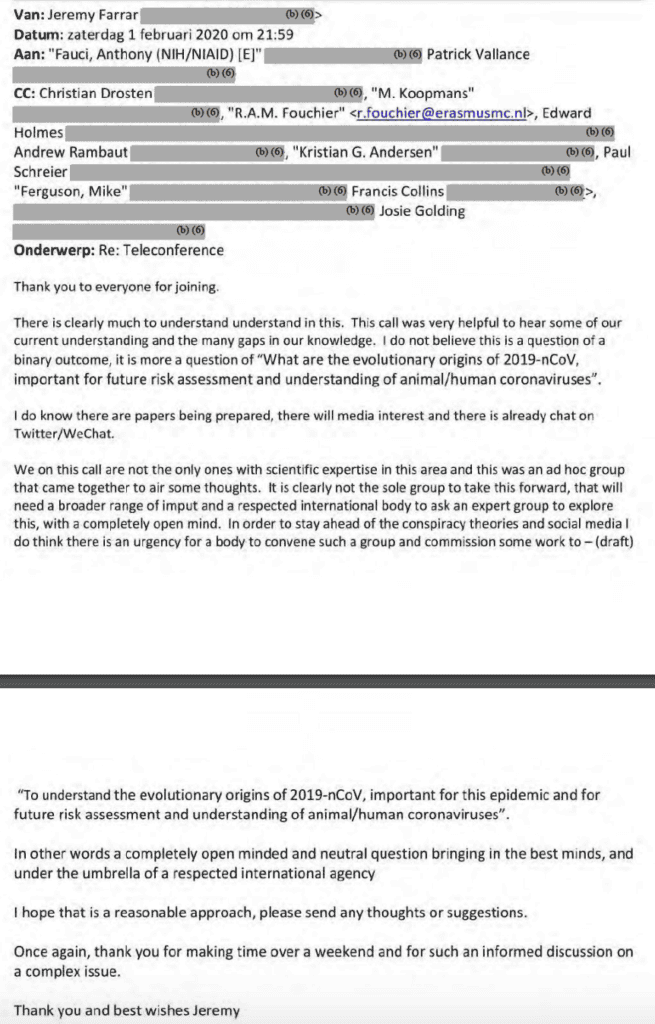
7:43 p.m.
Koopmans appears to share thoughts about the pangolin coronavirus sequences and the furin cleavage site.
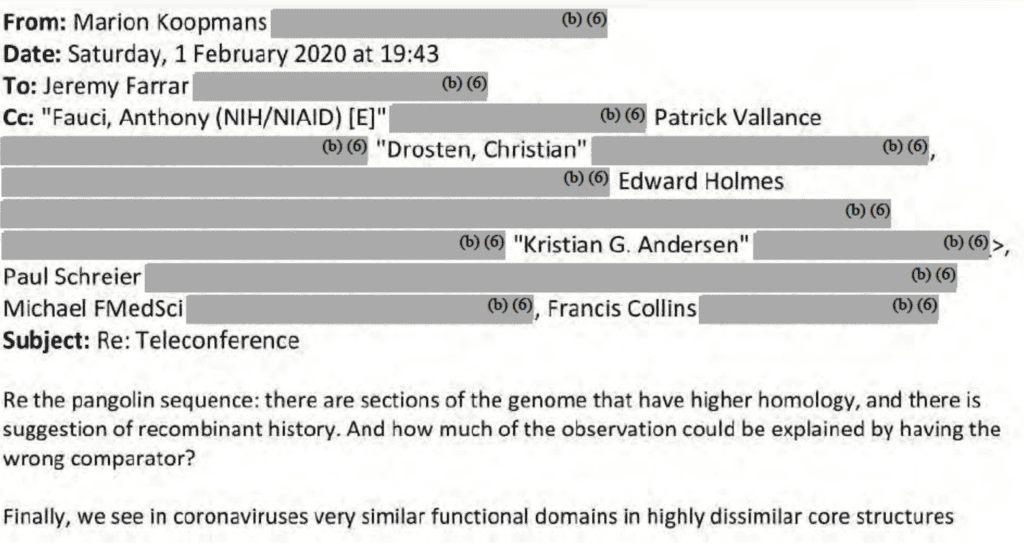
February 2, 2020: ‘There are possible ways in nature, but highly unlikely’
4:48 a.m.
Farrar tells the virologists who participated on the call that scientific discussion should be limited to a credible group convened by the WHO.
“I suggest we don’t get into further scientific discussion here, but wait for that group to be establish,” Farrar said.
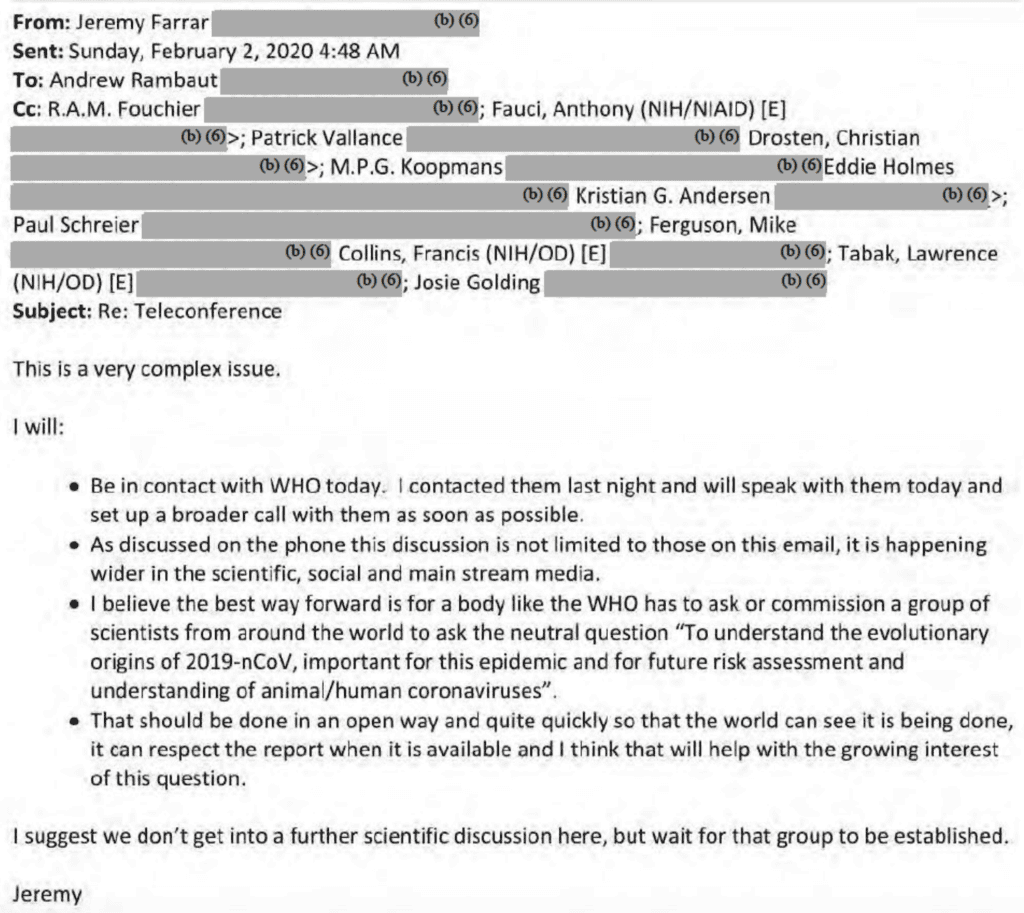
6:53 a.m.
After the call, Farrar collected some thoughts from the group and emailed Fauci and Collins.
“On a spectrum if 0 is nature and 100 is release – I am honestly at 50! My guess is that this will remain grey, unless there is access to the Wuhan lab – and I suspect that is unlikely!” Farrar said.

He requests their help in pressuring the WHO to take up the question of the pandemic’s origins before the narrative gets out of hand. He worries the WHO could wait a month, which may be too late.
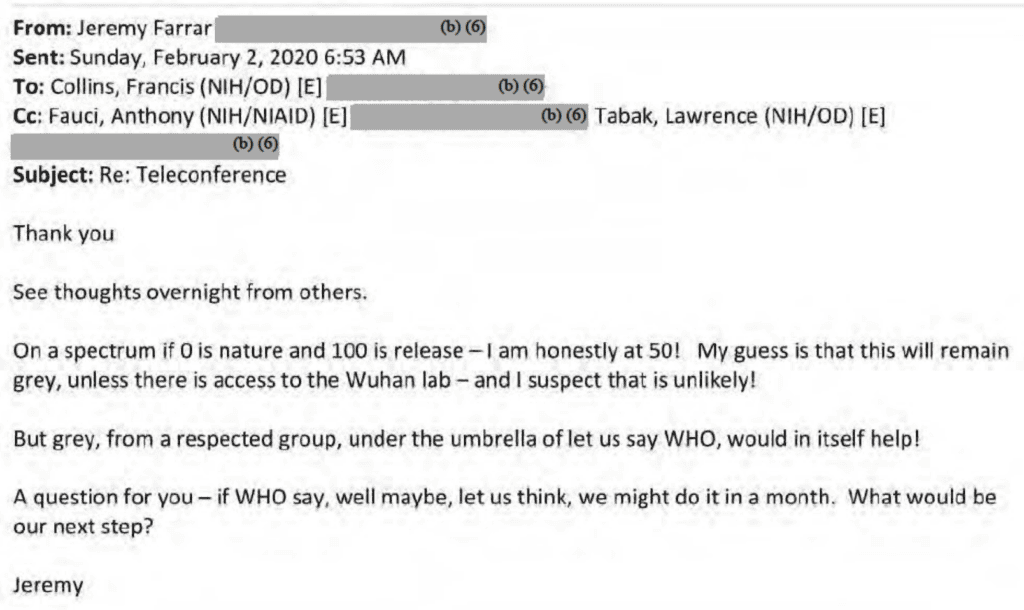
Farrar also relayed more thoughts from participants on the call to Fauci and Collins. These emails, first obtained through FOIA by BuzzFeed News, were viewed un-redacted by congressional staff in camera and reported by The Intercept.
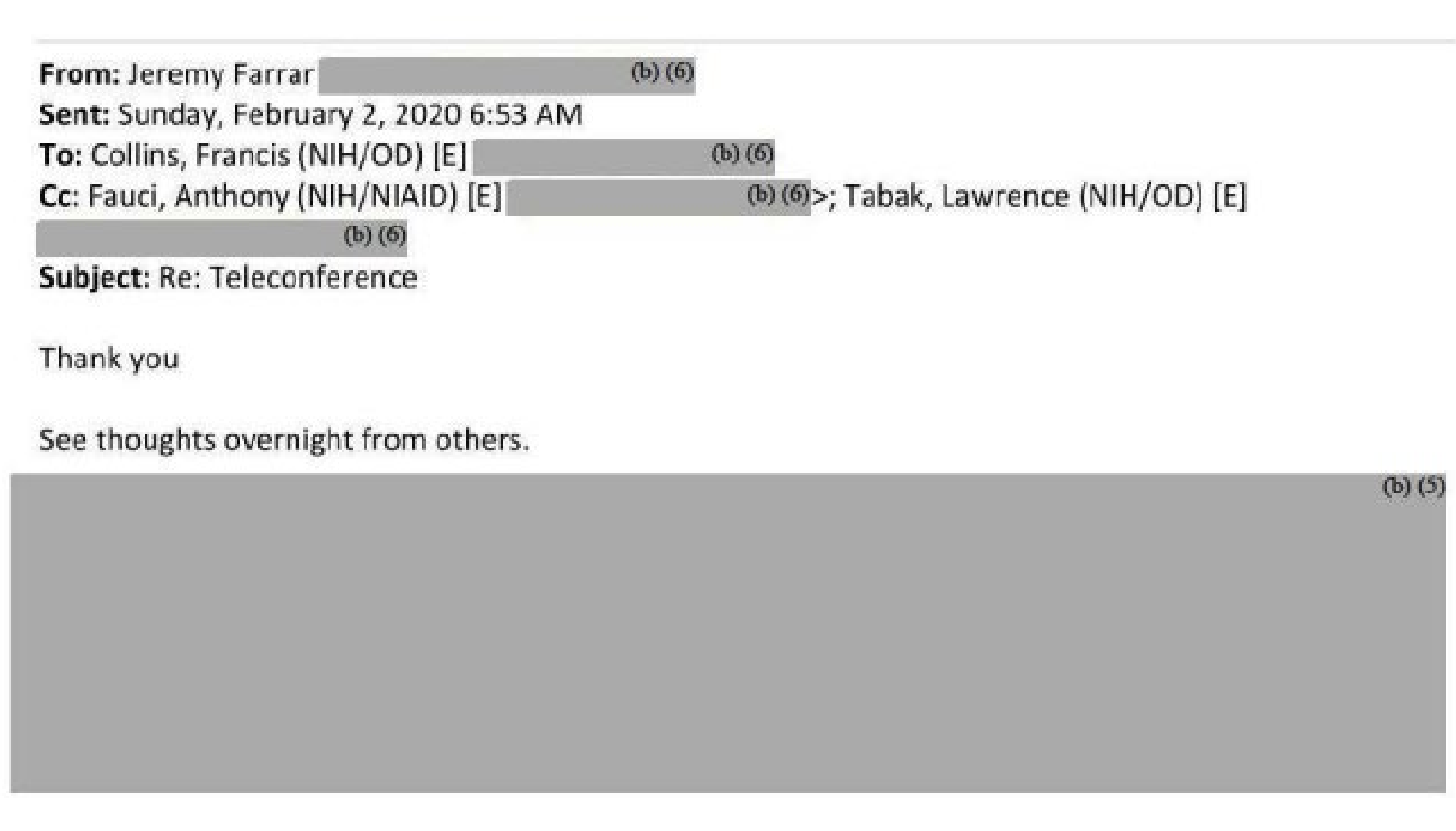
“From Mike Farzan (discoverer of SARS receptor):
- The RBD didn’t look ‘engineered’ to him – as in, no human would have selected the individual mutations and cloned them into the RBD (I think we all agree)
- Tissue culture passage can often lead to gain of basic sites – including furin cleavage sites (this is stuff they have seen with human coronaviruses)
- He is bothered by the furin site and has a hard time explain that as an event outside the lab (though, there are possible ways in nature, but highly unlikely)
- Instead of directed engineering, changes in the RBD and acquisition of the furin site would be highly compatible with the idea of continued passage of virus in tissue culture
- Acquisition of the furin site would likely destabilize the virus but would make it disseminate to new tissues.
So, given above, a likely explanation could be something as simple as passage SARS-live CoVs in tissue culture on human cell lines (under BSL-2) for an extended period of time, accidentally creating a virus that would be primed for rapid transmission between humans via gain of furin site (from tissue culture) and adaption to human ACE2 receptor via repeated passage.
…So, I think it becomes a question of how do you put all this together, whether you believe in this series of coincidences, what you know of the lab in Wuhan, how much could be in nature – accidental release or natural event? I am 70:30 or 60:40.”
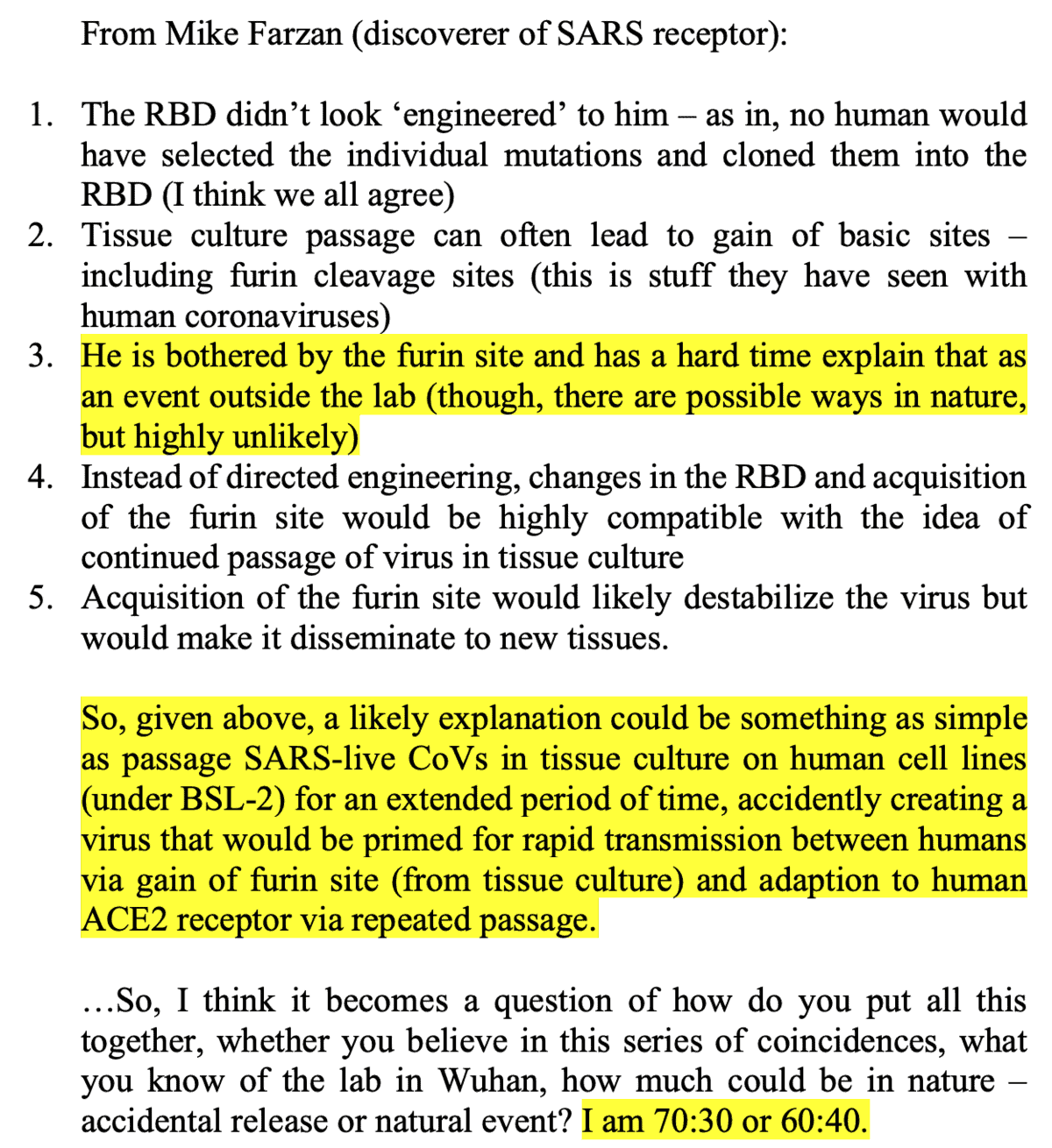
“You were doing gain of function research you would NOT use an existing close [clone] of SARS or MERSv. These viruses are already human pathogens. What you would do is close a bat virus th[at] had not yet emerged,” Garry said.
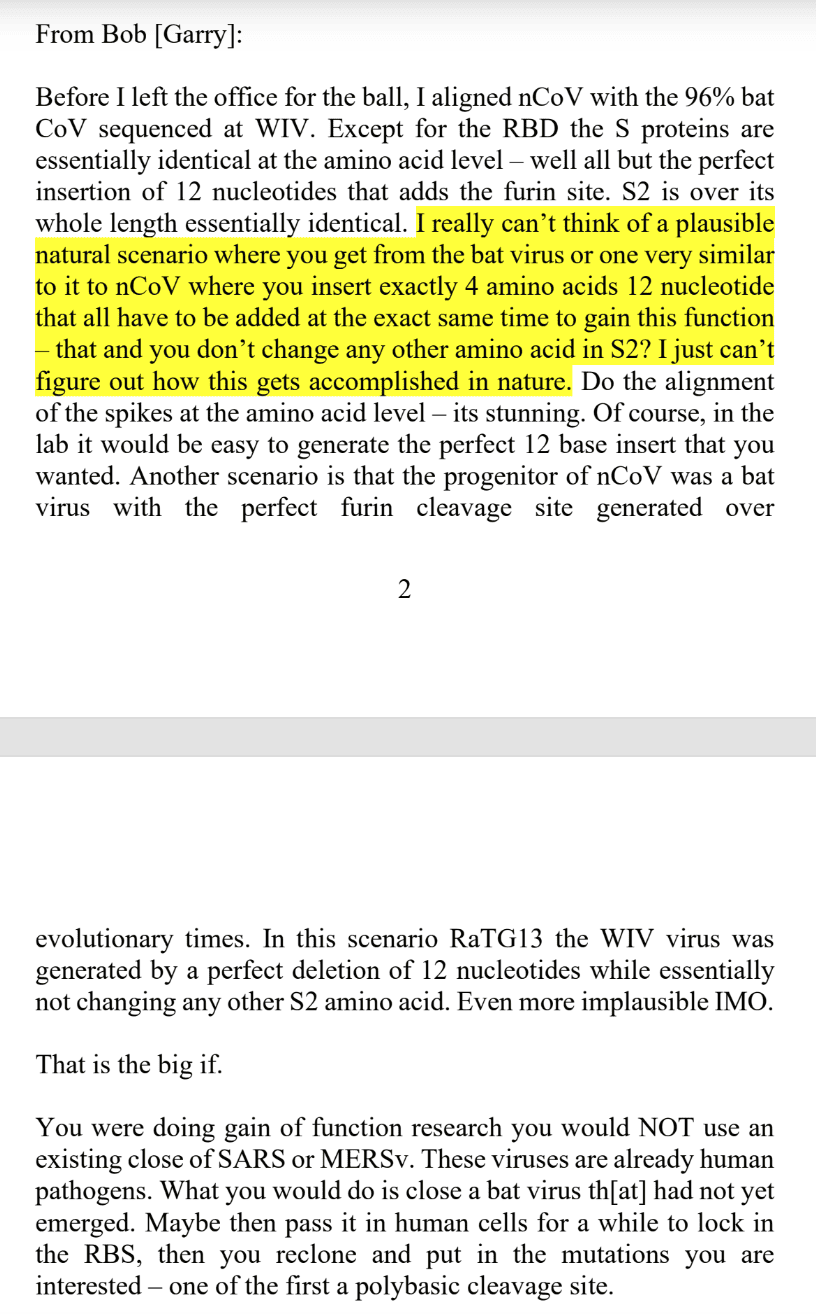
“Before I left the office for the ball, I aligned nCoV with the 96% bat CoV sequenced at WIV. Except for the RBD the S proteins are essentially identical at the amino acid level – well all but the perfect insertion of 12 nucleotides that adds the furin site. S2 is over its whole length essentially identical. I really can’t think of a plausible natural scenario where you get from the bat virus or one very similar to it to nCoV where you insert exactly 4 amino acids 12 nucleotide that all have to be added at the exact same time to gain this function – that and you don’t change any other amino acid in S2? I just can’t figure out how this gets accomplished in nature. Do the alignment of the spikes at the amino acid level – its stunning. Of course, in the lab it would be easy to generate the perfect 12 base insert that you wanted. Another scenario is that the progenitor of nCoV was a bat virus with the perfect furin cleavage site generated over 3 evolutionary times. In this scenario RaTG13 the WIV virus was generated by a perfect deletion of 12 nucleotides while essentially not changing any other S2 amino acid. Even more implausible IMO.
That is the big if.
You were doing gain of function research you would NOT use an existing close [clone] of SARS or MERSv. These viruses are already human pathogens. What you would do is close a bat virus th[at] had not yet emerged. Maybe then pass it in human cells for a while to lock in the RBS, then you reclone and put in the mutations you are interested – one of the first a polybasic cleavage site.”
7:13 a.m.
Simultaneously Farrar exchanged emails with Collins and Fauci about convening a group connected to the WHO to weigh in on the lab origins, apparently to get ahead of discussions of engineering, even though that was still on the table for some of the virologists.

8:30 a.m.
Fouchier emailed Farrar, and apparently the other participants on the call, calling for further inquiry. However he also calls the question of the virus’ origin a distraction for the moment, and possibly harmful to science and to China.
“Dear Jeremy and others,
“Thanks for a useful teleconference. Given the evidence presented and the discussions around it, I would conclude that a follow-up discussion on the possible origin of 2019-nCoV would be of much interest. However, I doubt if it needs to be done on very short term, given the importance of other activities of the scientific community, WHO and other stakeholders at present. It is my opinion that a non-natural origin of 2019-nCoV is highly unlikely at present. Any conspiracy theory can be approached with factual information.
… An accusation that nCoV-2019 might have been engineered and released into the environment by humans (accidental or intentional) would need to be supported by strong data, beyond a reasonable doubt. It is good that this possibility was discussed in detail with a team of experts. However, further debate about such accusations would unnecessarily distract top researchers from their active duties and do unnecessary harm to science in general and science in China in particular.”
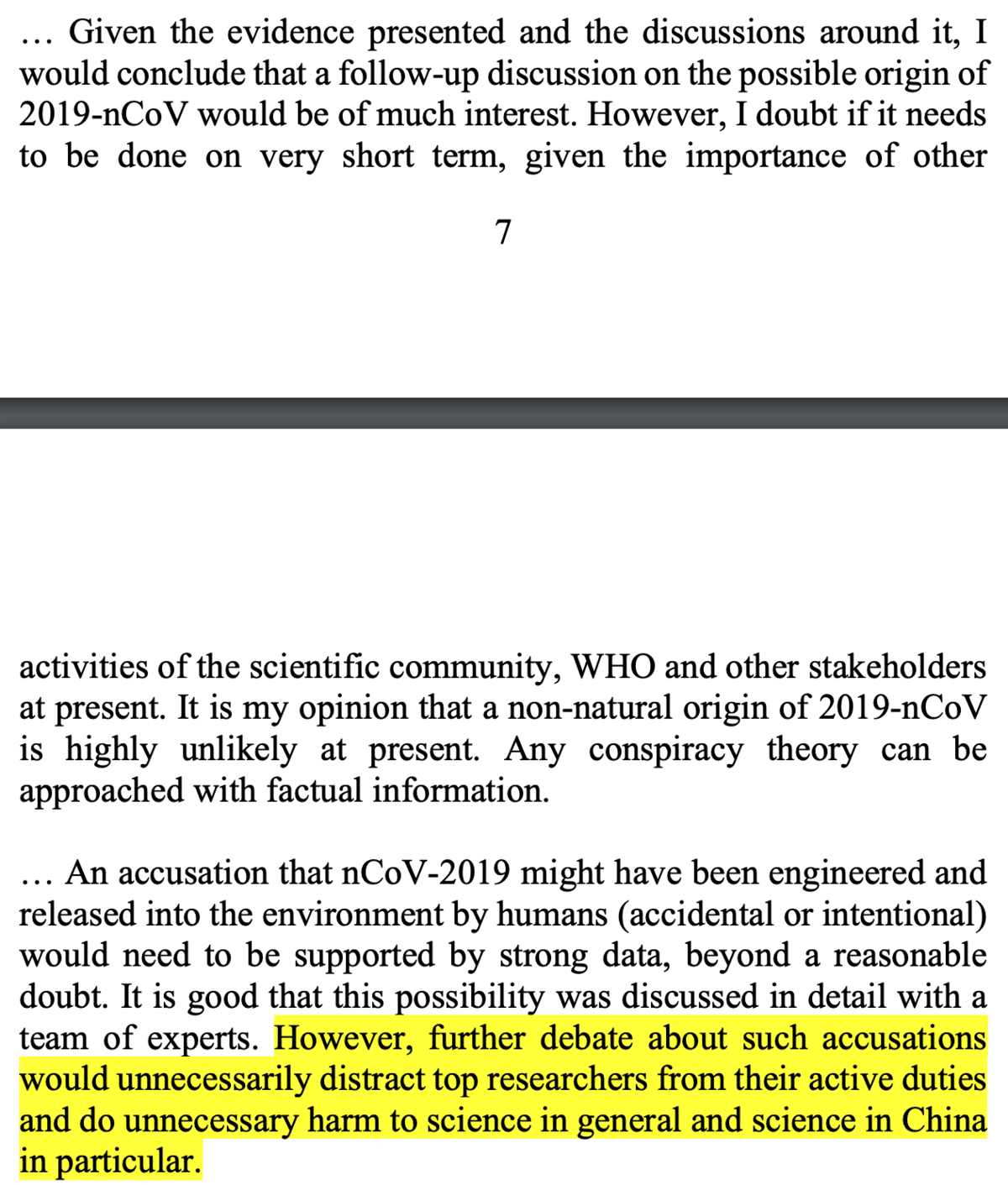
8:30 a.m.
Fouchier shared detailed notes.
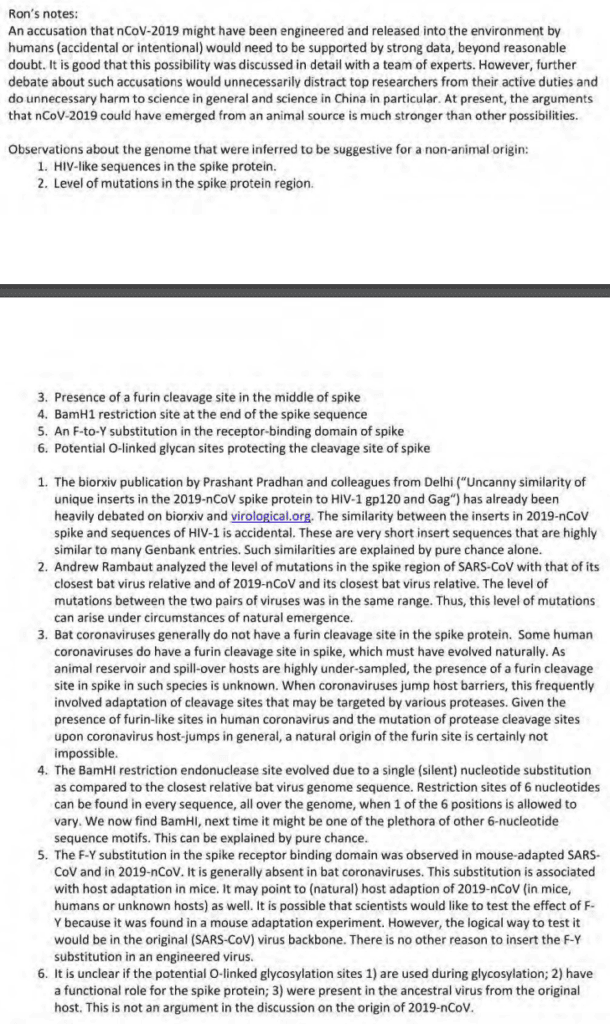
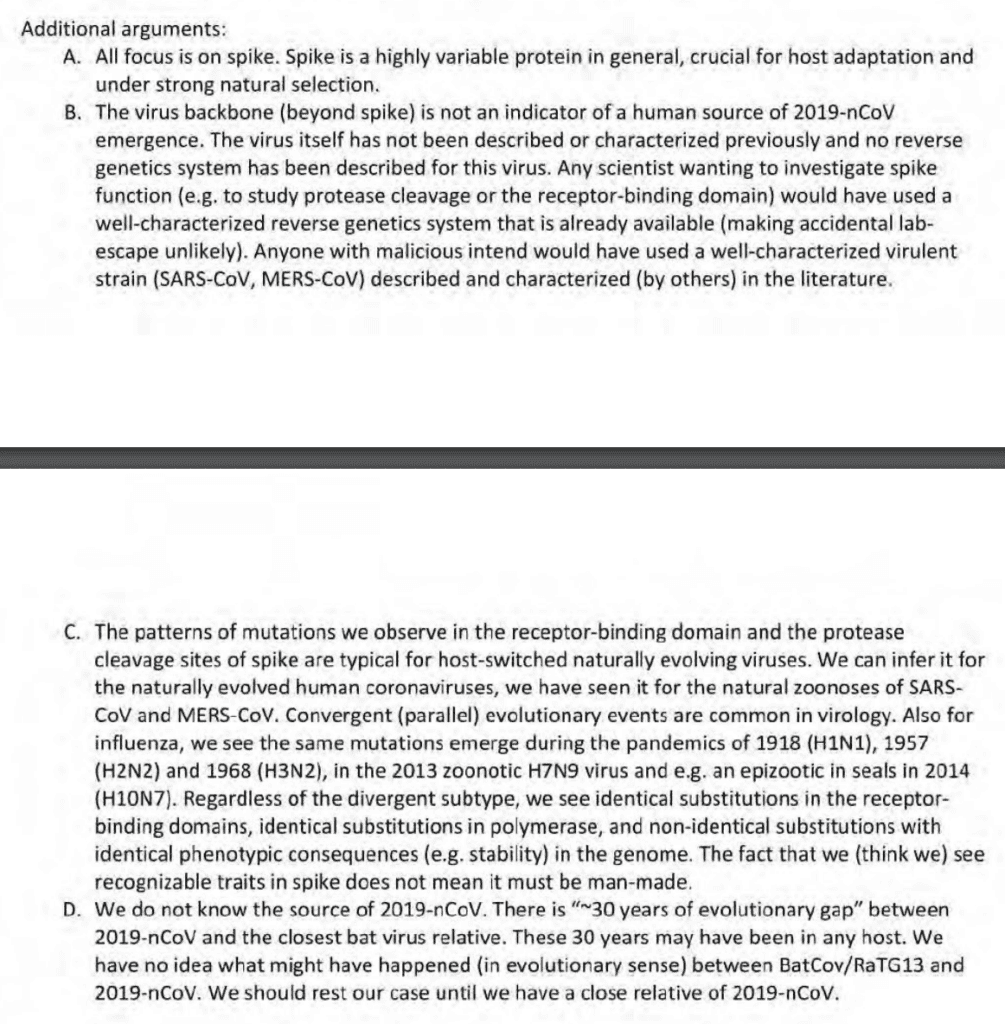
His ideas include ones that became central to the “proximal origin” article.
“Given the presence of furin-like sites in human coronavirus and the mutation of protease cleavage sites upon coronavirus host-jumps in general, a natural origin of the furin site is certainly not impossible,” Fouchier wrote.
Fouchier also wrote that a bioweapon would involve a familiar “backbone” known to cause human infection such as SARS or MERS. Benevolent scientists, meanwhile, would use familiar genetic engineering techniques. (Novel genetic engineering techniques underway at the Wuhan Institute of Virology would later be uncovered by an online sleuth.)
Fouchier also notes that SARS-CoV-2 has not been described in the scientific literature. The closest virus known at this point in time was RaTG13, which the virologists believed to be too distantly related to be a progenitor.
Despite his considerable contributions, Fouchier was not credited by the piece’s authors, who would later be accused of plagiarism.
Both Fouchier and Koopmans declined to be credited as coauthors or contributors because they opposed scientific articles considering the lab leak theory at all, Holmes said in a December 2022 interview.
8:40 a.m.
Farrrar replies moments later to emphasize the importance of publishing something credible to downplay “lurid” lab origin theories right away and ensure further cooperation with China.
“If, and I stress if, this does spread further, pressure and tensions rise, j [sic] fear these questions will get louder and more polarised and people will start to look who to blame. … That may only increase tension and reduce cooperation.”
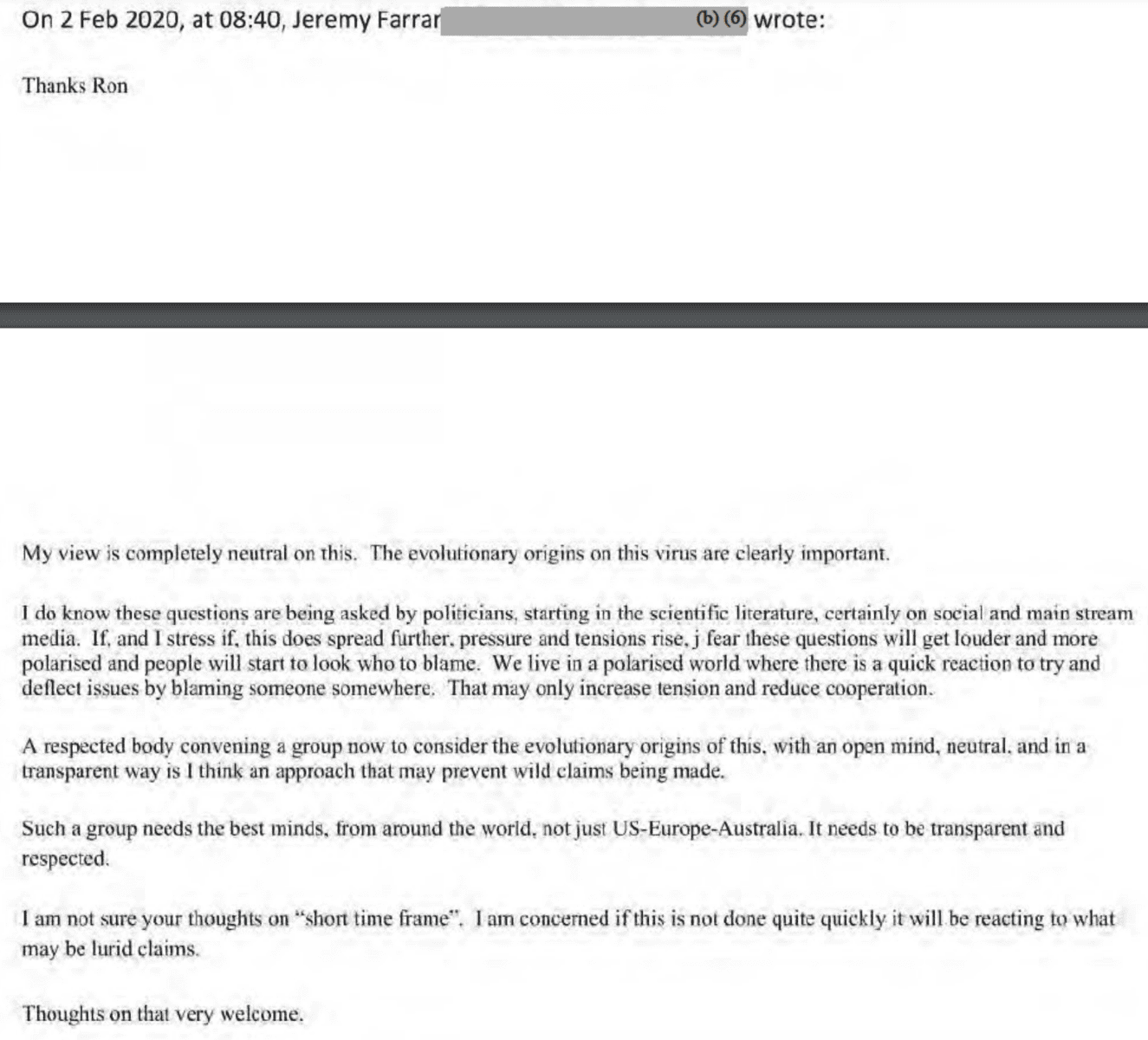
9:38 a.m.
Under the subject line “Re: Teleconference,” Rambaut emails Farrar, Fauci, and the other call’s participants.
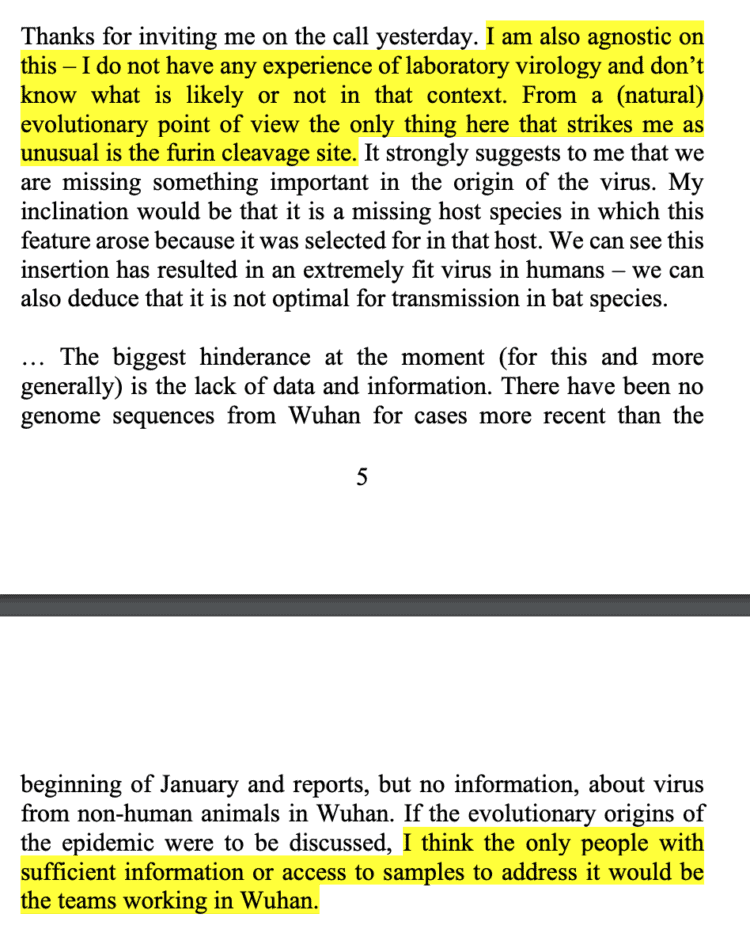
“From a (natural) evolutionary point of view the only thing here that strikes me as unusual is the furin cleavage site,” Rambaut wrote. “It strongly suggests to me that we are missing something important.”
At the same time, Rambaut expressed a desire to dampen social media speculation about the origins.
“Perhaps this needs to be discussed urgently, not only because of the lurid claims on Twitter but because if it is in a non-human host, pre-adapted, it may threaten control efforts through new zoonotic jumps,” he added.
10:27 a.m.
Collins emailed Farrar, Fauci, and NIH official Lawrence Tabak, raising concerns about the “potential harm to science and international harmony” a lab origin of COVID-19 could pose.
“Though the arguments from Ron Fouchier and Christian Drosten are presented with more forcefulness than necessary, I am coming around to the view that a natural origin is more likely. But I share your view that a swift convening of experts in a confidence inspiring framework (WHO seems really the only option) is needed, or the voices of conspiracy will quickly dominate, doing great potential harm to science and international harmony.
I’m available any time today except 3:15 – 5:45 pm EST (on a plane) for a call to Tedros. Let me know if I can help get through his thicket of protectors.”
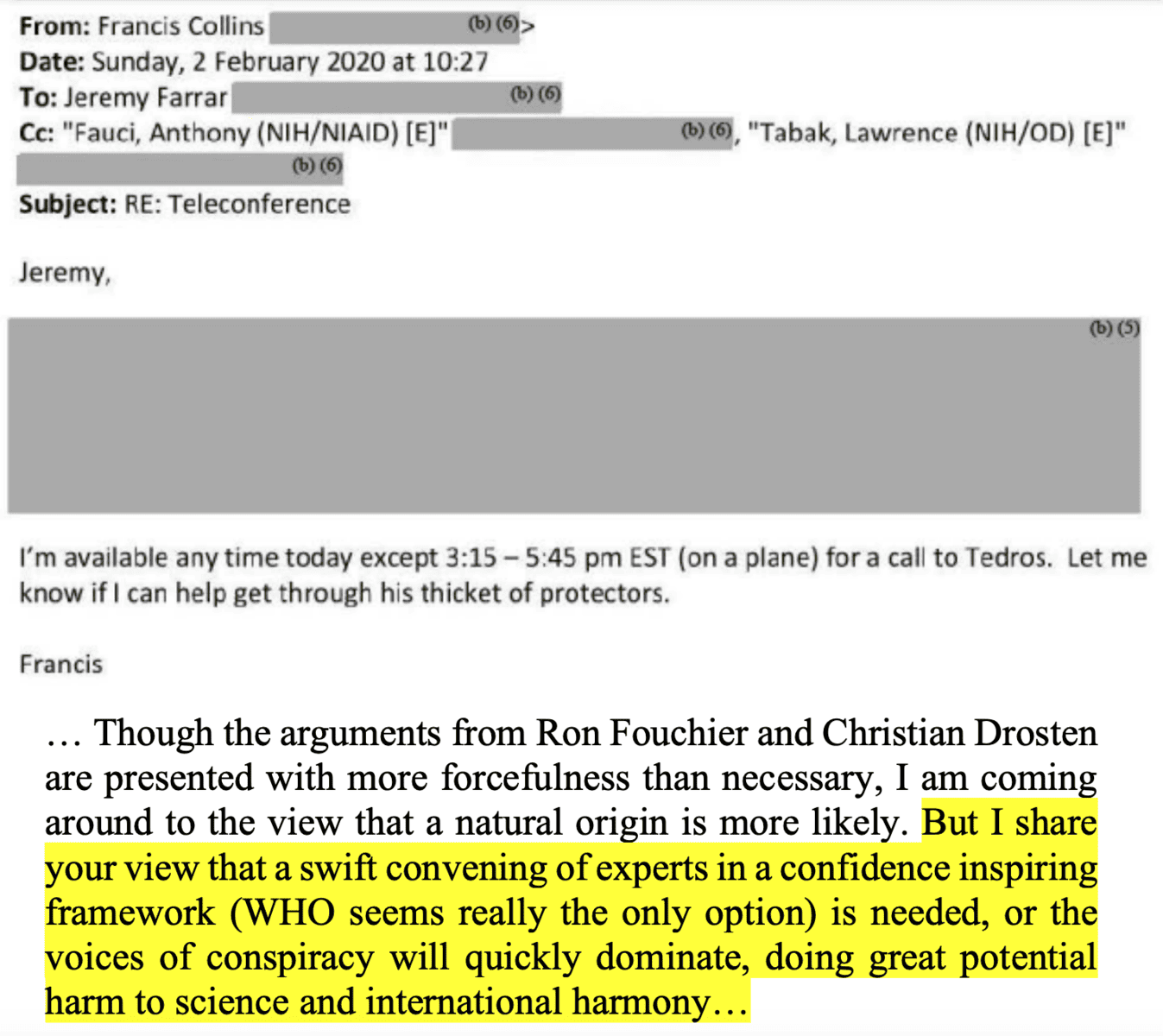
11:28 a.m.
Farrar updated Collins and Fauci on his efforts to pressure the WHO, linking to an article about a conspiracy theory about SARS-CoV-2 resembling HIV.
“Tedros and Bernard have apparently gone into conclave….they need to decide today in my view. If they do prevaricate, I would appreciate a call with you later tonight or tomorrow to think how we might take forward.
Meanwhile…..
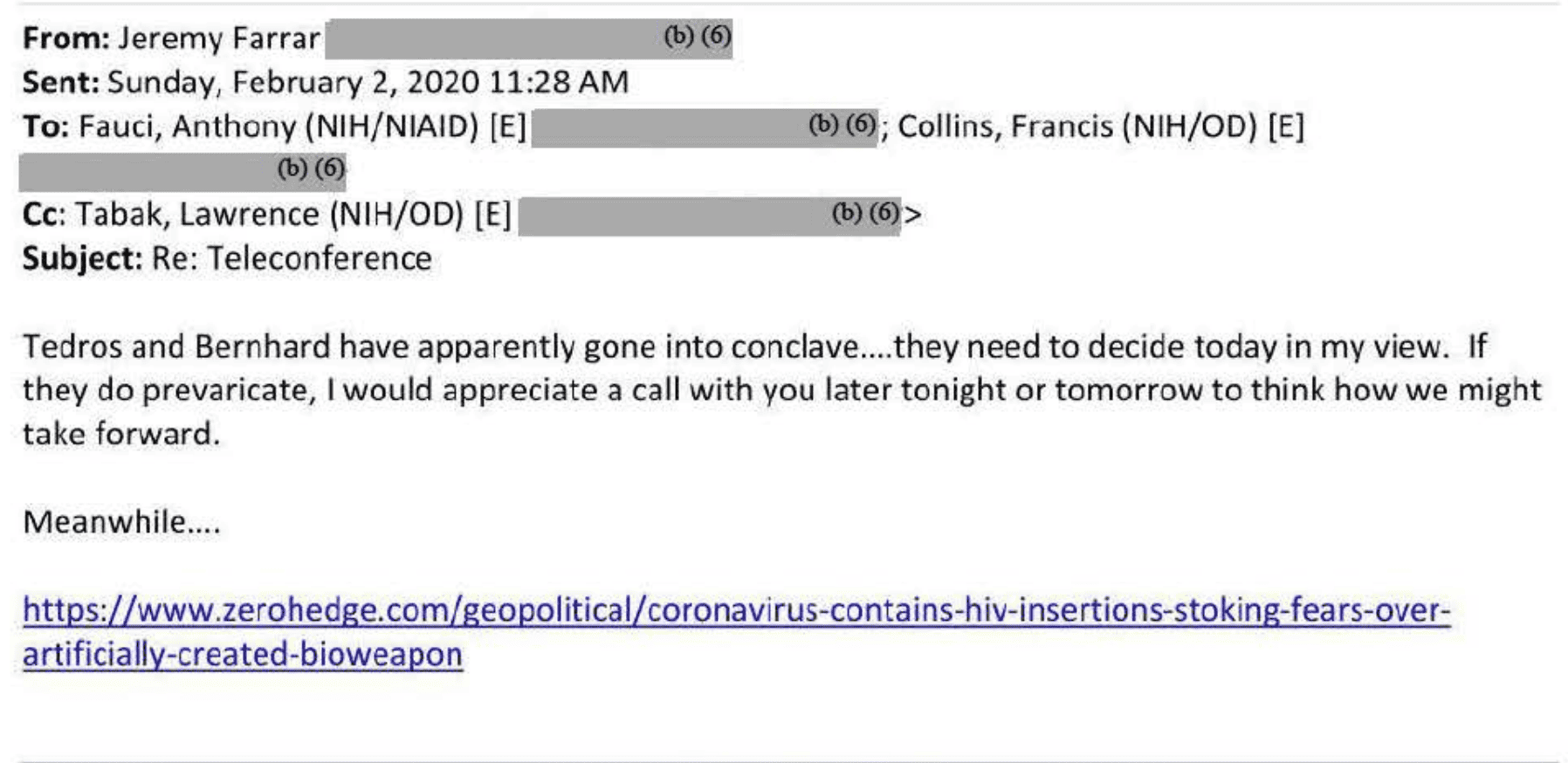
12:03 p.m.
Collins acknowledges that serial passage is a possibility, and worth including in the public list of possibilities (it would not be seriously considered in the final draft). Collins adds that the suggestion to put off a discussion of the origin of the pandemic for even a month “sounds like a really bad idea.”
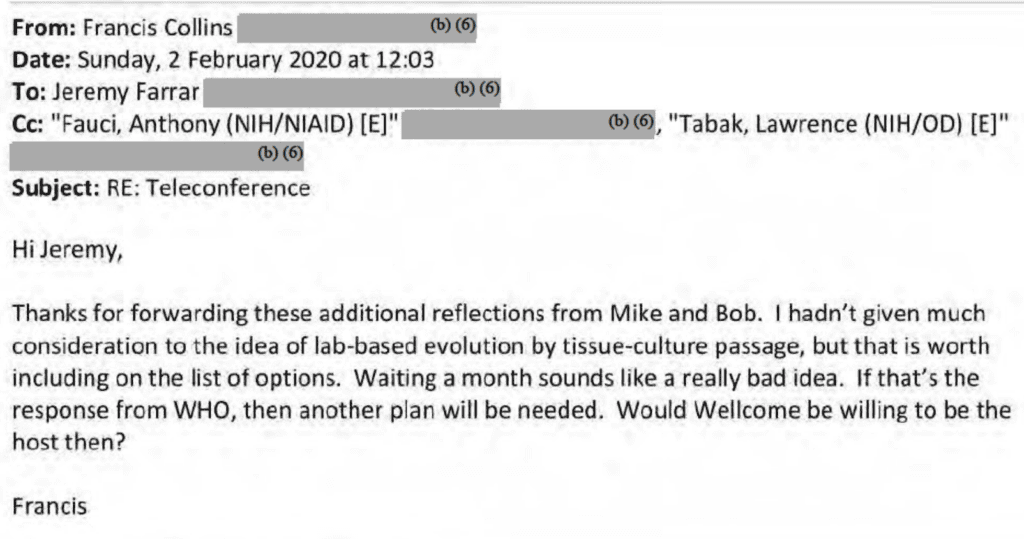
1:57 p.m. (approximate)
Twitter suspended ZeroHedge — the blog that Farrar had flagged to Fauci and Collins — apparently because of a separate post that shared the contact information of a Chinese scientist. The ban appeared to coincide with an effort by the WHO to work with social media companies to bar “misinformation.”
Twitter said at the time that the company had permanently banned the popular rightwing blog from its platform because of concerns about “doxxing,” in other words, the exposure of a Chinese scientist’s identity.
The Global Engagement Center, an arm of the State Department that combats online “misinformation,”flagged Twitter accounts that tweeted about the blog’s ban. The State Department’s concerns about these posts came to light in a January 2023 report based on Twitter’s internal records.
3:30 p.m.
Fauci agrees that it is “essential to move quickly.”
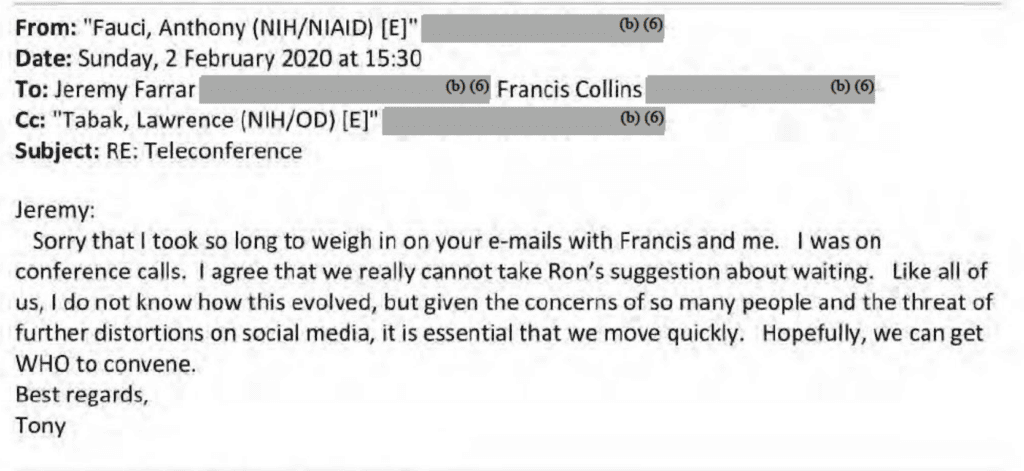
4:49 p.m.
Fauci asked Collins for a private phone call.
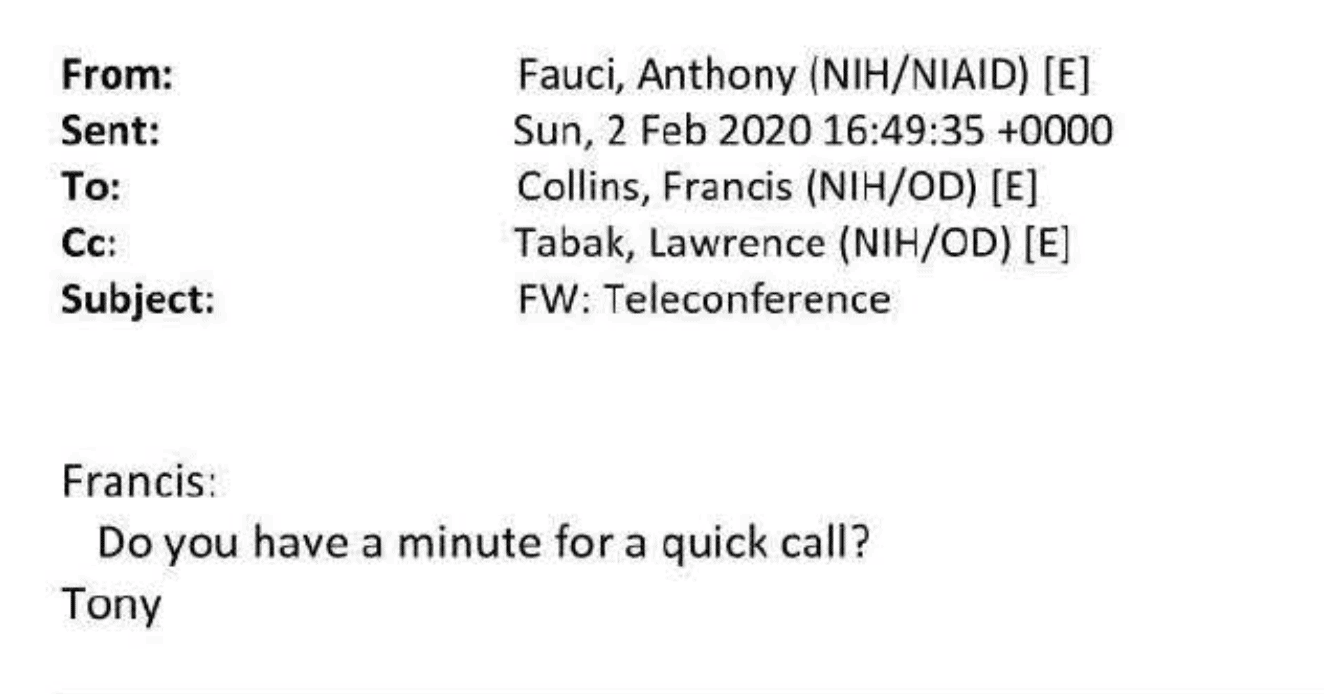
5:45 p.m.
Farrar attempts to corral the WHO into efforts by the Wellcome Trust, NIH and a handful of virologists to get ahead of the lab leak theory.
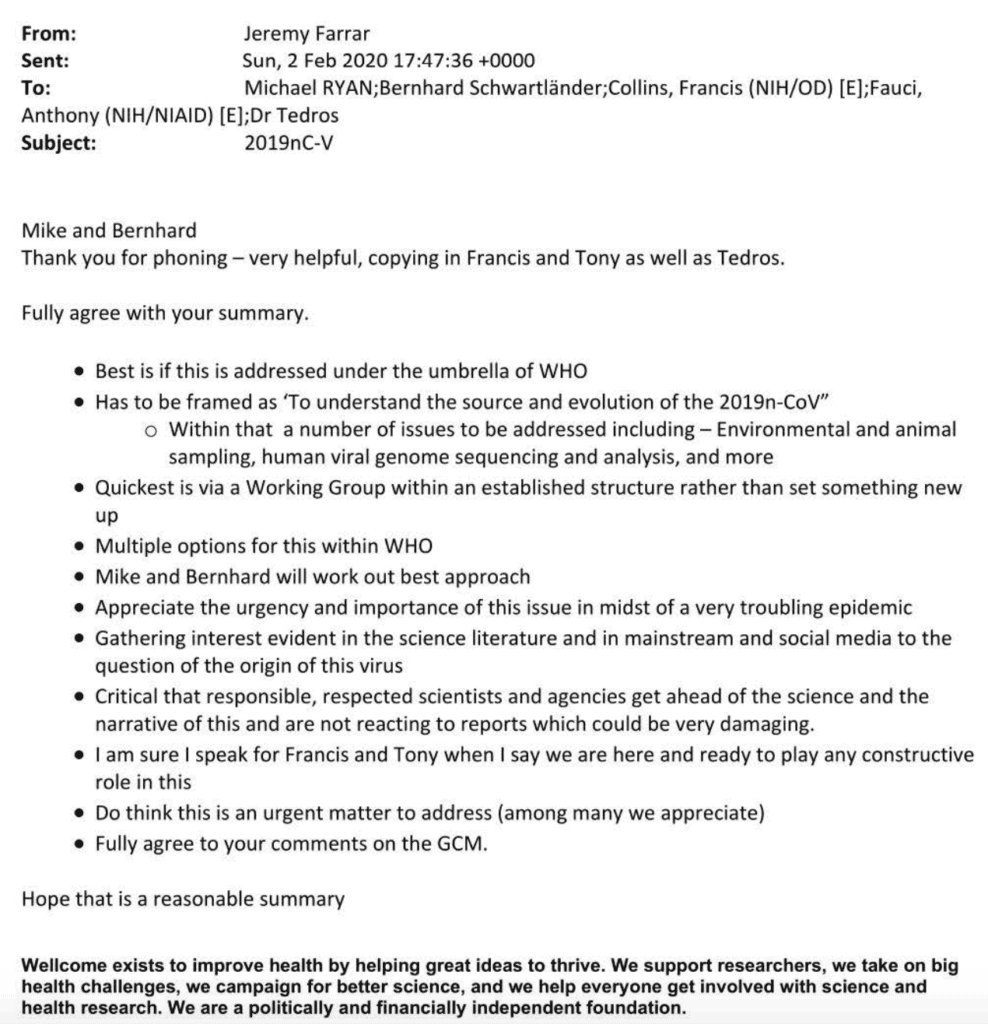
In addition, at some point on February 2, Holmes received an email from University of Hong Kong Tommy Lam about a receptor binding domain found in pangolin coronaviruses that resembled the one in SARS-CoV-2, bolstering the natural origin theory, Holmes shared in a 2022 interview.
(Pangolins were not traded at the Huanan Seafood Wholesale Market. This was known to Holmes and Andersen by February 7. The press incorrectly speculated the sale of pangolins may have been occurring off the books.)
February 3, 2020: National Academies
As “proximal origin” progressed, the National Academies of Sciences, Engineering, and Medicine tasked a committee of experts to advise the White House Office of Science and Technology Policy on next steps to determine the origin of the novel coronavirus.
Andersen also participated on the committee, as did EcoHealth Alliance President Peter Daszak and University of North Carolina virologist Ralph Baric.
The possibility of a lab origin was largely dismissed, emails show.
National security experts were present on the call, according to Daszak.
6 p.m.
Fauci met with Nekisha Williams, operations coordinator for global research funded by his institute, NIAID. The topic of the discussion was “China and the U.S.”
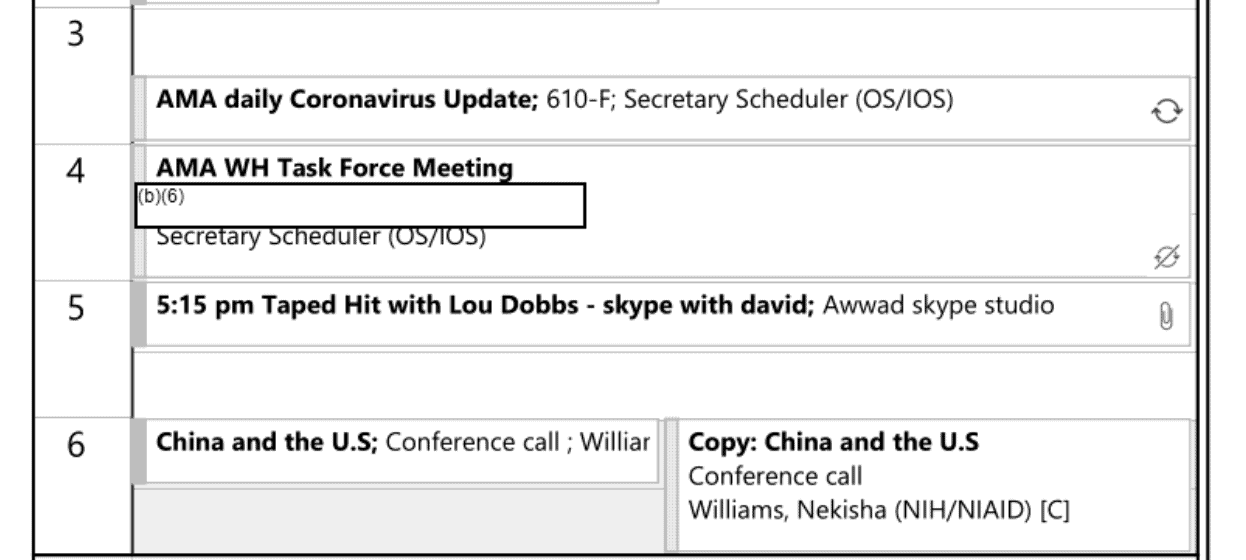
February 4, 2020: ‘Wild West’
2:01 a.m.
Farrar shared an early draft of “proximal origin” with Fauci and Collins, with the promise of a more polished version soon. Farrar said that he was “pushing WHO again today.”
Holmes had emailed Farrar the summary, noting that it “did not mention other anomalies as this will make us look like loons.”
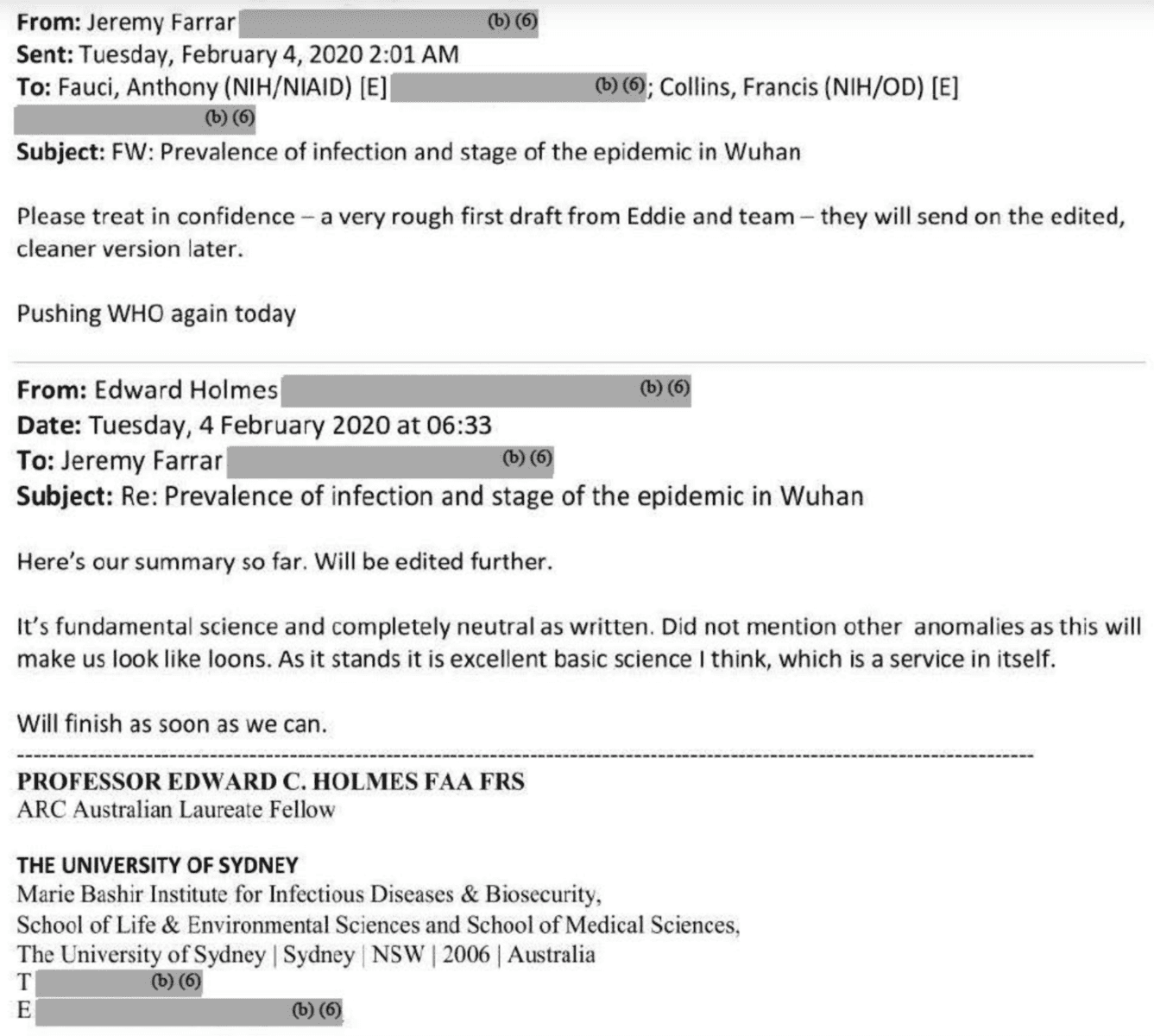
February 4 draft
The early draft states that furin cleavage sites can arise in betacoronaviruses in the lab through serial passage. The citation: A call in collaboration with the National Academies of Sciences, Engineering, and Medicine.
As “proximal origin” progressed, Andersen also participated on a NASEM team responding to a request from the White House Office of Science and Technology Policy for next steps on determining the origin of the novel coronavirus.
It’s not precisely clear who stated that betacoronaviruses could acquire a furin cleavage site in serial passage, but Andersen was one of just eight experts tapped by NASEM. Two of the other experts were EcoHealth Alliance President Peter Daszak and University of North Carolina virologist Ralph Baric.

Thus the early draft described serial passage in the lab as one of the ways the furin cleavage site might have arisen.
“Basic research involving passage of bat SARS-like coronaviruses in tissue culture and/or animal models have been ongoing in BSL-2 for many years across the world, including in Wuhan,” the draft reads.
The draft cites four Wuhan Institute of Virology papers: Isolation and characterization of a bat SARS-like coronavirus that uses the ACE2 receptor; Discovery of a rich gene pool of bat SARS-related coronaviruses provides new insights into the origin of SARS coronavirus; Bat severe acute respiratory syndrome-like coronavirus WIV1 encodes an extra accessory protein, ORFX, involved in modulation of the host immune response; Isolation and characterization of a novel bat coronavirus closely related to the direct progenitor of Severe Acute Respiratory Syndrome coronavirus.

References to the NASEM call with Baric and Daszak were removed in the final version.
That citation would be replaced in the article’s final version by a 2008 paper. The senior author on that paper was Baric.
The end of the early draft includes some stray notes. The authors appear to note that they are now seriously considering two hypotheses for how the furin cleavage site arose.
The first is that it cryptically circulated in humans before evolving the furin cleavage site. The second is that it acquired a furin cleavage site in an intermediate host.
The first hypothesis is problematic because the clustering of early cases around the market implies that there was very little cryptic circulation in people.
“The connection to the market would be spurious – some doubt on that already,” the notes read.
The second hypothesis requires a plausible intermediate host, the authors note.
“This mutation is not seen in any bat coronavirus and is thus unlikely to be adaptive in those species,” the notes read. “Can we suggest a host where this cleavage site would likely be advantageous. Ferrets/polecats? Rodents – bamboo rats (I don’t know if they’re popular in China)?”
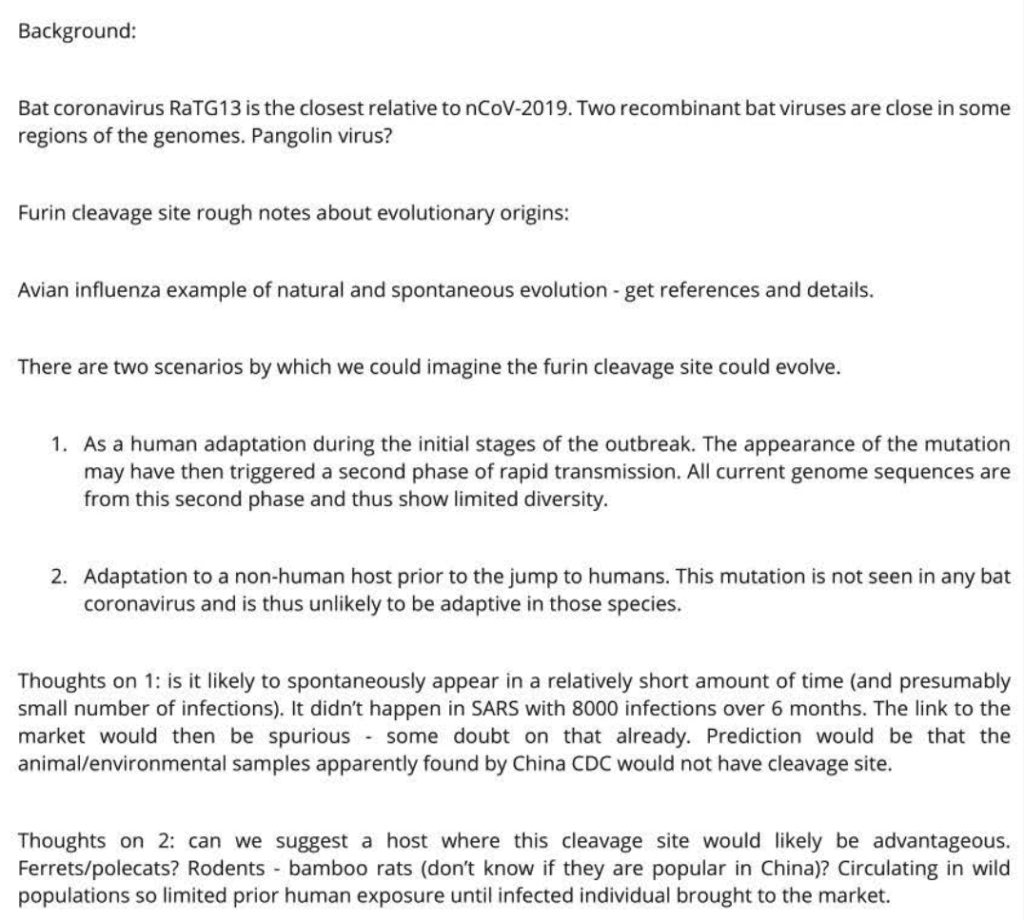
6:08 a.m.
Farrar reported to Fauci and Collins that Holmes is “60-40 lab,” while Farrar is “50-50.” While the virologists have let go of the possibility of engineering, serial passage, another way of making viruses more dangerous in the lab, remains on the table, he reports.
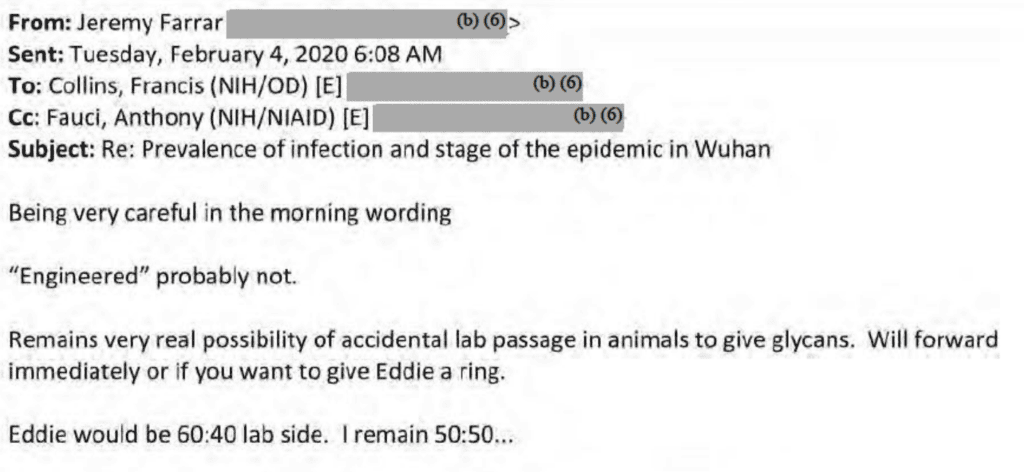
6:12 a.m.
Collins expresses interest in the theory that SARS-CoV-2 acquired features like the furin cleavage site through serial passage.

6:23 a.m.

Fauci praised the early draft of “proximal origin.”
“Very thoughtful summary and analysis. We really need to get the WHO moving on getting the convening started,” he wrote.
Fauci said in a 2023 press interview that he’s not sure he ever read it.
10:58 a.m.
Collins notes that an early draft argues against intentional engineering, but that serial passage remains on the table, though it would not explain other features of concern.

12:05 p.m.
Andersen encouraged the NASEM to dispel the idea of an engineered virus.
“Reading through the letter I think it’s great, but I do wonder if we need to be more firm on the question of engineering,” he wrote.
Andersen previewed the argument that would become a central premise of “proximal origin.”
“The main crackpot theories going around at the moment relate to this virus being engineered with intent and that is demonstrably not the case. Engineering can mean many things and could be done for either basic research or nefarious reasons, but the data conclusively show that neither was done (if in the nefarious scenario somebody would have used a SARS/MERS backbone and optimal ACE2 binding as previously described, and for the basic research scenario would have used one of the many already available reverse genetic systems),” he wrote.
As for communicating these ideas to the public, just a few days after emailing Fauci that he had found the genome to be “inconsistent with expectations from evolutionary theory,” Andersen encouraged the scientists to communicate the virus had arisen naturally using a similar phrase, only inverted: “consistent with natural evolution.”
“If one of the main purposes of this document is to counter those fringe theories, I think it’s very important that we do so strongly and in plain language (“consistent with [natural evolution] is a favorite of mine when talking to scientists, but not when talking to the public – especially conspiracy theorists),” he wrote.
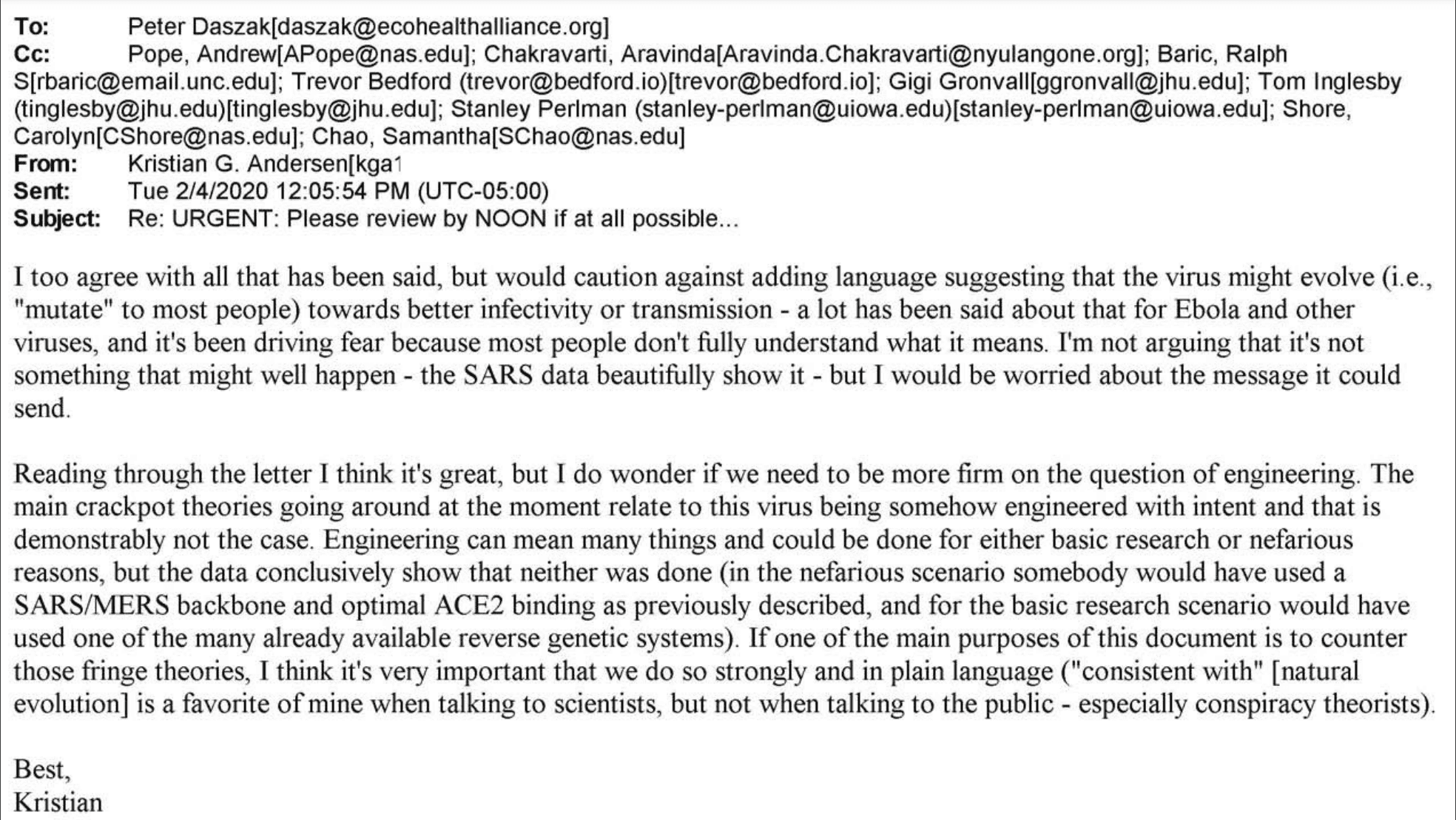
1:18 p.m.
Fauci emails with apparent alarm about “serial passage in ACE-2 transgenic mice.”
(The virologists were exploring whether the unusual furin cleavage site could have arisen through serial passage, a technique that can increase viral pathogenicity without engineering by inducing successive infections in the lab.)
Fauci had been alerted a few days earlier that research he funded at the Wuhan Institute of Virology included a paper that found SARS-related coronaviruses can bind to human cells and cause disease in humanized mice.
Baric shared transgenic mice with the lab.
Farrar described the biosafety level at which experiments on SARS related viruses were conducted at the Wuhan Institute of Virology as a “Wild West.”
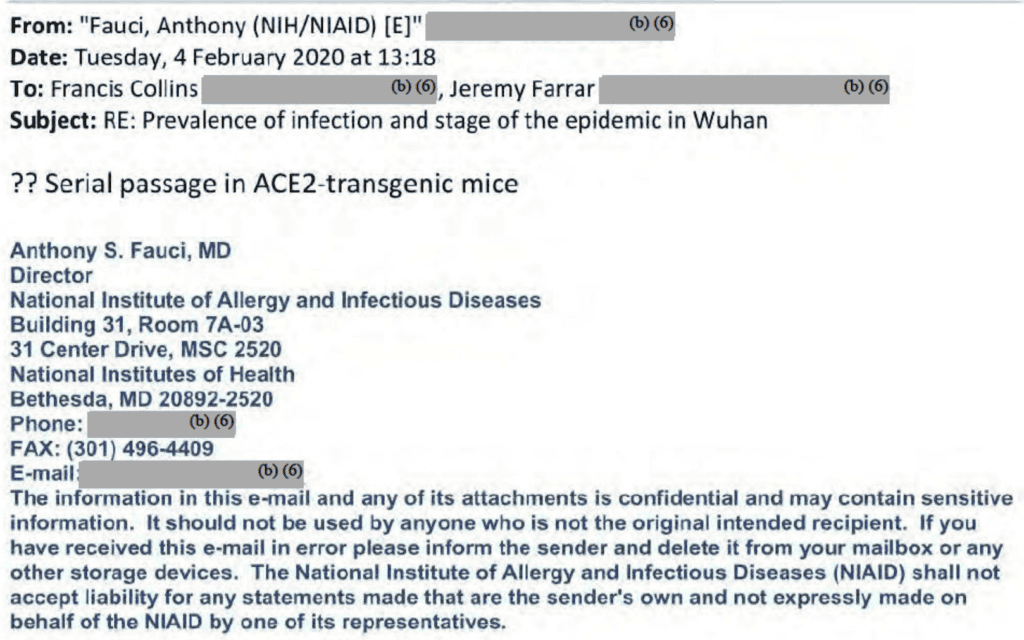
“Exactly!” Farrar appears to reply.
Collins expresses incredulity that such work would be conducted in a BSL-2, a relatively low biosafety level.
“Wild West,” Farrar replies.
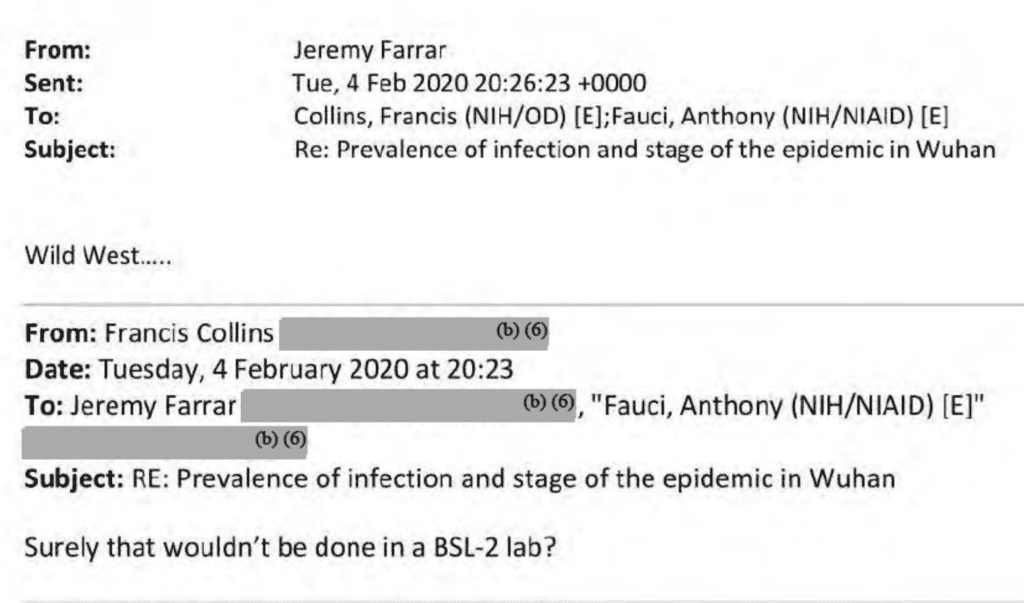
February 5, 2020: ‘I spoke with the WHO again this morning’
6:21 a.m.
Farrar tells Fauci that their groups should “pressure” the WHO. He asked Fauci to recommend the names of individuals who could serve on an origins investigation, but none of the names Fauci recommends ultimately end up on any probe.
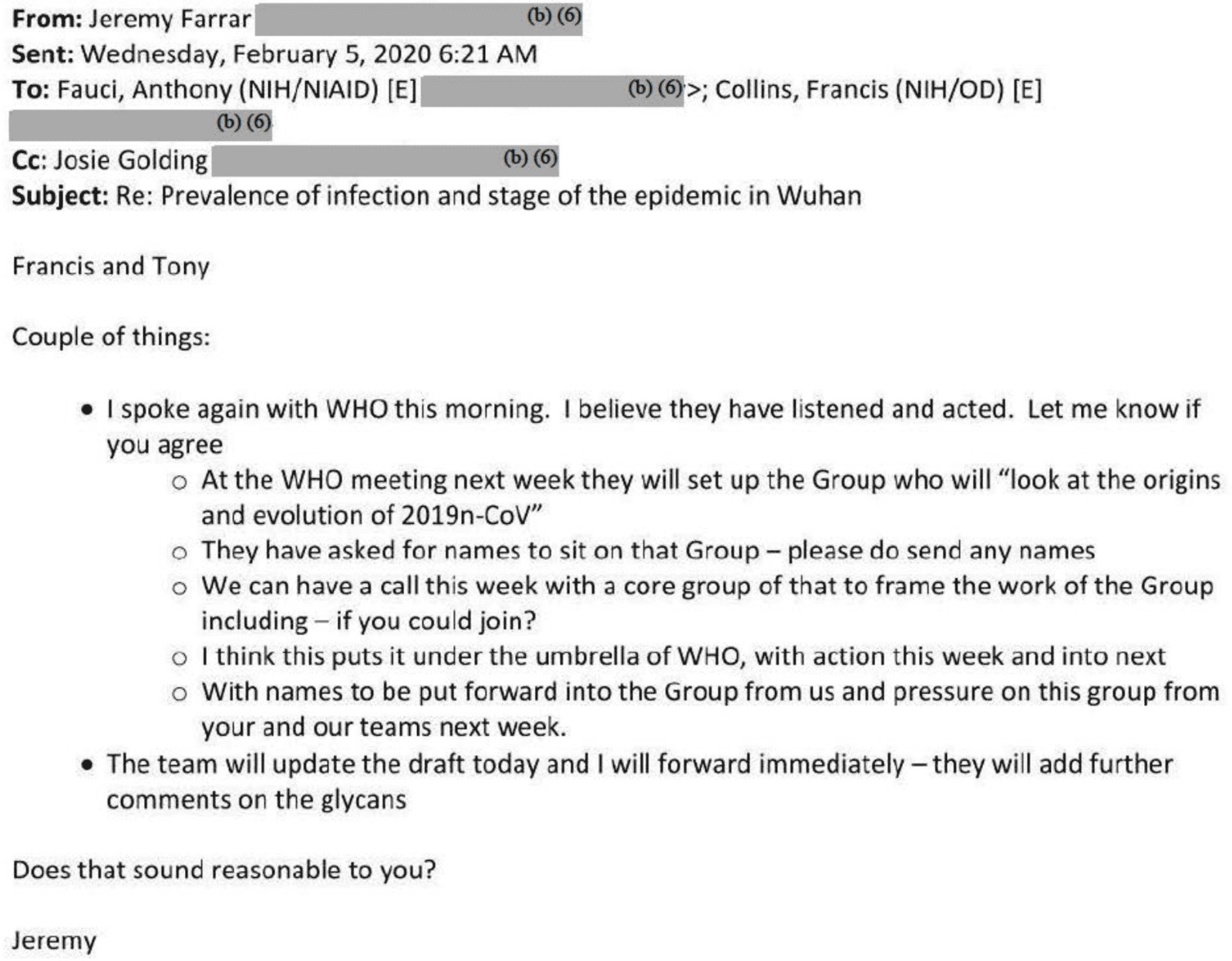
“Francis and Tony,
Couple of things:
- I spoke again with the WHO this morning. I believe they have listened and acted. Let me know if you agree
- At the WHO meeting next week they will set up the Group who will “look at the origins and evolution of 2019n-CoV”
- They have asked for names to sit on that Group – please do send any names
- We can have a call this week with a core group of that to frame the work of the Group including – if you could join?
- I think this puts it under the umbrella of WHO, with action this week and into next
- With names to be put forward into the Group from us and pressure on this group from your and our teams next week
The team will update the draft today and I will forward it immediately – they will add further comments on the glycans”
6:57 a.m.
Farrar discusses the possibility of a furin cleavage site arising in serial passage in the lab. His email implies that Fouchier may be sharing data on furin cleavage sites arising in the lab with the assembled virologists.
“I think that if you put selection pressure on a CoV without a furin cleavage site in cell culture you could well generate a furin cleavage site after a number of passages (but let’s see the data from Ron!),” Farrar wrote.
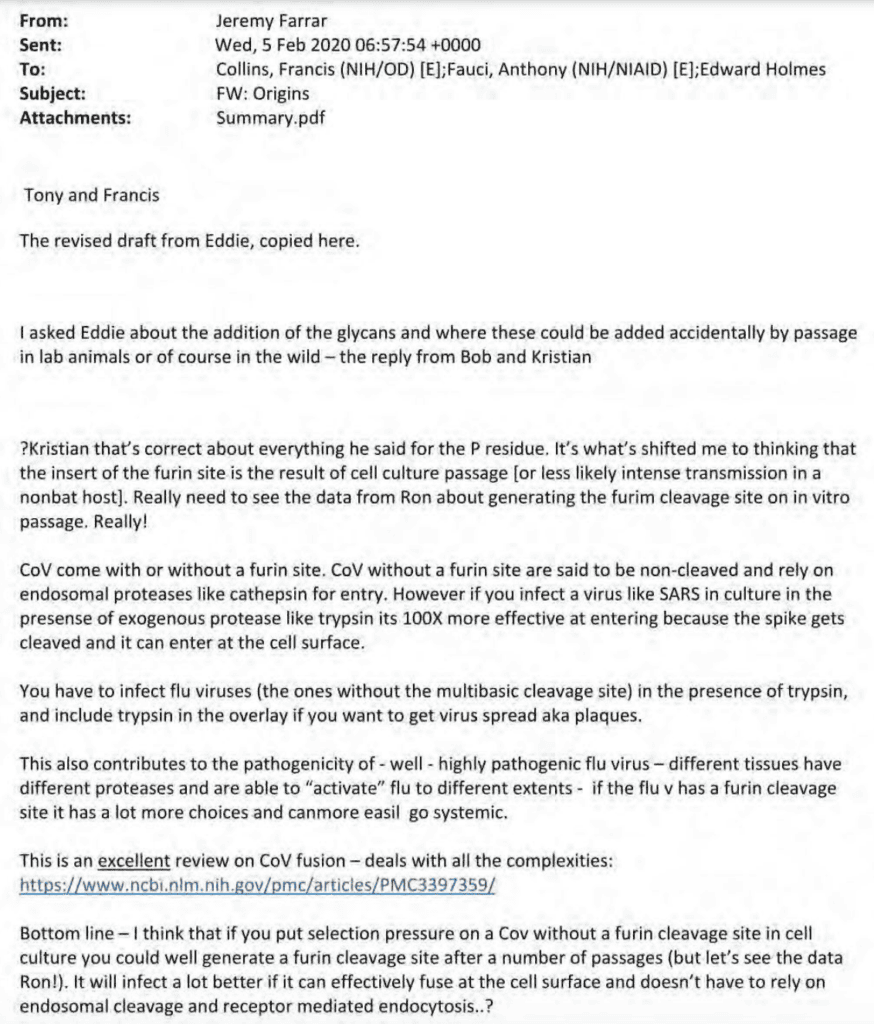
February 6, 2020: Pangolin data drives controversy
8:30 a.m.
Fauci joins Daszak on former House Speaker Newt Gingrich’s podcast, “Newt’s World.”
“There’s a sort of urban legend that there’s a biological warfare center in Wuhan and that the coronavirus escaped from that,” Gingrich said.
“I’ve heard these conspiracy theories,” Fauci replied. “And like all conspiracy theories, Newt, they’re just conspiracy theories. … the things you’re hearing are still in the realm of conspiracy theories without any scientific basis.”
10 p.m.
Just as Western scientists were preparing a public statement against a lab origin, Chinese scientists made their own announcement pointing toward a natural source.
Scientists in Guangzhou, China, hosted a press conference announcing the discovery of pangolin coronaviruses with a receptor binding domain — a key segment of the spike protein that binds to human cells — with a 98.6 percent percent identity to SARS-CoV-2, citing their own press release.
Between February 7 and 18, Chinese scientists submitted four separate studies to various scientific journals about a pangolin coronavirus.
Some scientists immediately expressed concerns about the lack of the full set of raw data.
But Andersen and Holmes seized on the announcement. The virologists expressed optimism to a reporter at the journal Nature that SARS-CoV-2 may have evolved the changes it needed to infect humans through a pangolin intermediary.
“I can definitely believe it could be true,” said Andersen.
“Although we need to see more details, it does make sense as there are now some other data emerging that pangolins carry viruses that are closely related to 2019-nCoV,” said Holmes.
The virologists’ confidence came despite the fact pangolins were not listed on the public inventory of the Huanan Wholesale Seafood Market, according to the Nature report.
The virologists’ quotes were distributed to the wider infectious diseases community via an alert to the ProMED reporting system.
And while Farrar and Collins expressed hope that the pangolin data would explain the mysterious furin cleavage site, the pangolin coronavirus sequences did not have one.
Indeed, Daszak’s research showed that the pangolin was an unlikely intermediary. Daszak surveyed Guangzhou wet markets from 2015 to 2016 for wild animals and found zero pangolins, a grant report shows.
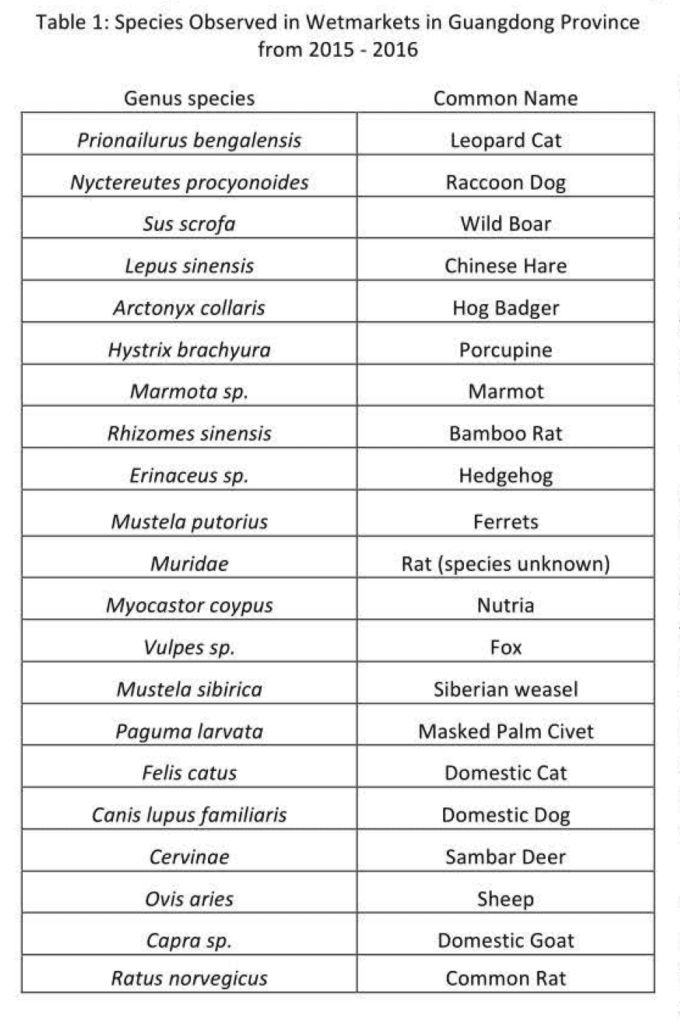
“I mentioned that the pangolin link is likely spurious, i.e. that it’s unlikely they were an amplifier of infection at the Wuhan market because they are so rare in the wildlife trade as live animals (mainly dried scales sold for medicine),” Daszak wrote in a February 28, 2020, email obtained by U.S. Right to Know.
He suggested that pangolins, which are critically endangered, were not truly a reservoir for SARS-CoV-2. He suggested that a small number of pangolins may have been incidentally infected.
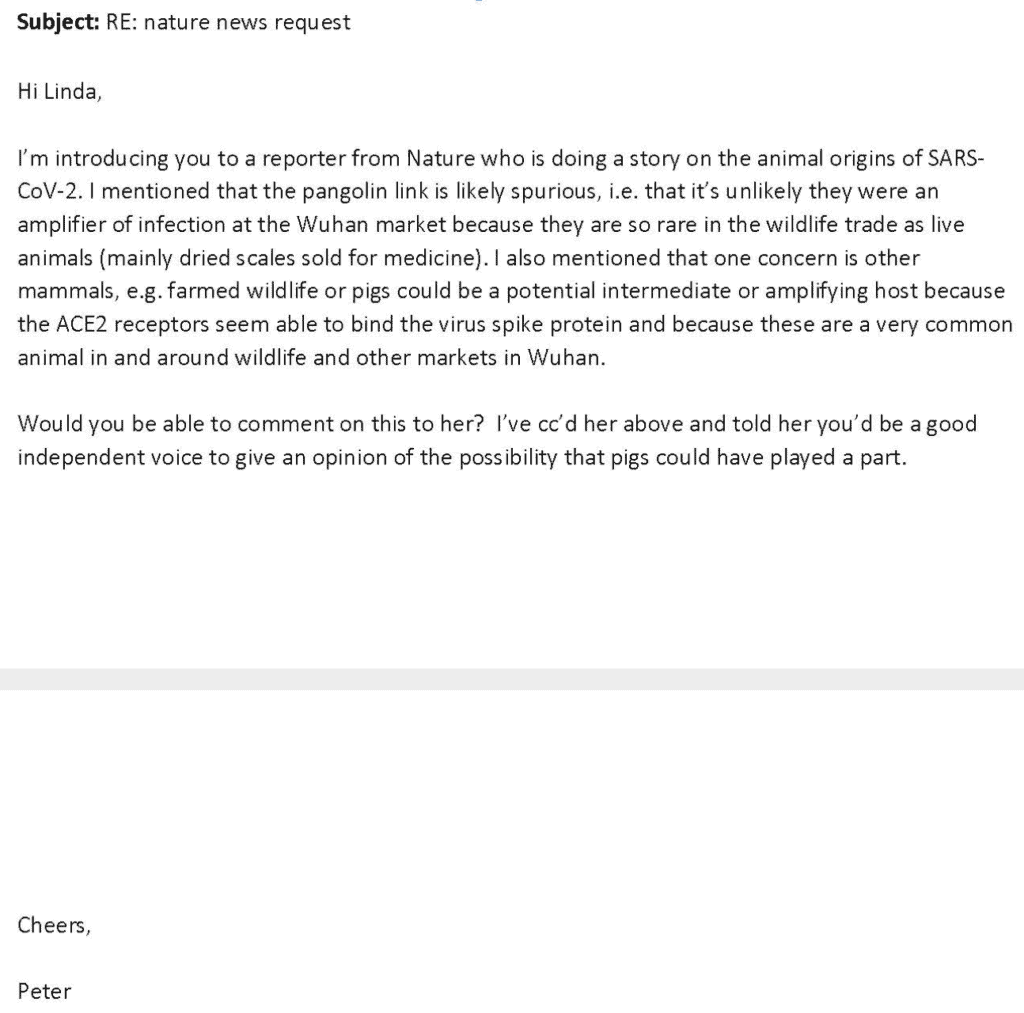
The highly similar receptor binding domain described as occurring in pangolin coronaviruses was sourced from a single dataset first described in an October 2019 paper, outside inquiries later revealed. The data, renamed without attribution to the earlier paper, came from a handful of pangolins seized by Guangdong Customs in March 2019.
While some of the data was first submitted to a public database in September 2019, they were re-published in January 2020.
Two journals that had published papers about the pangolin sequences published corrections clarifying the shared data.
It took until June 2021 for a correction to be appended to one of the pangolin papers stating explicitly that pangolins were not the intermediate host, as the viruses were too distantly related.
“The similarities were not strong enough to support that pangolins are intermediate hosts of SARS-CoV-2,” it reads.
February 7, 2020: Farrar loops in National Academies
1:21 a.m.
Farrar updates Collins and Fauci on the search for pangolin coronaviruses with a furin cleavage site.
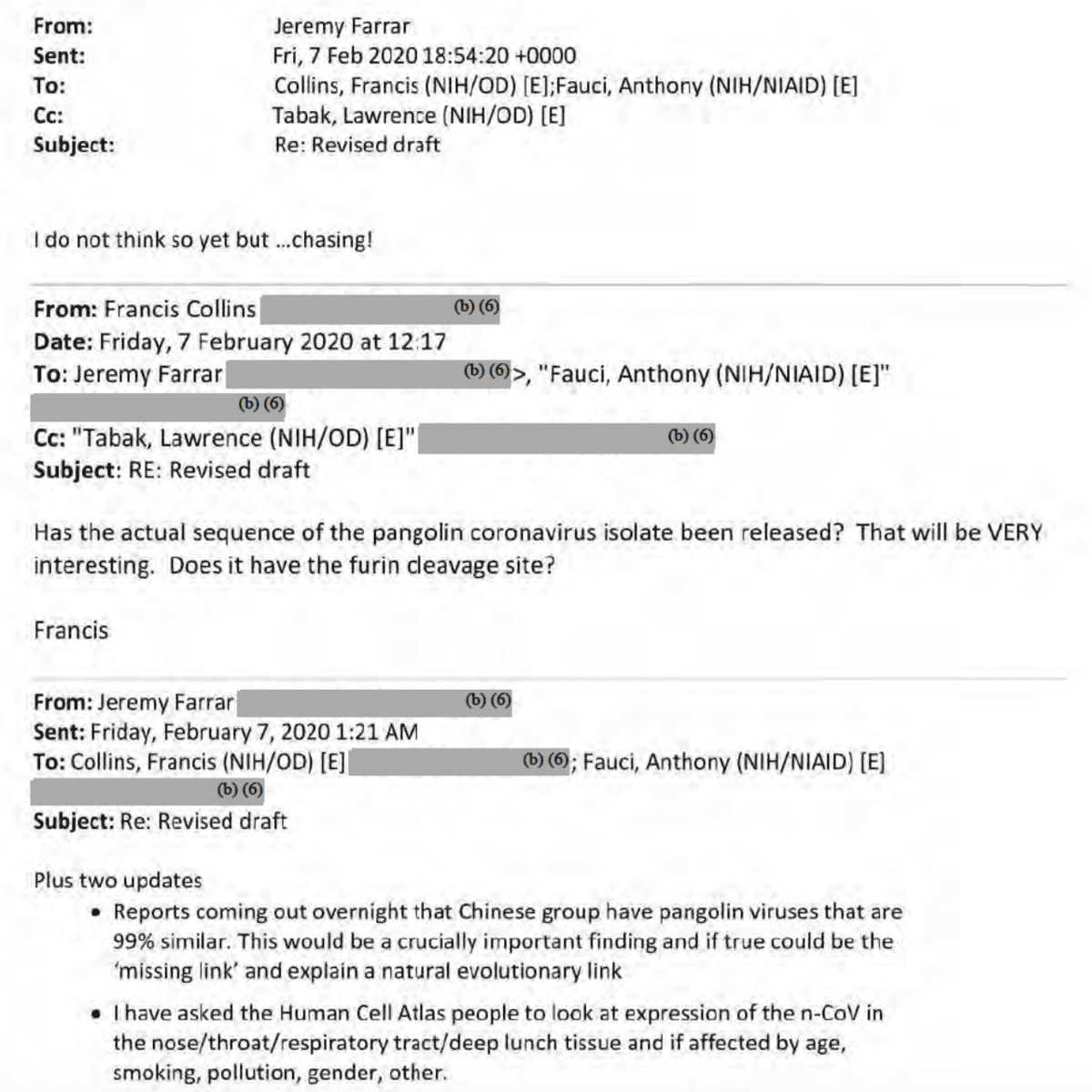
3:05 p.m.
Farrar spots a news article sharing that the White House has asked the National Academies of Sciences, Engineering, and Medicine to investigate the pandemic’s origin.
Farrar emailed Victor Dzau, head of the National Academy of Medicine, to alert Dzau of the work of his team.
“Tony (Francis) Patrick, myself and a close knit group have been looking at this for the last 10 days and might have some information to share which might help,” Farrar wrote, copying Fauci and Collins.
Fauci is quoted in the article and alludes to the drafting of “proximal origin.”
“There’s always that concern,” Fauci said on the question of engineering. “And one of the things that people are doing right now is very carefully looking at sequences to see if there’s even any possibility much less likelihood that that’s going on. And you could ultimately determine that. So people are looking at it, but right now, the focus is on what are we going to do about what we have.”
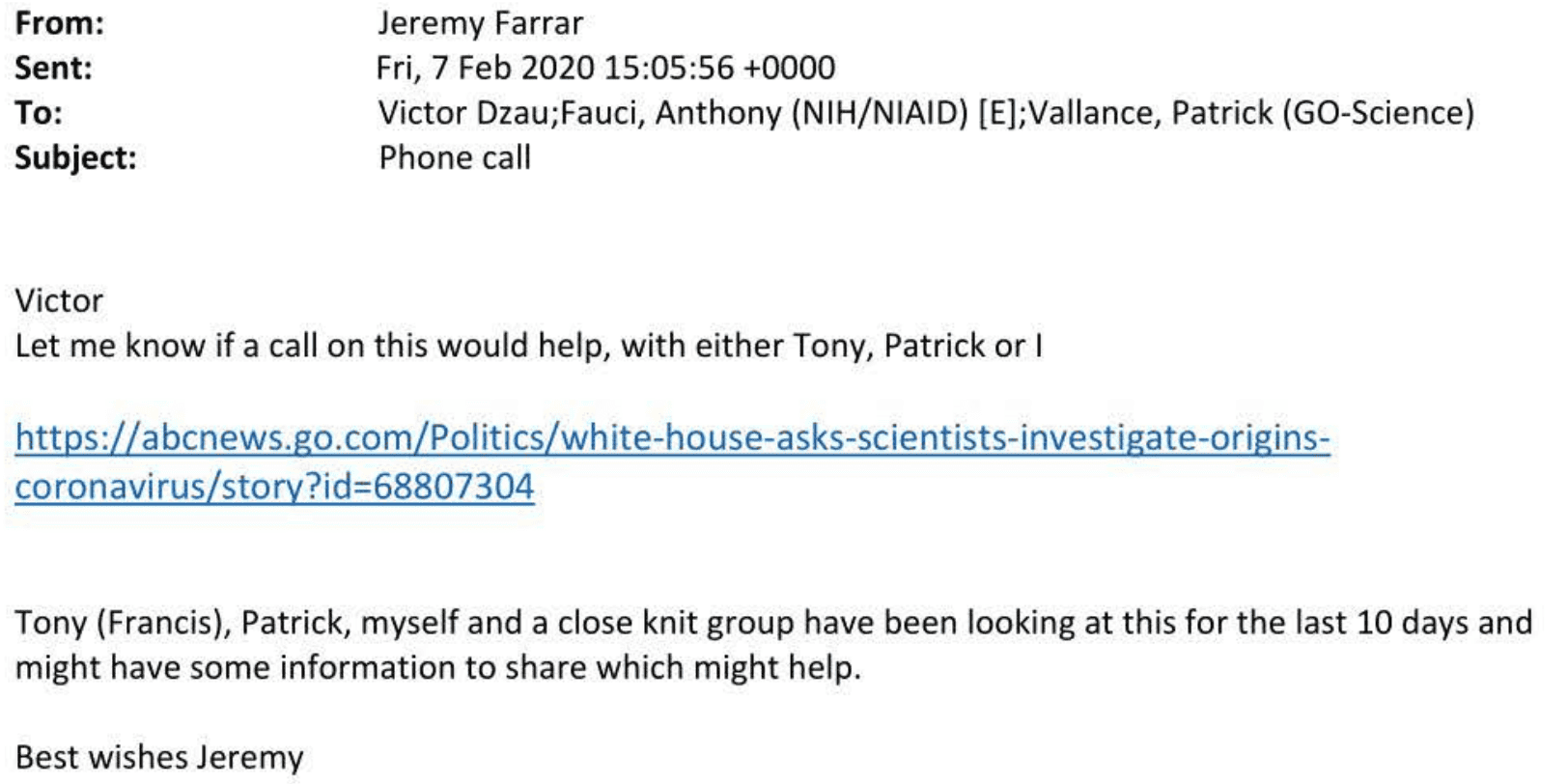
By February 6, NAESM had published a letter in response to the White House’s request to investigate the virus’ origins. Despite Andersen’s pressure to rule out the “crank” theory, the letter did not explicitly rule out a lab origin.
8:25 p.m.
Andrew Pope, director of health policy with the National Academies, thanked all of experts who participated in the Feb. 3 discussion between the White House, the National Academies and national security officials.
Tom Inglesby — director of the Johns Hopkins Center for Health Security and an advocate for stricter regulations on pandemic potential gain-of-function research — asks if the work of the ad hoc committee is completed.
Pope replies that the work of the National Academies is completed.
Two administration officials were included on the email: Ian Watson, then assistant director for biotechnology & biosecurity at the Office of Science & Technology Policy and current deputy assistant secretary of defense for chemical and biological defense, and Chris Hassell, deputy assistant secretary at the Administration for Strategic Preparedness and Response (ASPR) and former deputy assistant secretary of defense for chemical and biological defense.
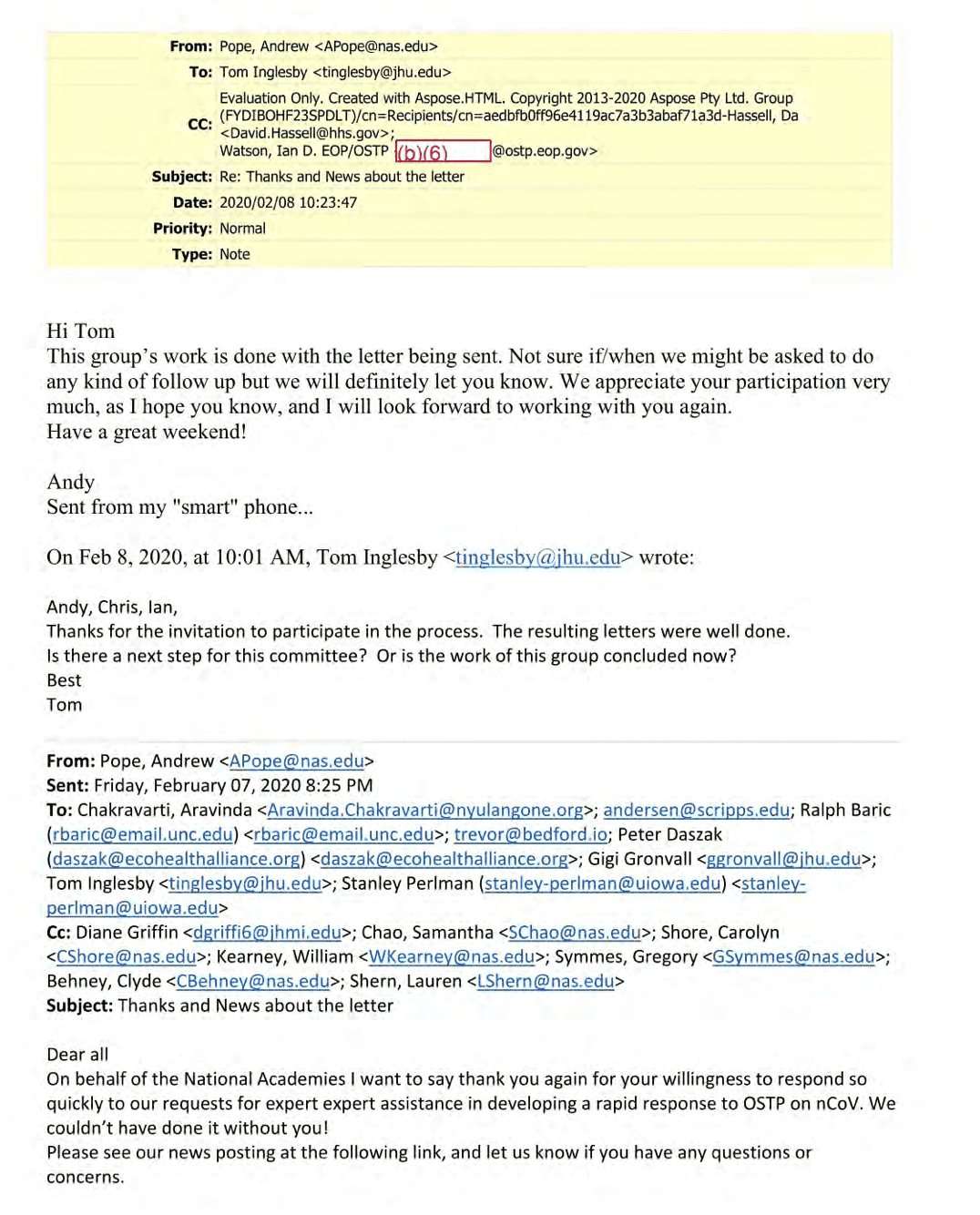
February 8, 2020: Another teleconference
4:08 a.m.
Farrar shared a summary of discussions between the scientists with Dzau, as well as the head of the National Academy of Sciences and the head of the White House Office of Science and Technology Policy.
The document was called “Summary.Feb7.pdf.”
“Eddie Holmes and a small group have been looking extensively at the origins and evolution of n-CoV including all theories,” Farrar wrote in an email to Dzau, referring to an early abbreviation for the novel coronavirus.
“This is the latest summary, written as part of a series of [teleconference] discussions we set up and included [National Institute of Allergy and Infectious Diseases Director Anthony Fauci] and [National Institutes of Health Director Francis Collins] as well as a small group from USA, UK, Europe and Australia,” Farrar wrote.
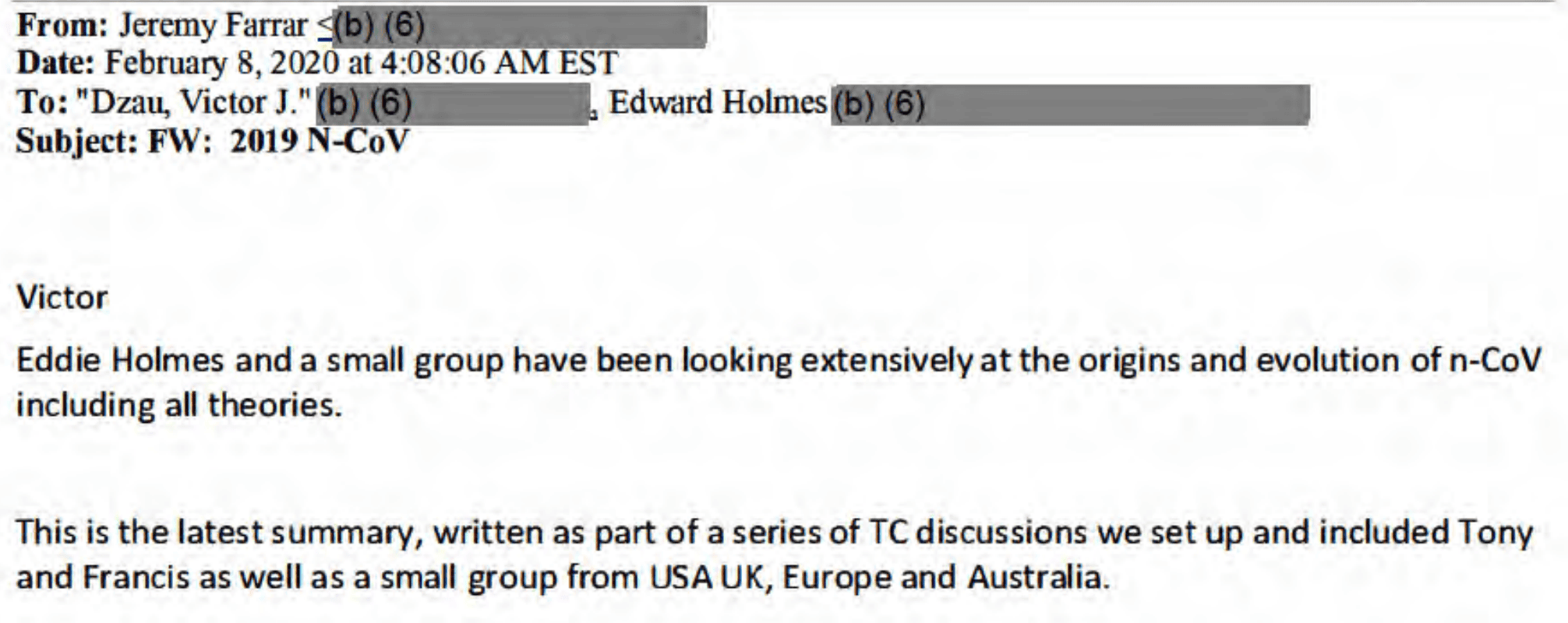
Holmes would later describe “SummaryFeb7.pdf” as a summary of the forthcoming “proximal origin” manuscript, saying it was largely unchanged from the version that would appear in a scientific journal ruling out a lab origin in March, according to an email to a journalist released in late 2022.
In other words, in under a week’s time, Andersen and Holmes had gone from agonizing about breaking the news to the world that SARS-CoV-2 was engineered to preparing to tell the world that was impossible.
8:36 p.m.
Later that day, Farrar hosted a second teleconference.
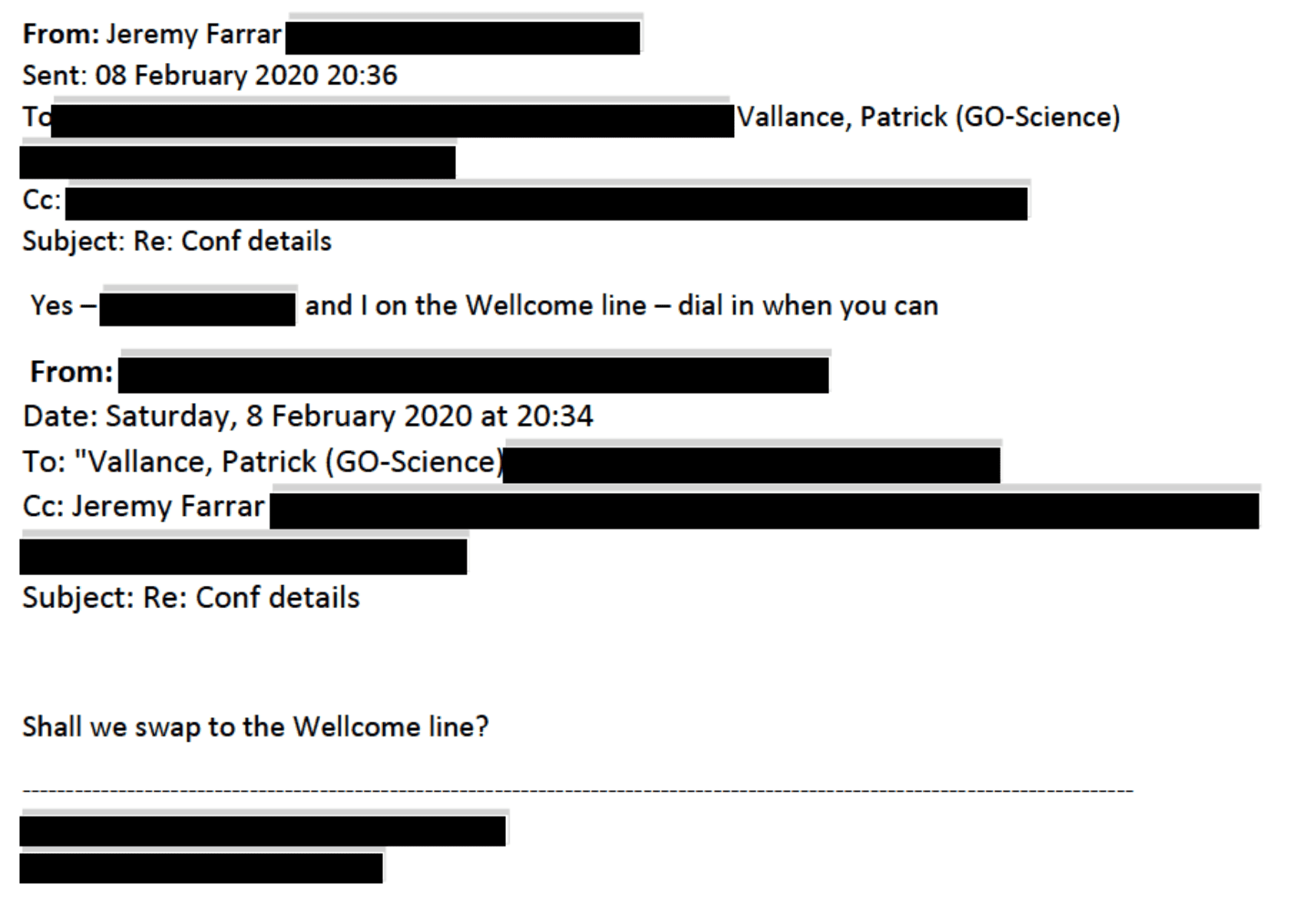
6:52 a.m.
Farrar shared the draft with the participants on the Feb. 1 call. Farrar said they were still pushing to obtain sequence data for pangolin coronaviruses rumored to have a furin cleavage site.
Farrar solicits feedback on two possibilities: Natural evolution and serial passage in the lab.
“Is there anything more in relation to what would seem to be the two possibilities: Nature, immediate host, evolution and passage?” he wrote.
Farrar also asked whether the authors should publish the piece at all.
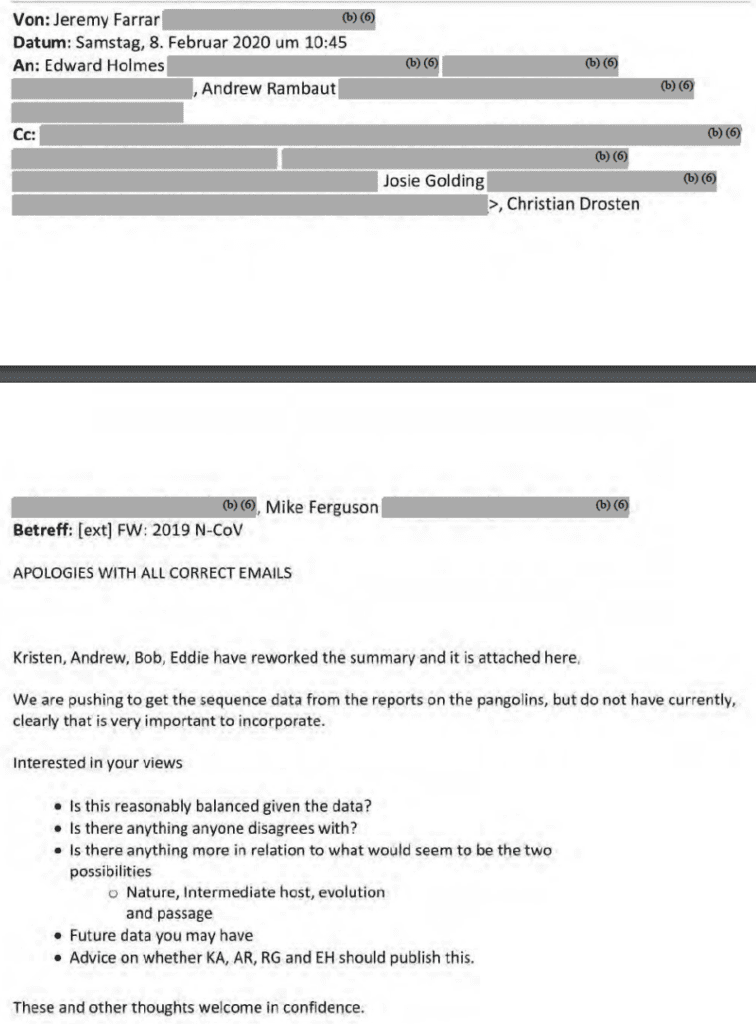
8:10 p.m.
Holmes responds by emphasizing that many in China believe a lab origin of COVID-19 is possible.
“Ever since this outbreak started there have been suggestions that the virus escaped from the Wuhan lab, if only because of the coincidence of where the outbreak occurred and the location of the lab,” Holmes said. “A lot of people there believe this and believe they are being lied to.”
These concerns were heightened when the Wuhan Institute of Virology published a preprint indicating they had sampled RaTG13, a virus 96 percent similar to SARS-CoV-2, Holmes said.
“I believe the aim/question here is whether we, as scientists, should try to write something balanced on the science behind this? There are arguments for and against doing this,” Holmes continued. “Personally, with the pangolin virus possessing 6/6 key sites in the receptor binding domain, I am in favour of the natural evolution theory.”

9:21 p.m.
Farrar articulated his goal for the article: To frame the debate about a possible lab origin of COVID-19 before it generated “potentially hugely damaging ramifications” in light of gathering suspicion among reporters and social media accounts that the burgeoning pandemic was connected to the coronavirus lab at its epicenter.
“The aim of this was to bring a neutral, respected, scientific group together to look at the data and in a neutral, considered way provide an opinion and we hoped to focus the discussion on the science, not on any conspiracy or other theory and to lay down a respected statement to frame whatever debate goes on – before that debate gets out of hand with potentially hugely damaging ramifications.”
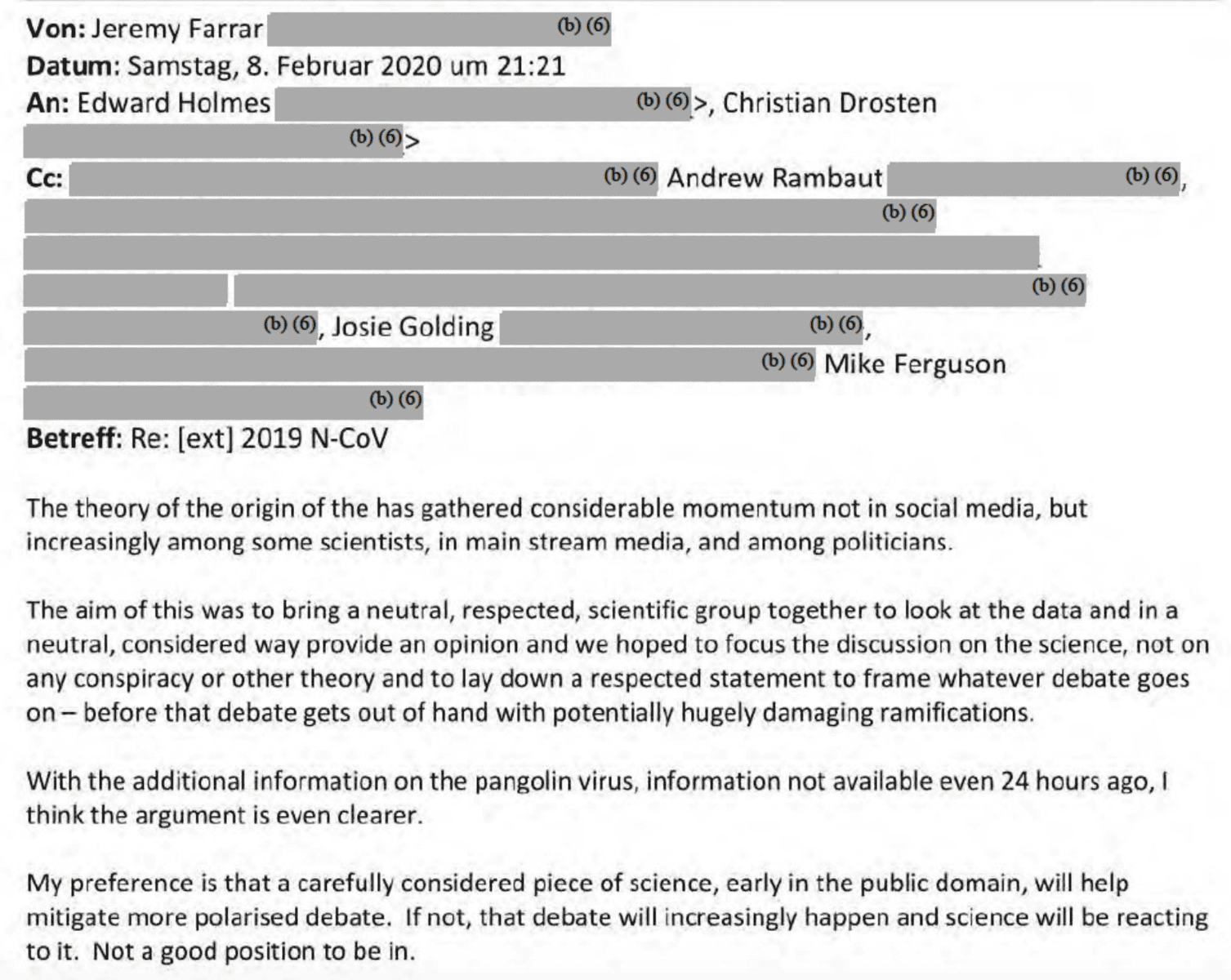
10:15 p.m.
Andersen clarified to the group that his intention was to push back on lab origin theories, but that there was not enough evidence yet.
“Our main work over the past couple of weeks has been to disprove any type of lab theory, but we are at a crossroad where the scientific evidence isn’t conclusive enough to say that we have high confidence in any of the three main theories considered,” he wrote.
He said he hoped coronaviruses rumored to be found in pangolins with a high similarity to SARS-CoV-2 would be the final puzzle piece in scuttling discussions of a lab origin. Among the conspiracy theories he listed: “bioengineering,” something he considered a possibility a few days earlier.
“For now, giving the lab theory serious consideration has been highly effective at countering many of the circulating conspiracy theories, including HIV recombinants, bioengineering, etc,” he said.
He expressed the need to address the fact that work was underway on coronaviruses at the Wuhan Institute of Virology in a BSL-2 lab, a relatively low biosafety level. He also thought the furin cleavage site deserved further scrutiny.
Yet Andersen echoed the gain-of-function virologists on the call who rejected any evidence of a lab origin and opposed publishing anything. Without more credible evidence against engineering in hand, nothing should be published, he said.
“As to publishing this document in a journal, I am currently not in favor of doing so,” he said. “I believe that publishing something that is open-ended could backfire at this stage.”
Andersen advised the group to wait on more data, including the pangolin coronavirus sequences, in order to “come out with some strong conclusive statements that are based on the best data we have access to.”
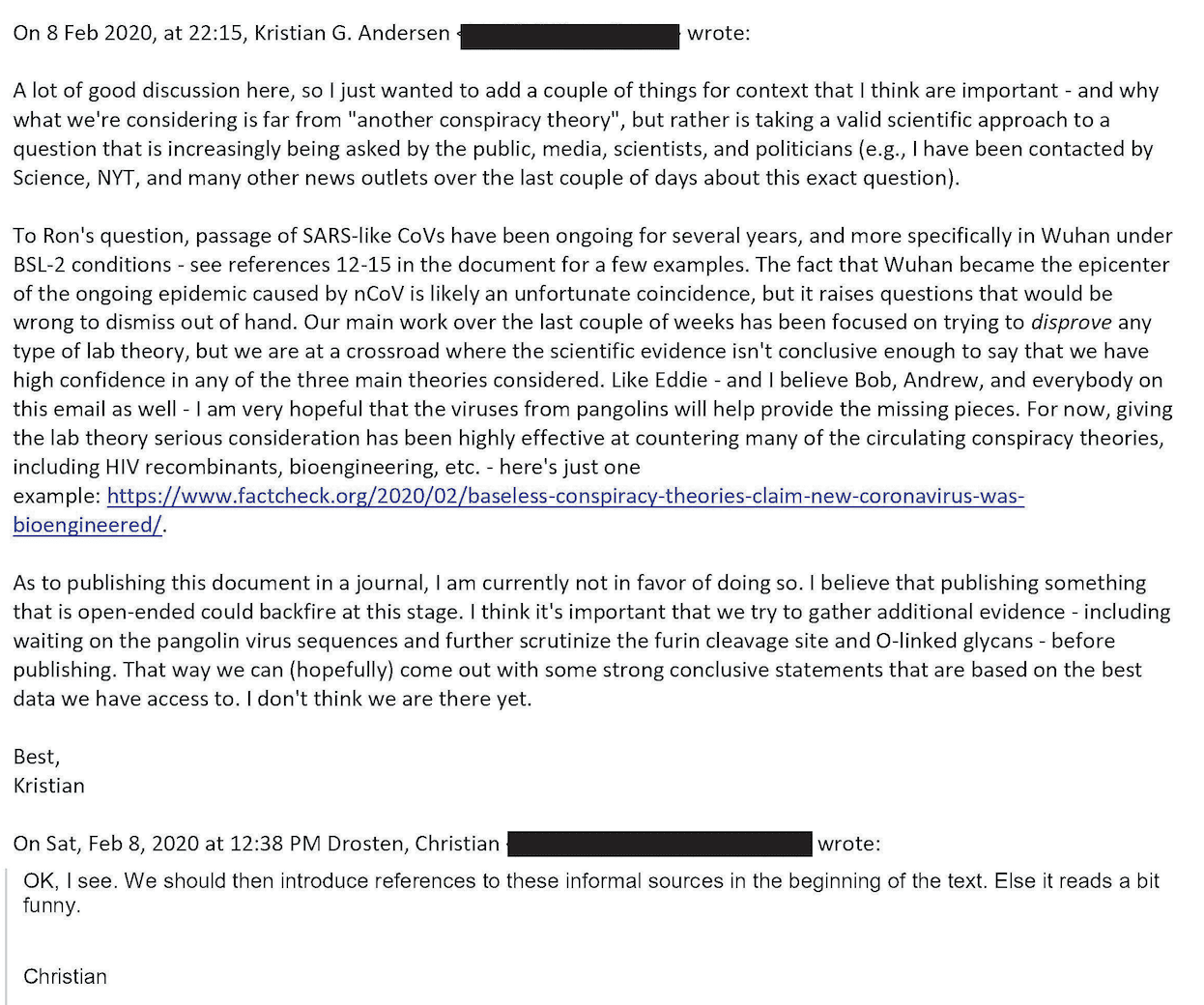
February 9, 2020: ‘This could backfire’
6:52 a.m.
In reply, Drosten posed a question to the group: Why give oxygen to the possibility of a lab origin at all?
“Are we working on debunking our own conspiracy theory?” he asked, implying Andersen’s initial concerns about engineering were conspiratorial.
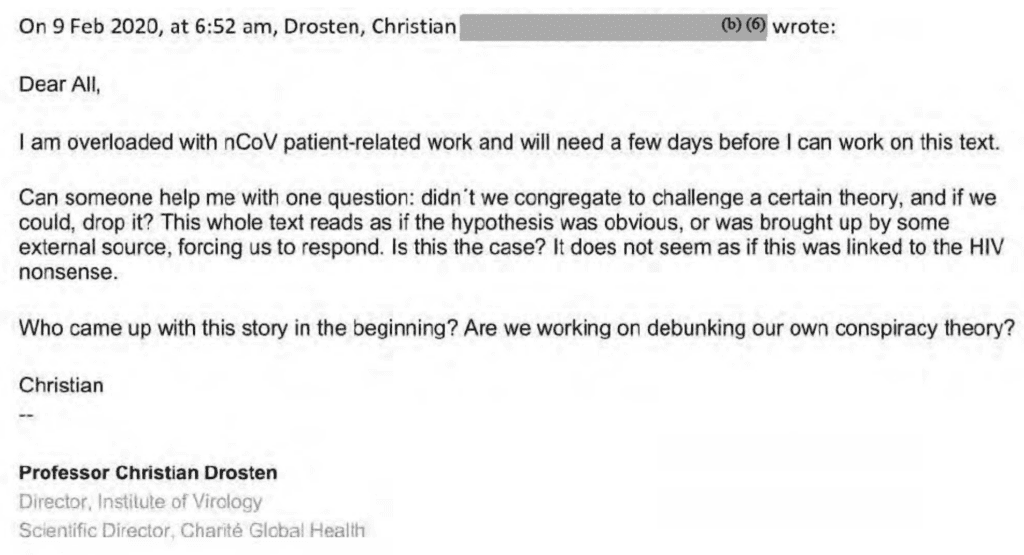
9:49 a.m.
Farrar asks Ferguson to review an early draft.
The group is eagerly anticipating pangolin sequence data from China, Farrar says. Fauci and Collins are cc’d.
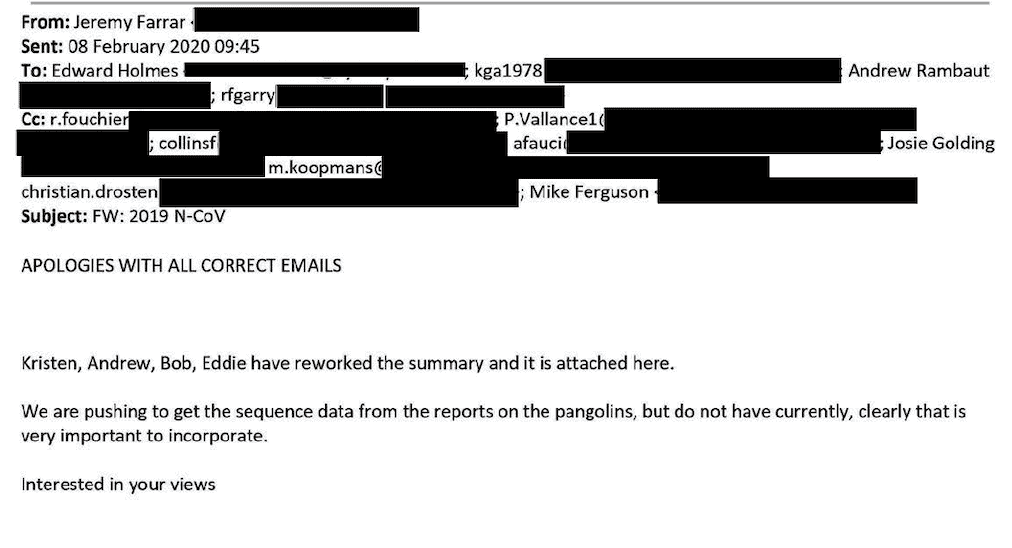
12:00 p.m.
Ferguson gives comments. The document with his comments has not been made publicly available.
Ferguson writes that he does not have the right expertise to definitively weigh in on the group’s arguments regarding O-linked glycans around the furin cleavage site. He adds that Lawrence Tabak — then the principal deputy director of the NIH, who was elevated to acting director after Collins left — has that expertise and was on the Feb. 1 call.
“I am not an expert on protein O-glycoslyation – however, Dr Tabak, who was on the call last weekend, is,” he wrote.
He also recommended consulting Henrik Clausen, head of the University of Copenhagen Center for Glycomics.
“However, from what I do know of general glycobiology, I am not sure one can conclude than an immune system would be required to select for O-glycosylation sites,” he added.
The “proximal origin” article would argue that the O-linked glycans had evolved naturally.
8:07 p.m.
Koopmans — head of a virology department in the Netherlands that generated headlines for gain-of-function research — suggested not publishing on the possibility of a lab escape at all.
Apparently catching up on email, Koopmans chimed in a day later to suggest scrapping the possibility of a lab escape as a hypothesis in the article for fear it would “generate its own conspiracy theories.”
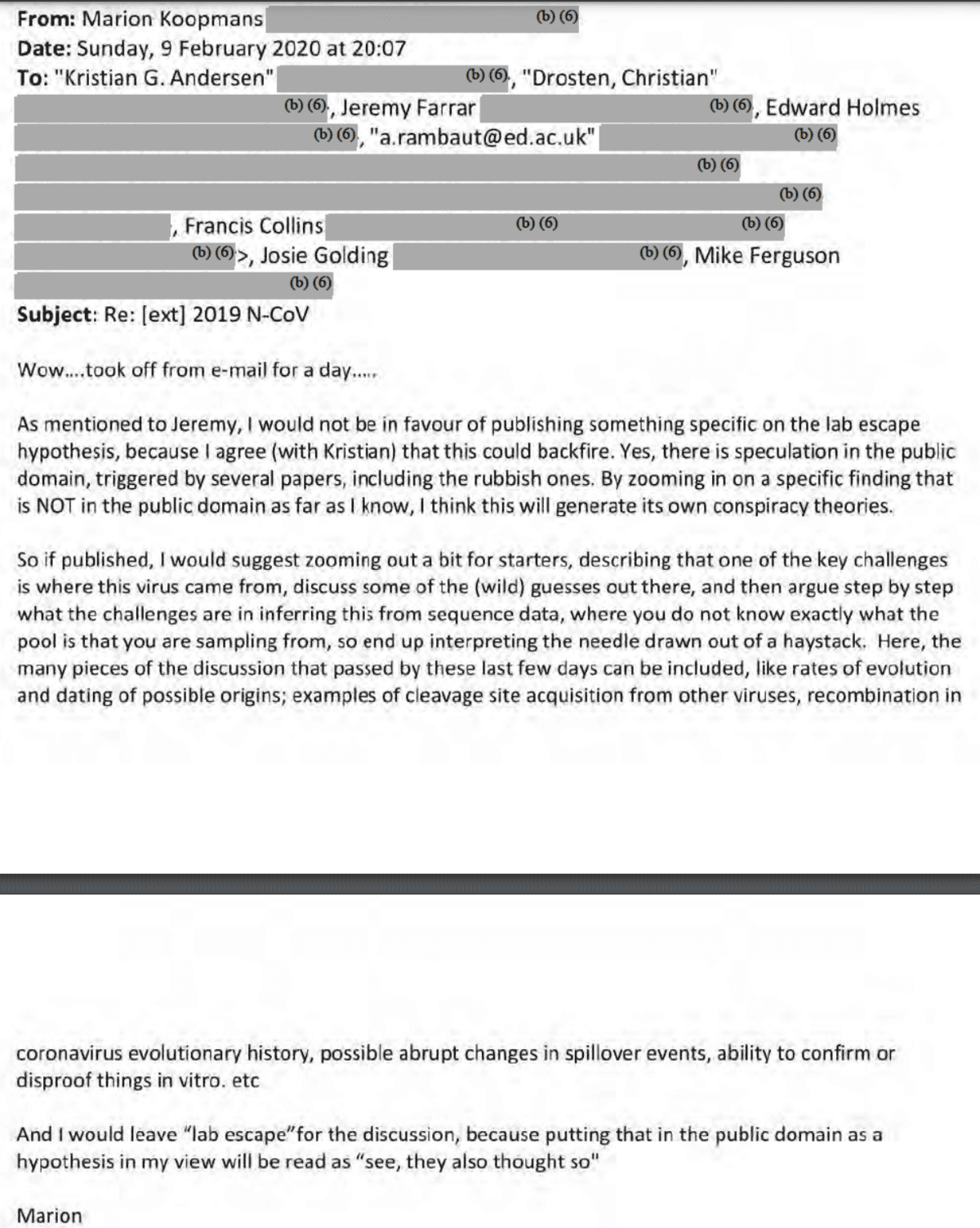
February 10, 2020: ‘The furin cleavage site is an issue’
Holmes told Lipkin that he will ask Farrar if he can include him in the discussions.
“I’ll have a chat with Jeremy [Farrar] in a little while to see if can [sic] get you more directly involved,” Holmes wrote.
The email indicates that Farrar led the drafting of the paper, yet went uncredited.
The email also indicates that after the discovery of the pangolin coronavirus sequences Holmes remained concerned about the furin cleavage site.
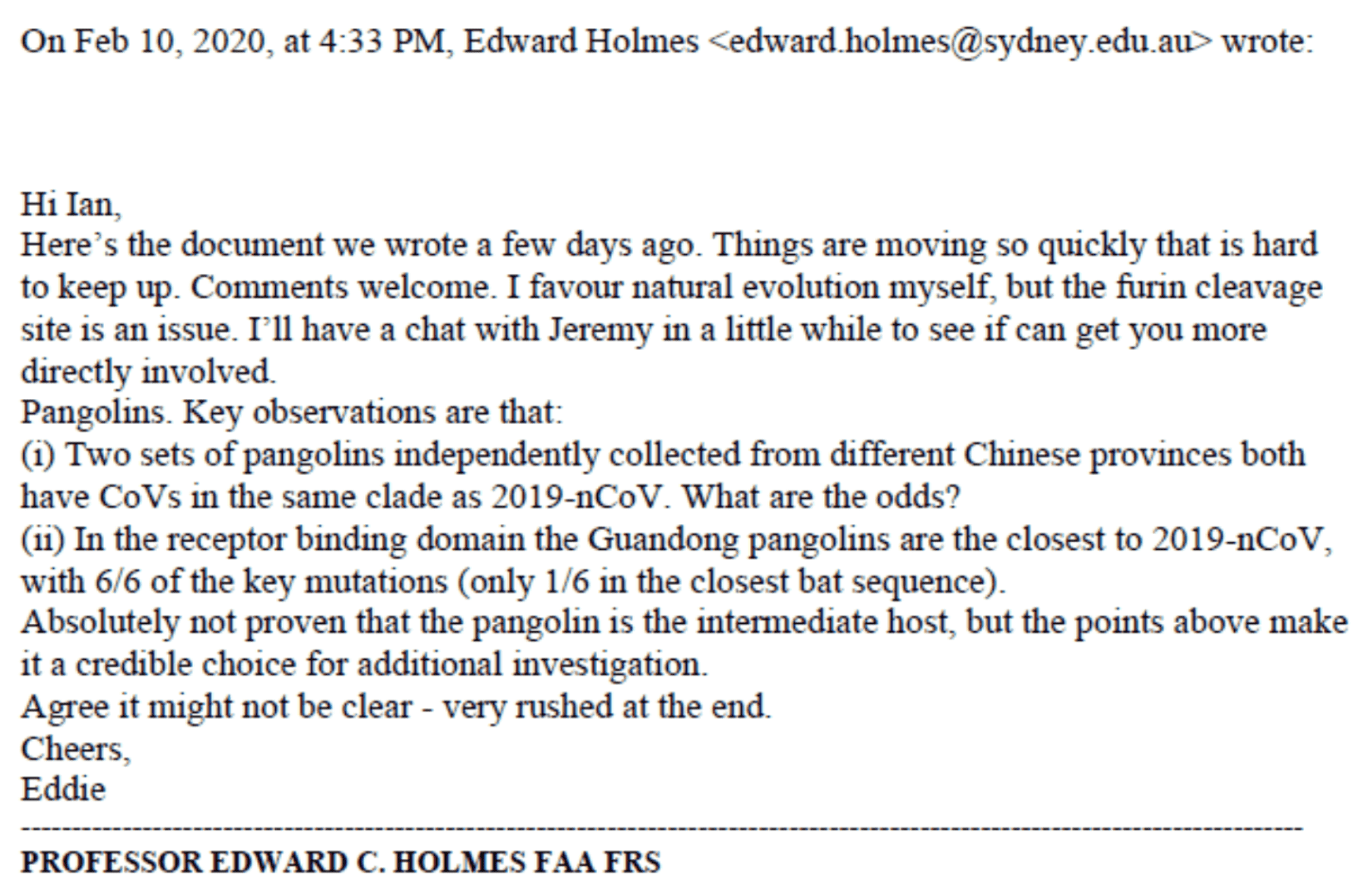
February 11, 2020: ‘A nightmare of circumstantial evidence’
9:01 a.m.
Lipkin emailed Holmes about a “nightmare of circumstantial evidence” pointing to the Wuhan Institute of Virology, as first reported by Vanity Fair.

“It’s well reasoned and provides a plausible argument against genetic engineering. It does not eliminate the possibility of inadvertent release following adaptation through selection in culture at the institute in Wuhan,” Lipkin wrote. “Given the scale of bat CoV research pursued there and the site of emergence of the first human cases we have a nightmare of circumstantial evidence to assess.”
Holmes responds that he agrees.
“It is indeed striking that this virus is so closely related to SARS yet is behaving so differently. Seems to have been pre-adapted for human spread since the get go,” Holmes wrote. “It’s the epidemiology I find most worrying.”
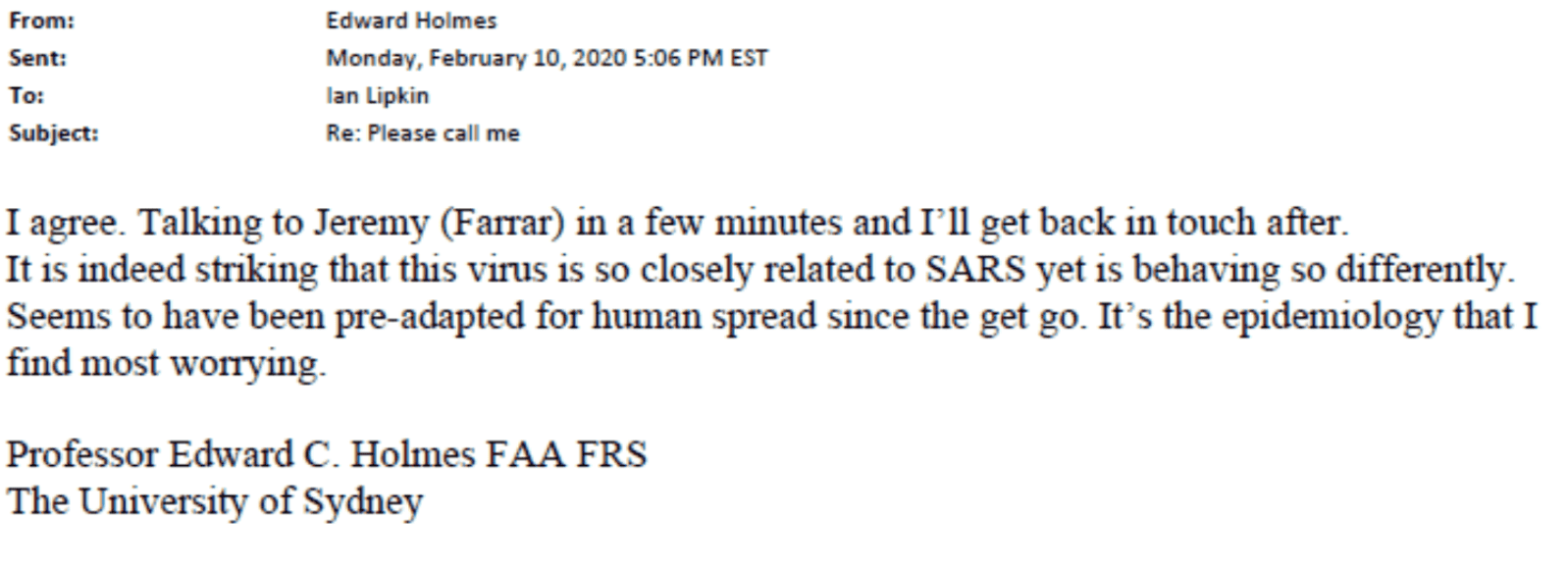
2:30 p.m.
Fauci met with Baric, a virologist who collaborated with the Wuhan Institute of Virology, including on gain-of-function work on coronaviruses that alarmed Fauci and the authors of “proximal origin.”
Emily Erbelding, director of NIAID’s division of microbiology and infectious diseases, joined the meeting. Erbelding may be the “Emily” tasked with investigating whether NIAID had ties to Baric’s work on Feb. 1.
Fauci and Baric discussed “chimeras,” or engineered viruses, another email suggests.

February 12, 2020: ‘Prompted by Jeremy Farrah, Tony Fauci and Francis Collins’
11:09 p.m.
Andersen pitched the article to the premier scientific journal Nature as an answer to the “speculation, fear mongering, and conspiracies” about the pandemic’s origin, appearing to leverage the involvement of some of science’s most influential men in a bid for publication.
Andersen said that the analysis had been “prompted by Jeremy Farrah, Tony Fauci, and Francis Collins.”
Andersen conceded that he was pitching the journal before having completed a final manuscript.
“We are not quite finished with the writeup and we still have some loose ends, but I wanted to reach out to you to see if this might potentially be of interest?” he asked.
(A well informed anonymous tipster later would relay a rumor to a journalist that the paper had been rejected by Nature due to plagiarism concerns. While it’s clear the virologists picked up a key premise of their article from Fouchier, they adamantly deny the accusation of plagiarism.)
The paper would eventually be published by sister publication Nature Medicine.
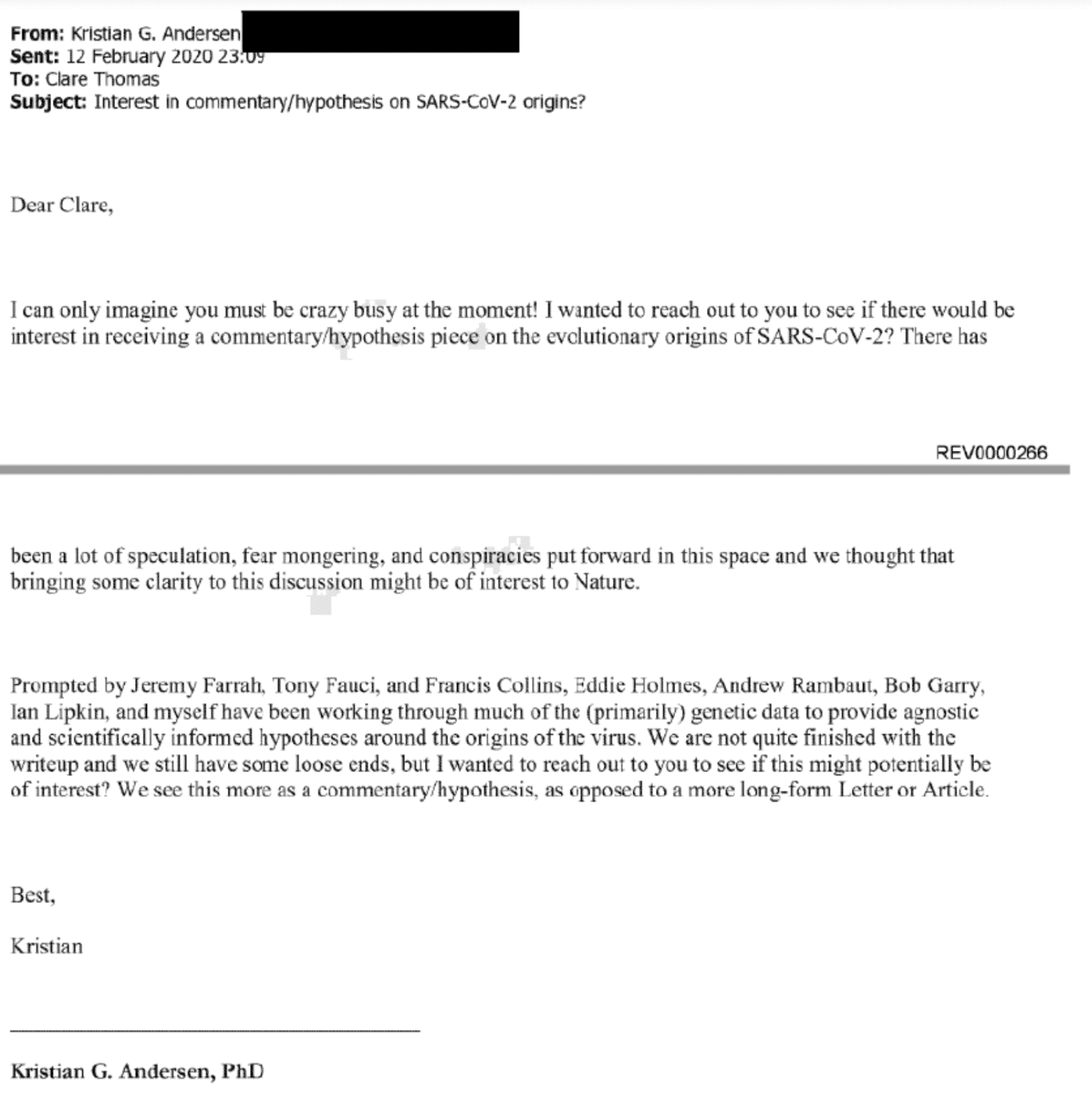
February 13, 2020: ‘Not my area of expertise’
10:36 p.m.
CDC National Center for Immunization and Respiratory Diseases Director Nancy Messonnier — who reports to Redfield — asked Fauci for more clarity on the National Academies’ report on SARS-CoV-2’s origin.
Fauci described the teleconferences and emails being convened by Farrar, and said that he has joined two of these calls.
“There is an ad hoc group informally led by Jeremy Farrar of Wellcome Trust,” Fauci wrote. “This group has about 15 people, all of whom are highly respected scientists, mostly evolutionary biologists who are convening by email and conference calls (I have been on 2 of these calls since Jeremy invited me) to look at all of the bat, pangolin and human coronavirus sequence to try and determine the evolutionary origin.”
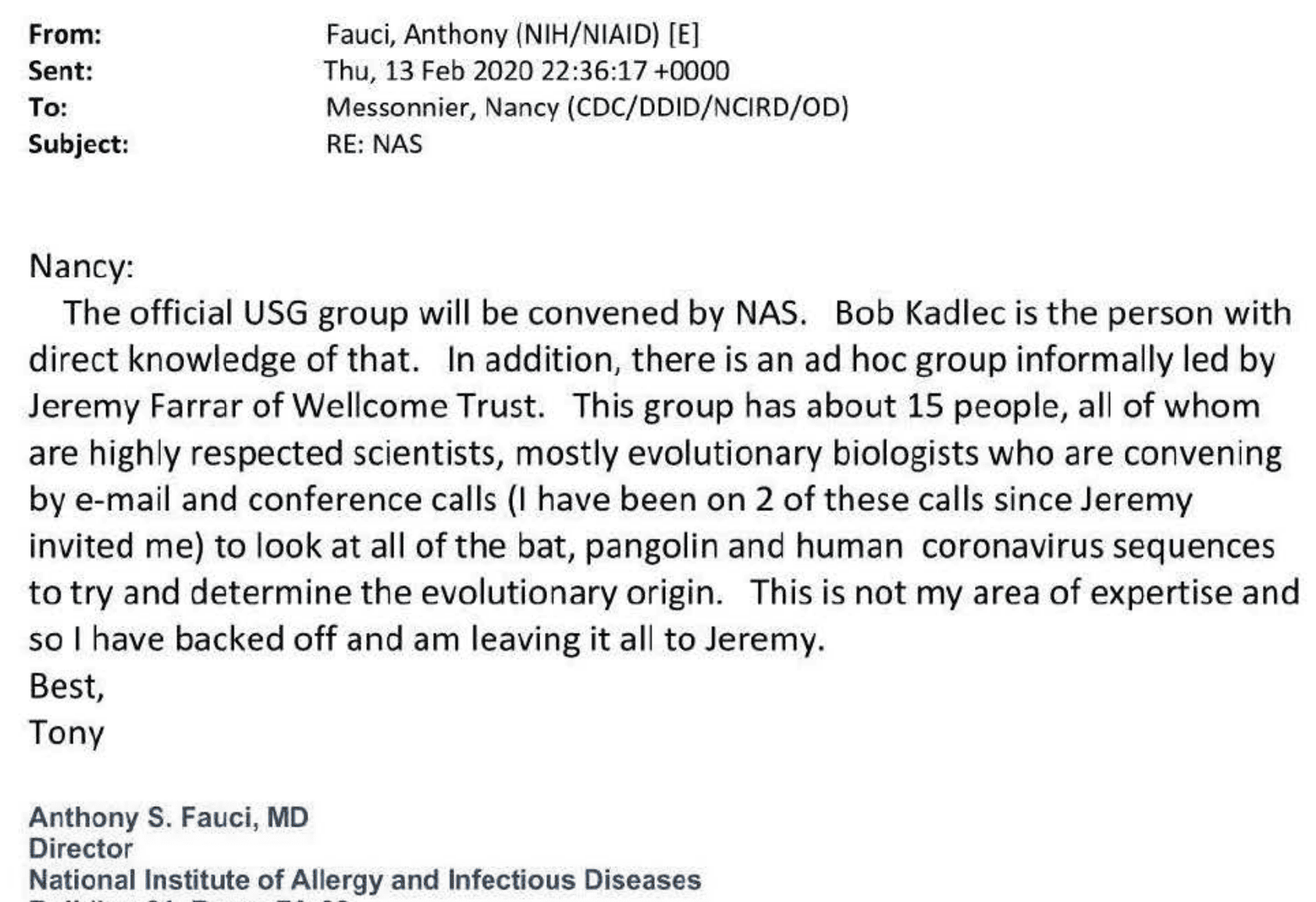
“This is not my area of expertise so I have backed off and am leaving it all to Jeremy,” Fauci added.
February 17, 2020: Preprint publishes
9:02 a.m.
Farrar makes a last minute edit.
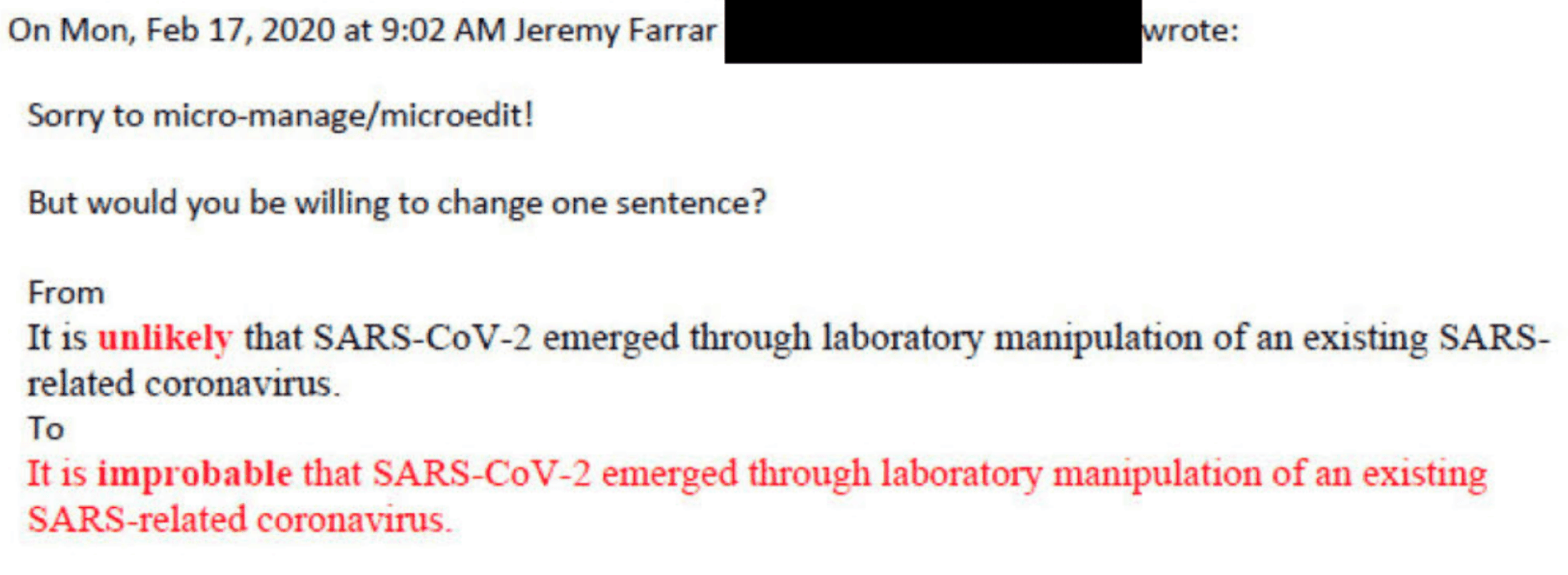
10:42 a.m.
Lipkin flags rumors circulating on Chinese social media about SARS-CoV-2 being a bioweapon.
Farrar promises to push Nature to publish the letter.

4:02 p.m.
The correspondence is published as a preprint on virological.org.
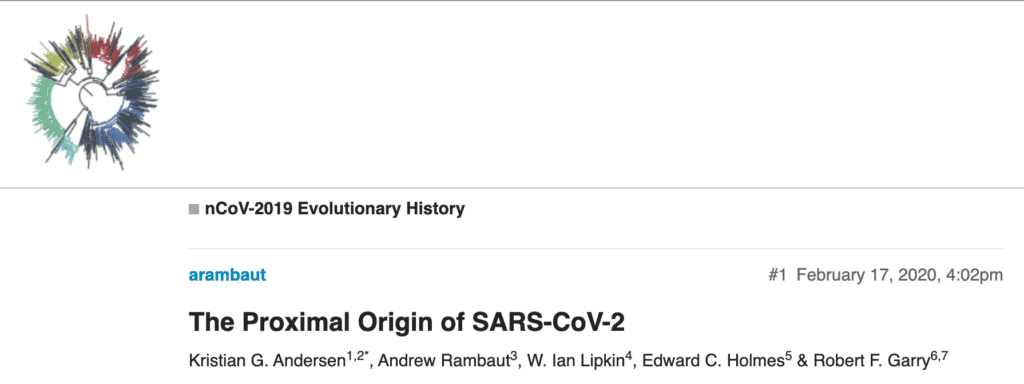
February 19, 2020: ‘Strongly condemn conspiracy theories’
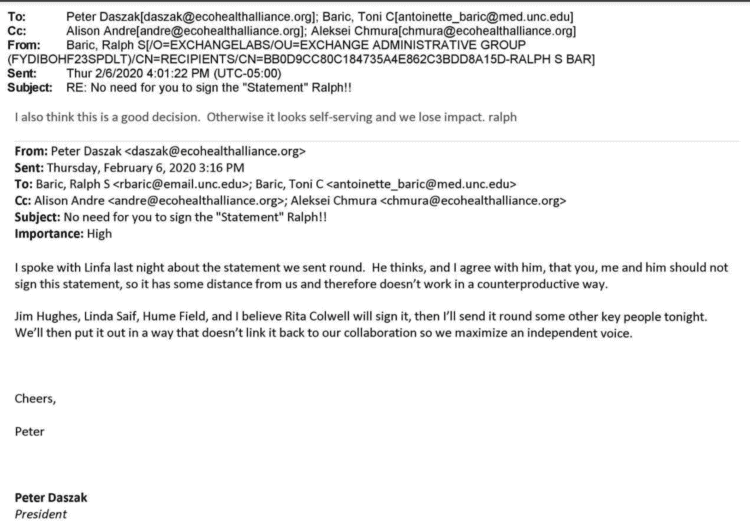
A letter in The Lancet to “strongly condemn conspiracy theories suggesting that COVID-19 does not have a natural origin” includes Farrar as a signatory.
EcoHealth Alliance President Peter Daszak organized the letter but purposefully omitted EcoHealth’s partnership with the Wuhan Institute of Virology and the name of University of North Carolina virologist Ralph Baric, a coronavirus engineering expert who works with EcoHealth and the lab, in order to feign impartiality.
The letter publicly called upon the WHO to play a role in curbing the lab leak theory.
The Lancet cited the National Academies letter, even though that letter had not asserted that the virus had a natural origin, despite Andersen’s pressure.
It’s not precisely clear when Farrar opted to sign The Lancet letter, but emails show that a first draft was sent to potential signatories on February 6.
February 21, 2020: ‘Newly available pangolin sequences do not … refute a lab origin’
Farrar’s pressure on the journal was working.
Within days, the paper was in peer review.
In making the case to peer reviewers that the paper was necessary, Andersen said that pangolin coronavirus sequences did not adequately address the pandemic’s origins.
These private emails stand in contrast to Andersen’s public statements that the pangolin sequences were central to his abrupt about-face from suspecting the virus was engineered to viewing that suspicion as “crank.”
“Unfortunately, the newly available pangolin sequences do not elucidate the origin of SARS-CoV-2 or refute a lab origin,” Andersen wrote. “There is no evidence on present data that the pangolin CoVs are directly related to the COVID-19 pandemic.”



Just as the group encountered resistance from some virologists who opposed treating the possibility of a lab origin with credence at all on the Feb. 1 teleconference, one peer reviewer made comments that questioned the necessity of the “overly speculative” paper.
Andersen underscored the necessity of weighing an accidental lab leak of a natural virus to establish credibility. Andersen dismissed the possibility of the virus being engineered outright.
“The culturing of SARS-like CoVs from animals is typically performed under BSL-2 and has been ongoing for years. Dismissing this potential accidental scenario out of hand – or considering it in the same category as conspiracy theories about bioweapons and deliberate engineering (that, as we outline, are clearly wrong) – would be irresponsible,” Andersen wrote. “Our manuscript will only serve its purpose if it considers all possible hypotheses equally. Any perceived bias will undermine its credibility.”
March 6, 2020: ‘Thanks for your advice and leadership’
The paper has been accepted by Nature Medicine. Andersen thanks Fauci, Farrar and Collins for “advice and leadership” with the paper, shares a press release, and asks if they have any further suggestions. Andersen loops in Garry, Rambaut and Lipkin.
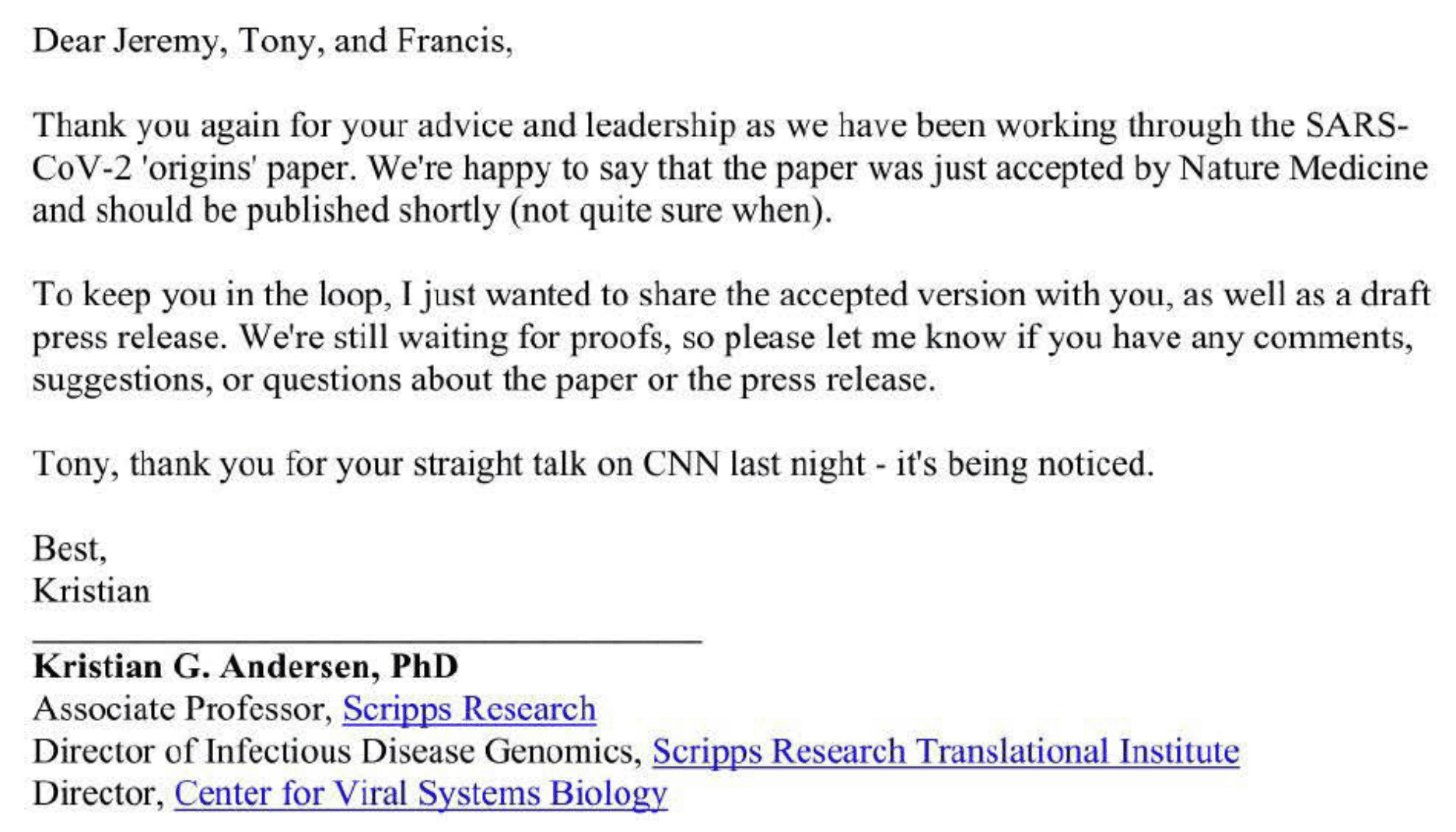
“Dear Jeremy, Tony, and Francis,
Thank you again for your advice and leadership as we have been working through the SARS-CoV-2 ‘origins’ paper. We’re happy to say that the paper was just accepted by Nature Medicine and should be published shortly (not quite sure when).
To keep you in the loop, I just wanted to share the accepted version with you, as well as a draft press release. We’re still waiting for proofs, so please let me know if you have any comments, suggestions, or questions about the paper or the press release.
Tony, thank you for the straight talk on CNN last night – it’s being noticed.”
March 8, 2020: ‘Nice job on the paper’
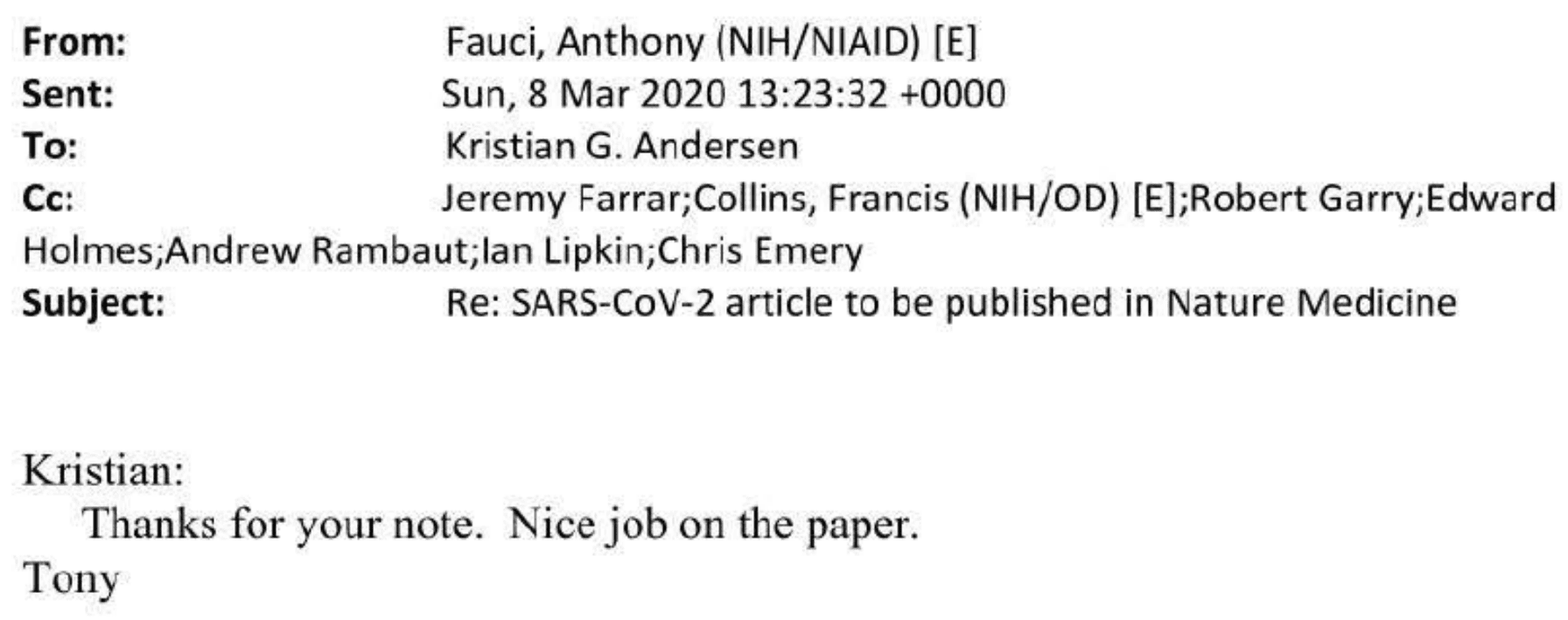
Fauci replies: “Thanks for your note. Nice job on the paper.”
Fauci recently told the New York Times he’s not sure he ever read it.
March 17, 2020: ‘Sorry, conspiracy theorists’
The paper is published in Nature Medicine and rejects the lab leak theory in even stronger terms than the preprint. The paper receives a lot of media attention.
Fox News: “The coronavirus did not escape from a lab: Here’s how we know”
Vice News: “Once and for All, the New Coronavirus Was Not Made in a Lab”
ABC News: “Sorry, conspiracy theorists. Study concludes COVID-19 is not a laboratory construct”
On the same date Daszak told Baric that the “proximal origin” letter helped dissuade national security officials from investigating the possibility of a lab origin of COVID-19, according to an email obtained by U.S. Right to Know.
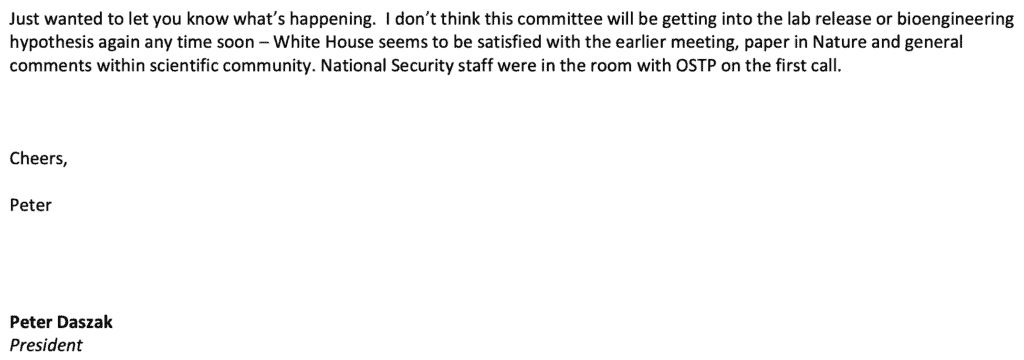
Despite the strong statements by the scientists and definitive headlines, Holmes would say two and a half years later that the scientists never intended the paper to be the final word.
“It’s just a paper. It’s not a papal decree. It’s not a government order. If you disagree with it, you can disagree with it,” he said in late 2022. “It’s science, right?”
March 26th, 2020: ‘Some folks are even making outrageous claims’
Collins publishes a blog post amplifying the study, but does not mention his own involvement in its conception.
“Some folks are even making outrageous claims that the new coronavirus causing the pandemic was engineered in a lab and deliberately released to make people sick,” he wrote. “A new study debunks such claims by providing scientific evidence that this novel coronavirus arose naturally.”
The “proximal origin” letter had enormous public relations power, but it had behind-the-scenes influence too.
On the same date, the State Department was briefed on the paper, according to a report by the department’s Bureau of Intelligence and Research.
April 16, 2020: ‘Wondering if there is something NIH can do to help put down this very destructive conspiracy’
Under the subject line “conspiracy gains momentum” Collins asks Fauci — copying NIH subordinates Lawrence Tabak, Cliff Lane, John Burklow — for more ideas on how to “put down” the lab leak theory.
Wondering if there is something NIH can do to help put down this very destructive conspiracy, with what seems to be growing momentum:
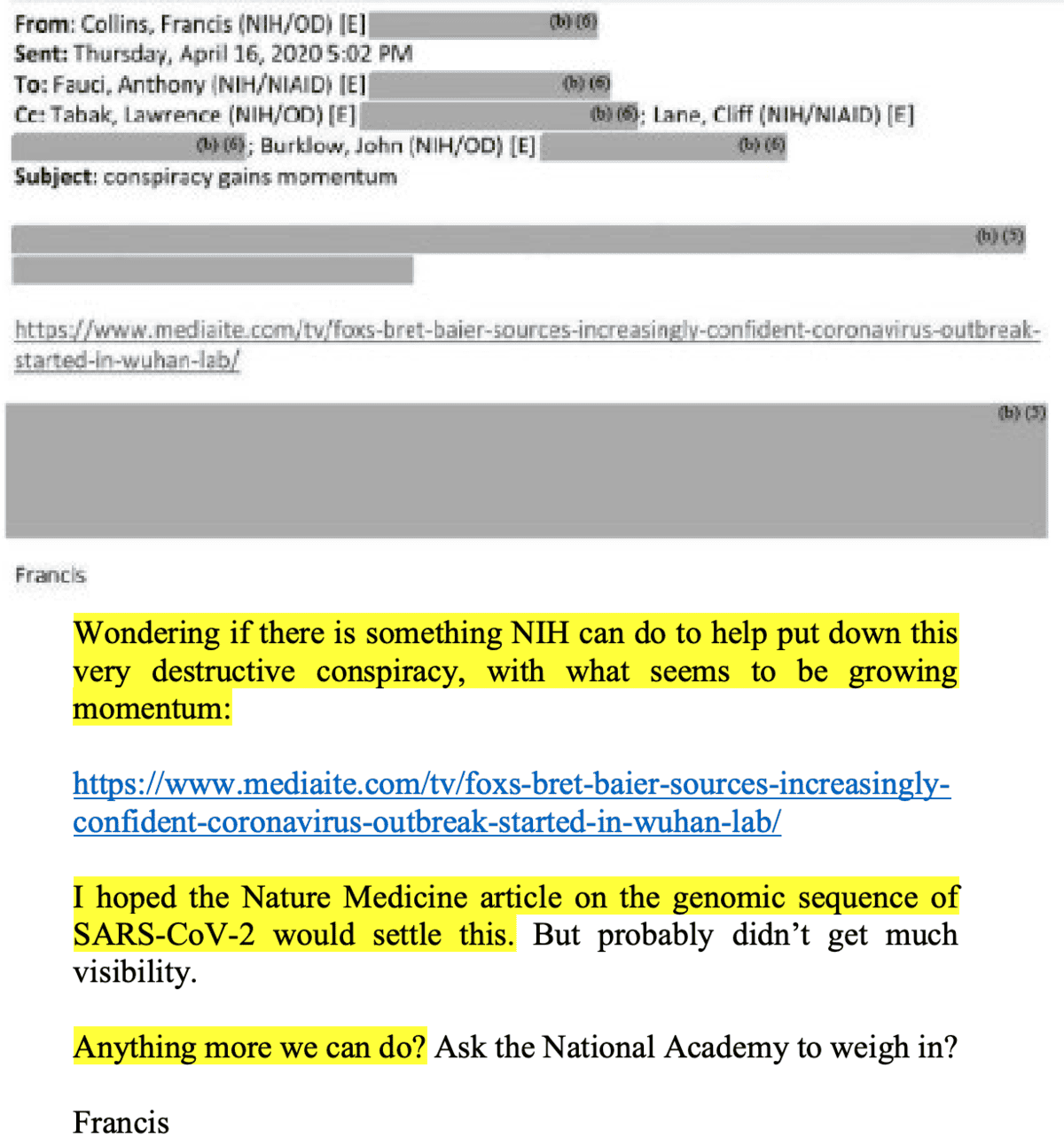
I hoped the Nature Medicine article on the genomic sequence of SARS-CoV-2 would settle this. But probably didn’t get much visibility. Anything more we can do? Ask the National Academy to weigh in?”
April 17, 2020: ‘It is a shiny object that will go away in times’
2:45 p.m.
Fauci tells the concerned Collins: “I would not do anything about this right now. It is a shiny object that will go away in times.”
6:22 p.m.
At a White House press conference, Fauci cited “proximal origin” and told reporters that the virus certainly arose naturally. Fauci adopted the phrase that Andersen had recommended to the National Academies.
He described the genome as “totally consistent with a jump of a species from an animal to a human.”
“I don’t have the authors right now, but we can make that available to you,” he said.
April 20, 2020: ‘Can you please help me get a copy of that paper?’
A reporter with The Washington Examiner followed up with NIH after the press conference to ask for a copy of the paper.
“Dr. Fauci on Friday said he would share a scientific paper with the press on the origin of the coronavirus. Can you please help me get a copy of that paper?” he wrote.
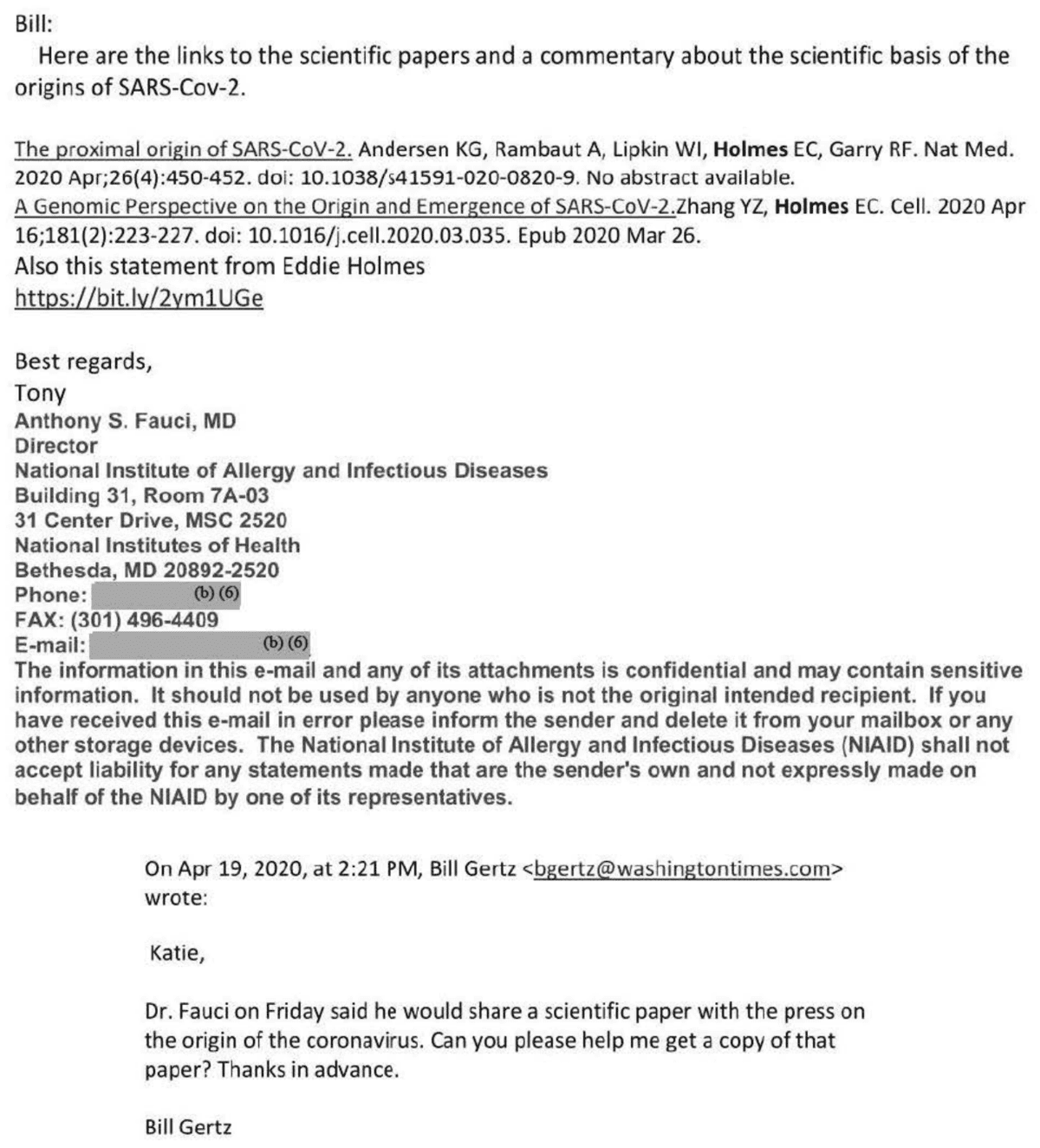
Fauci personally replied, sharing the “proximal origin” paper. Fauci also shared a paper coauthored by Holmes titled “A genomic perspective on the origin and emergence of SARS-CoV-2” and Holmes’ accompanying statement. Holmes argues in the statement that RaTG13 was sampled from Yunnan Province, while COVID-19 first appeared in Wuhan, and that the 20 to 50 years of evolution would be required to transform RaTG13 into SARS-CoV-2.
Holmes had not disclosed his own involvement in research on RaTG13.
May 5, 2020: ‘We deeply appreciate your efforts in steering and messaging’
Lipkin, a coauthor of the paper, forwarded Fauci an email exchange with Chen Zhu, China’s former Minister of Health, about COVID-19’s origins.
“We deeply appreciate your efforts in steering and messaging,” he wrote.
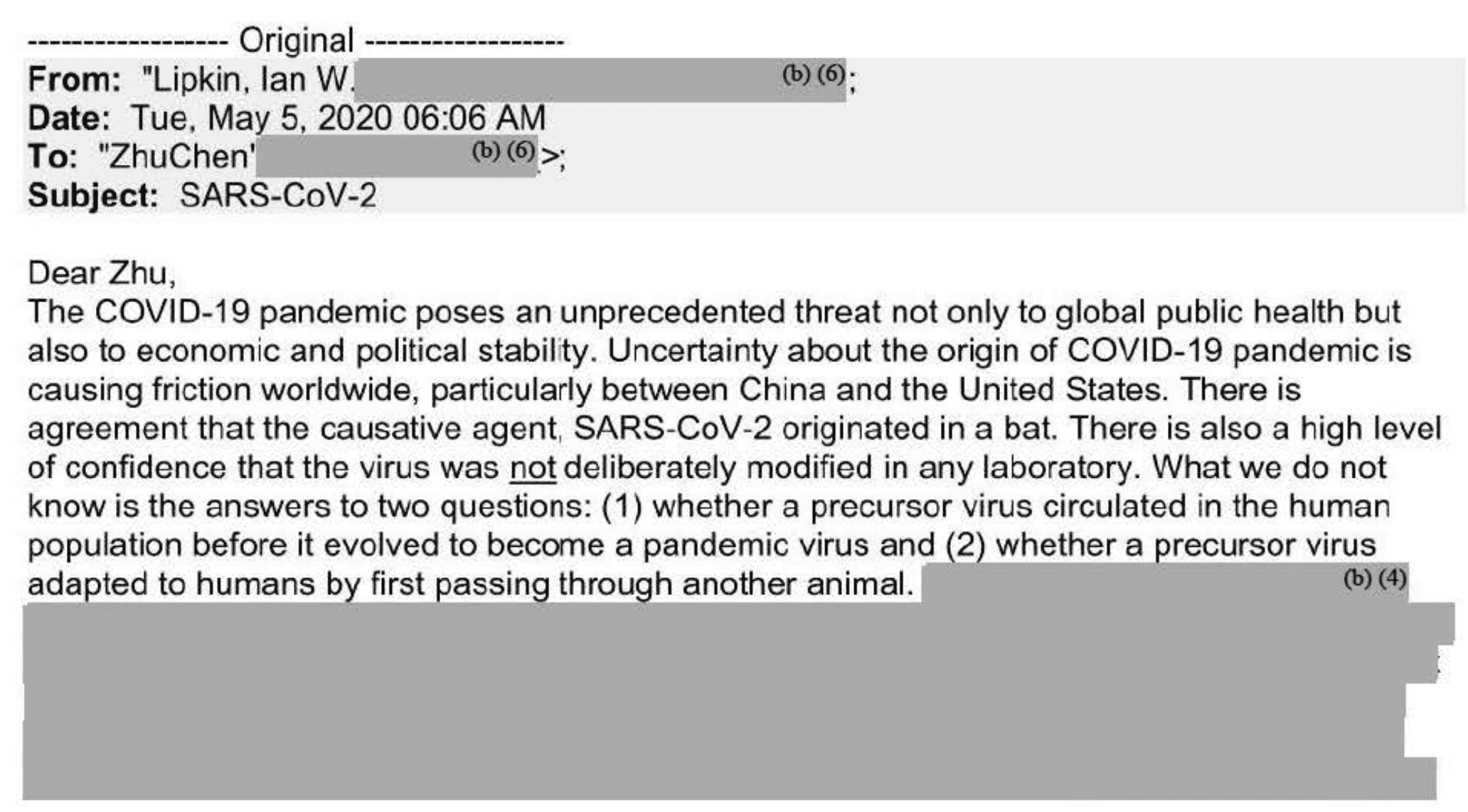
The details of his exchange with Chen are mostly redacted.
“Uncertainty about the origin of COVID-19 pandemic is causing friction worldwide, particularly between China and the United States. There is agreement that the causative agent, SARS-CoV-2 originated in a bat. There is also a high level of confidence that the virus was not deliberately modified in any laboratory,” Lipkin’s note reads in part.
July 25, 2020: ‘The authors who wrote the paper saying that SARS-CoV-2 is not human engineered first tried convincing Anthony Fauci of the opposite’
7:22 a.m.
“The authors who wrote the paper saying that SARS-CoV-2 is not human engineered first tried convincing Anthony Fauci of the opposite,” read the explosive subject line of an email sent by an anonymous tipster to Cohen, the journalist with Science magazine.
The tipster promised Cohen previously unknown details about the “bizarre backstory” of the paper.
“Hello Jon, Given your recent mentions of the origin of SARS-CoV-2 I thought you might be interested to hear the bizarre backstory of the paper ‘The proximal origin of SARS-CoV-2’ (https://www.nature.com/articles/s41591-020-0820-9).”
The email revealed the secret Feb. 1 teleconference to the journalist, including the detail that two leaders in biomedical funding had been present: Fauci and Farrar.
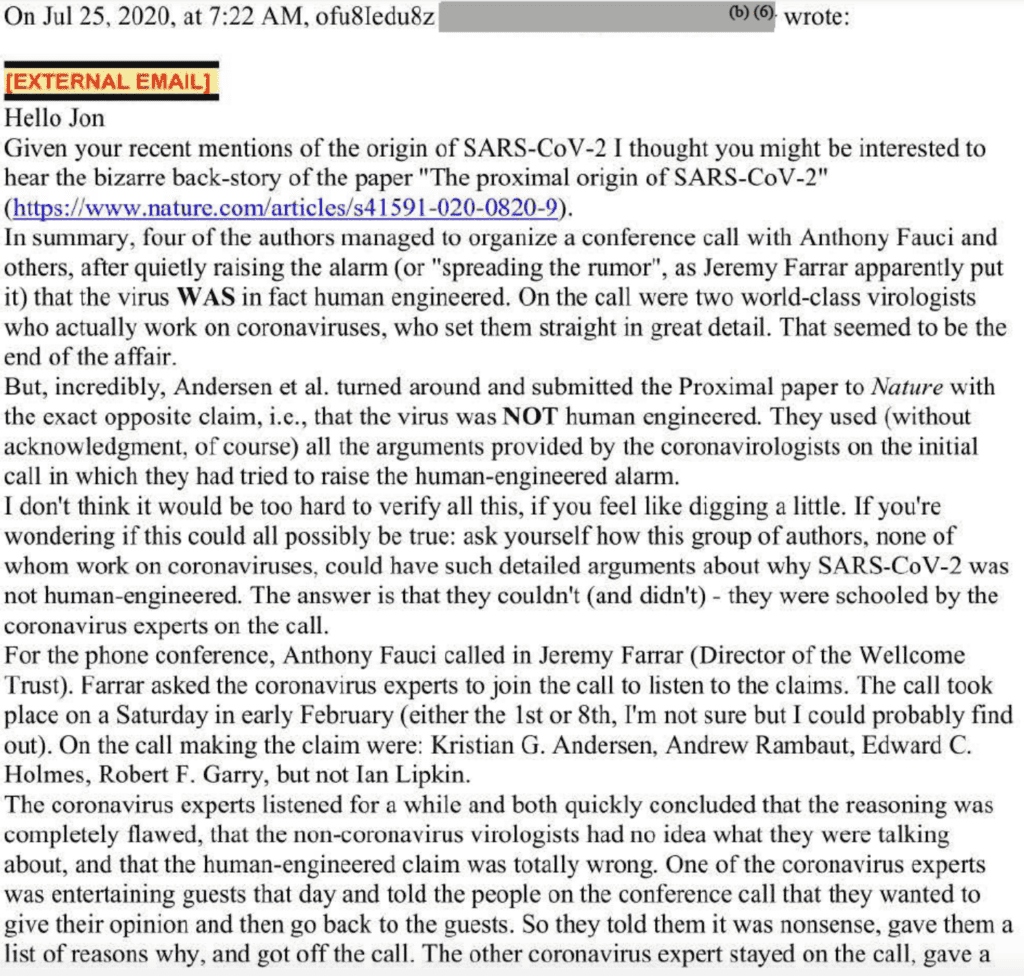
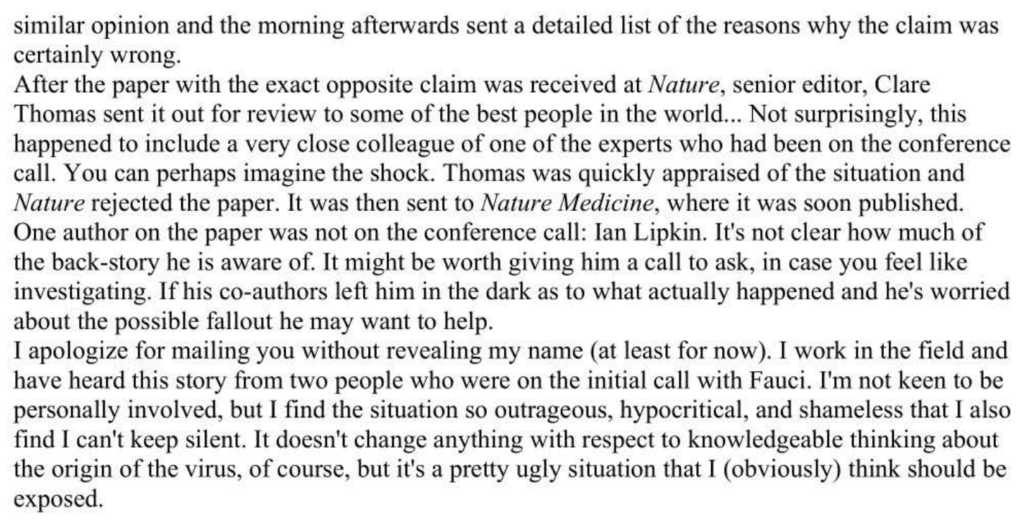
The tipster wrote that the authors of “proximal origin” had been convinced of a lab origin before the teleconference with other virologists more experienced in coronaviruses.
Two unnamed coronavirologists on the Feb. 1 call had “schooled” the virologists who ultimately authored the “proximal origin” correspondence, according to the tipster’s telling.
These other coronavirologists, though not credited on the final paper, had convinced them that the genome showed no signs of engineering after all.
(Subsequent emails made public under FOIA would demonstrate Fouchier’s important but uncredited influence on the article.)
July 25, 2020: ‘Here is what one person who claims to have direct knowledge is saying behind your backs’
Cohen forwarded the message to two sources: Holmes and Andersen.
“Here is what one person who claims to have direct knowledge is saying behind your backs…” he wrote.
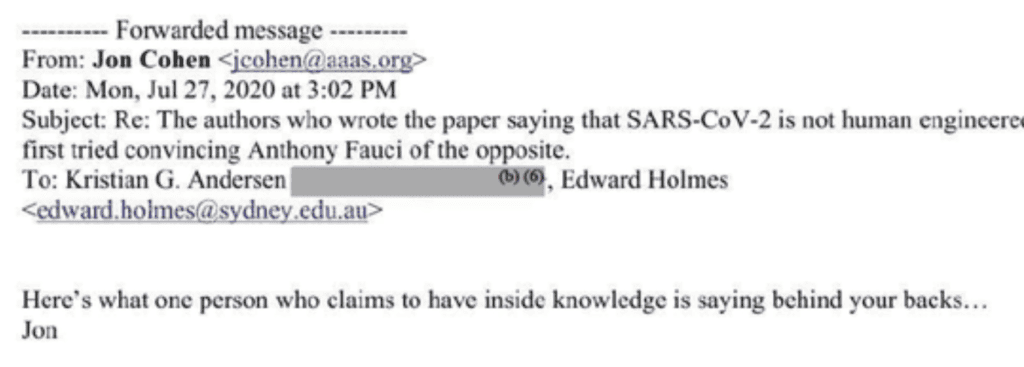
July 27, 2020: ‘We need to reply … which would have to include confirming that this meeting did indeed take place’
Andersen and Holmes conferred with Fauci and Farrar on how to respond.
Andersen asked Fauci if he had any “concerns or comments” about confirming the February 1, 2020, teleconference took place with him present. NIH redacted this detail from previously released versions of this email.
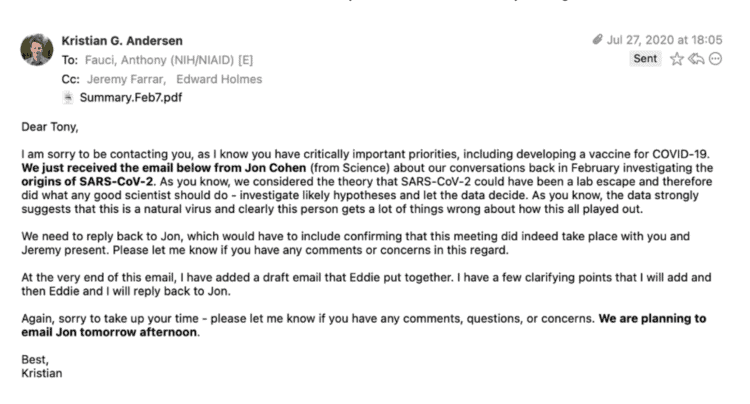
“We need to reply back to Jon, which would have to include confirming that this meeting did indeed take place with you and Jeremy present. Please let me know if you have any comments, questions or concerns in this regard,” Andersen wrote.
Andersen also attached the “Summary.Feb7.pdf” document.
July 28, 2020: ‘Spreading the rumor that the virus was human engineered’
8:30 a.m.
Holmes sends Fauci and Farrar his draft reply to Cohen.
His account of the events leading up to the drafting of “proximal origin” include key details. Comments by Rutgers microbiologist Richard Ebright as relayed by Harvard epidemiologist Marc Lipsitch were among the chatter that first alerted Farrar to the possibility of a lab leak, according to Holmes’ email.
Holmes summarized the teleconference and subsequent email discussions this way: “We have the conference call and then start an email chain about how we should deal with this. Writing it up for a paper was on the agenda and discussed.”
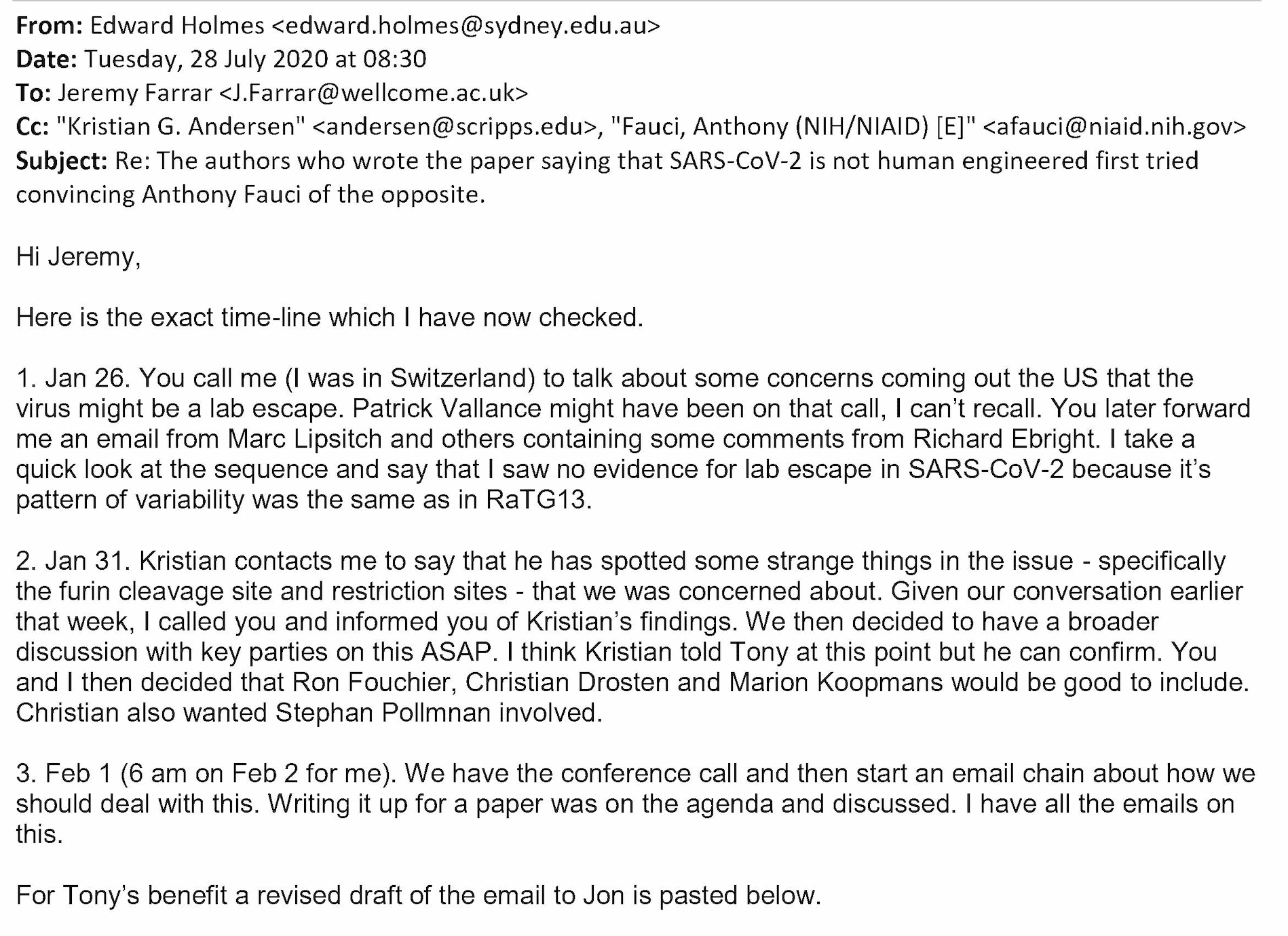
Farrar replies. He adds one more relevant date: January 8 or January 9, when high-level discussions about the genome first began. Those discussions included Collins.
“I would suggest we get the sequence of events absolutely right before replying,” he writes.
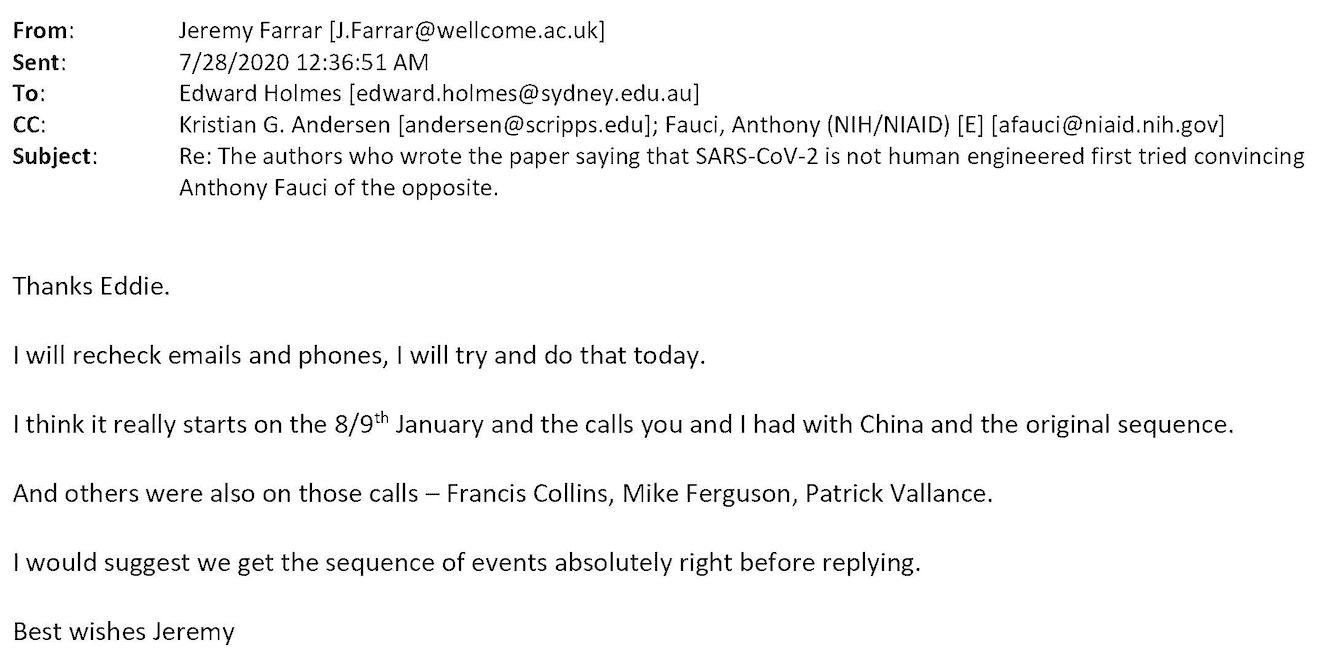
3:43 p.m.
Holmes sends his reply to Cohen, which confirms the teleconference but denies the tipster’s accusation that they were “spreading the rumor” that SARS-CoV-2 was engineered.
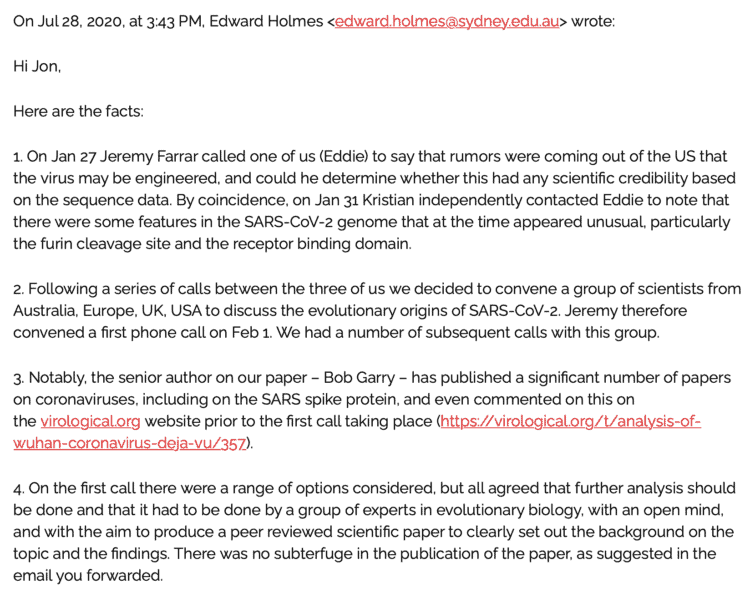
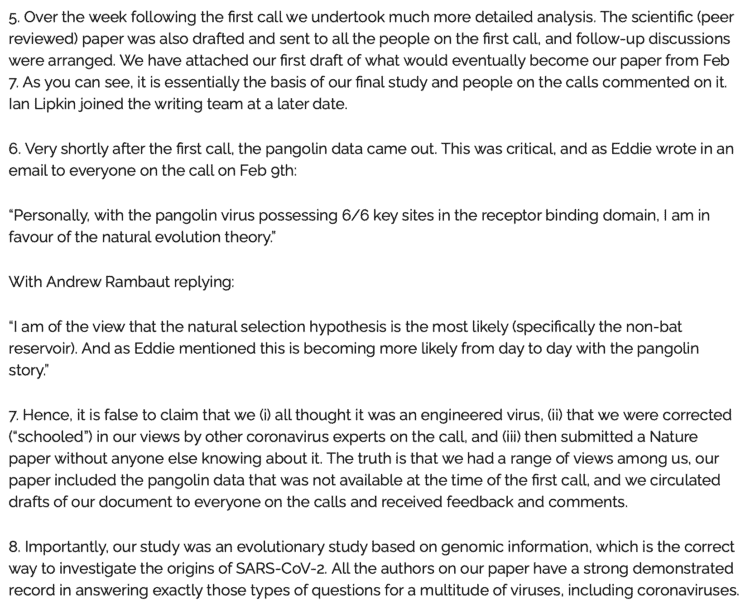
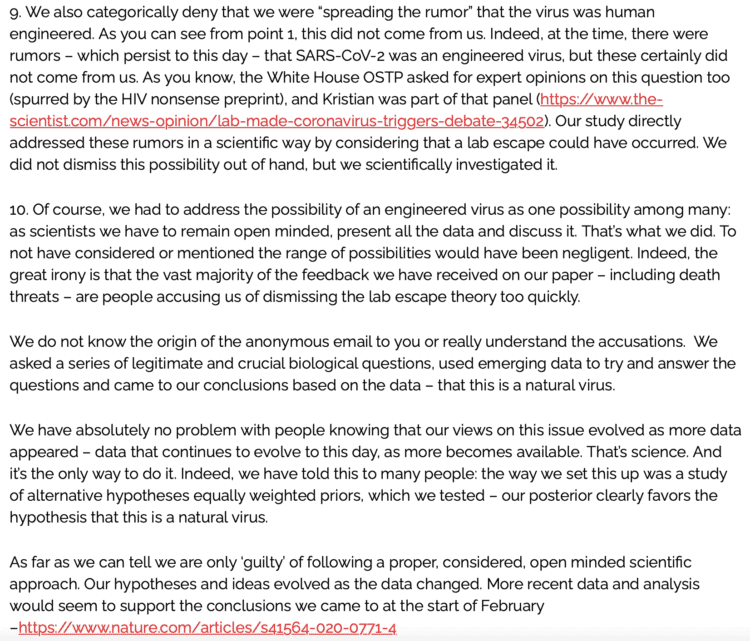
Cohen never wrote about the tip.
Cohen told U.S. Right to Know that he decided against writing about the tip because, in his view, it involved a petty grievance over credit.
That a teleconference had been convened to discuss concerns about the possibility of a lab origin would not be known for another year.
He released the relevant emails in a blog post just hours before they were released under FOIA.
August 19, 2020: ‘A woeful attack on the traditional way’
Collins and Fauci confer with former NIH Director Harold Varmus about three news articles.
One article described a letter from Michael Lauer, NIH deputy director for extramural research, seeking lab books and an inspection of the Wuhan Institute of Virology through EcoHealth Alliance as a condition of reinstating a grant.
“This whole episode is just a woeful attack on the traditional way NIH has maintained its integrity,” Varmus said in the article.
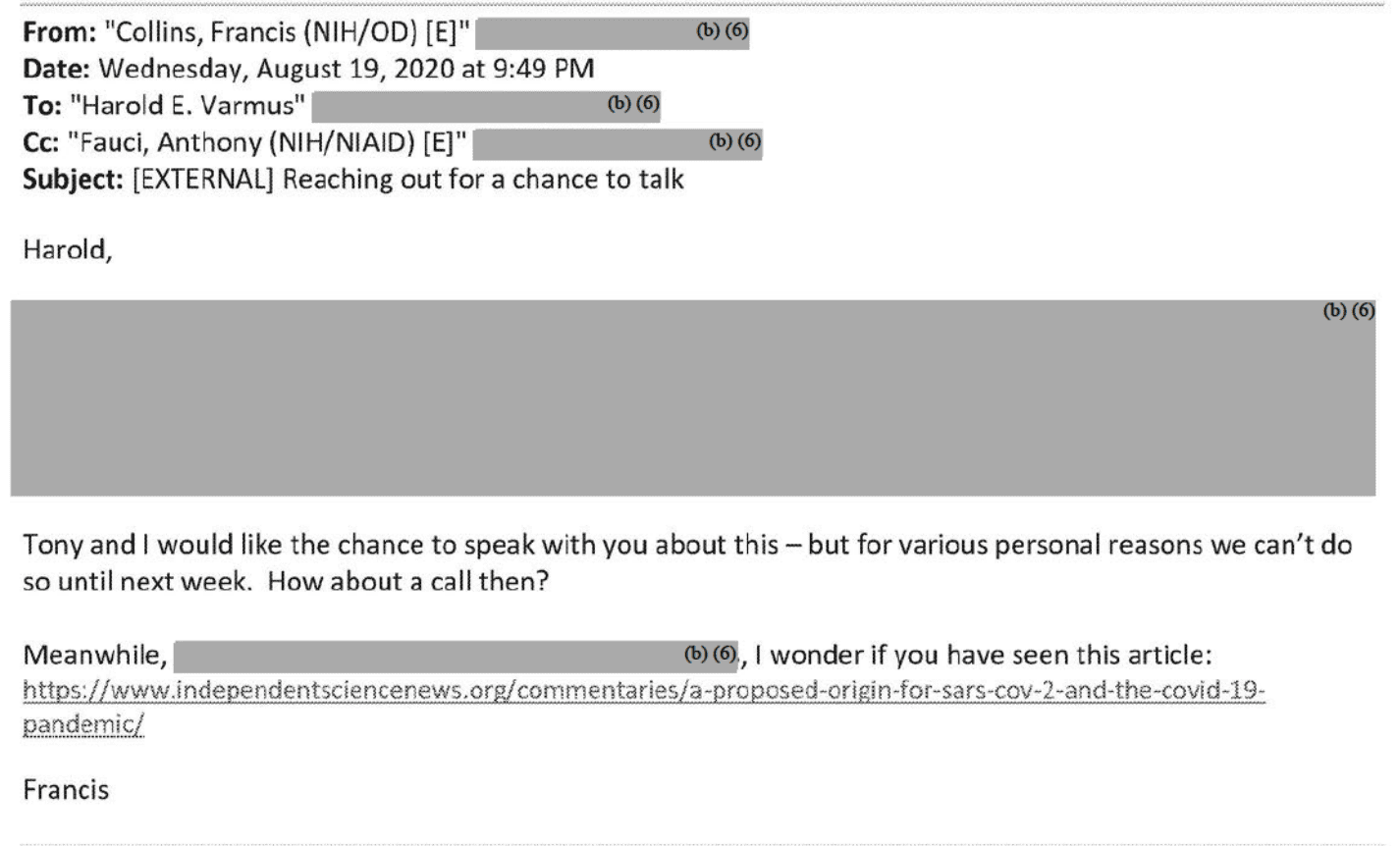
A second article postulated a lab origin of SARS-CoV-2.
A third article reported that NIAID had awarded a new grant to EcoHealth Alliance, despite not meeting the conditions set by Lauer.
August 27, 2020: NIAID awards funding to EcoHealth, Andersen
NIAID awarded $82 million over 5 years to a network of new Centers for Research in Emerging Infectious Diseases, including Andersen’s lab and the EcoHealth Alliance. (Garry, another author of the “proximal origin” paper, is a principal investigator on a CREID project with Andersen’s lab.)
“The impact of the COVID-19 pandemic serves as a potent reminder of the devastation that can be wrought when a new virus infects humans for the first time,” Fauci said in a statement. “The knowledge gained through this research will increase our preparedness for future outbreaks.”
March 30, 2021: ‘Extremely unlikely’
The World Health Organization’s report on COVID’s origins is released dismissing a lab origin as “extremely unlikely,” but Director-General Tedros Adhanom Ghebreyesus immediately suggests the investigation is incomplete.
Daszak and Koopmans, two scientists who had dismissed the lab leak theory in February 2020 — Daszak through The Lancet and Koopmans through an undisclosed role in writing “proximal origin” — comprised two members of the team.
The annex of the WHO report showed that when investigators visited the Wuhan Institute of Virology, lab leadership cited “proximal origin.”
“A paper by leading virologists in Nature rebutted the idea of a bioengineered source,” Shi told the WHO team.
June 1, 2021: ‘A clear example of the scientific process’
Redacted emails released by BuzzFeed News following a FOIA lawsuit revealed that the virologists behind “proximal origin” had initially found the genome “inconsistent with expectations from evolutionary theory.”
Andersen denied the idea that NIH shaped the article. Andersen deleted tweets before temporarily disabling his Twitter account amid the backlash.
“What the email shows is a clear example of the scientific process,” he told the New York Times in an email.
June 14, 2021: ‘Features that first appeared unique to SARS-CoV-2 were in fact found in other, related viruses’
Andersen responds to emailed questions from the New York Times about his abrupt turnaround on the virus genome appearing engineered.
“The features in SARS-CoV-2 initially suggested possible engineering were identified in related coronaviruses, meaning that features that initially looked unusual to us weren’t. … For example, we looked at data from coronaviruses found in other species, such as bats and pangolins, which demonstrated that the features that first appeared unique to SARS-CoV-2 were in fact found in other, related viruses.”
The pangolin coronavirus sequences did not include the unusual furin cleavage site.
These public statements are contradicted by Andersen’s private statements that the pangolin coronavirus sequences do not refute a lab origin.
June 20, 2021: ‘I want to be clear that I never suggested you delete … the preprint’
Fred Hutchinson Cancer Research Center evolutionary biologist Jesse Bloom reached out to Collins and Fauci about a forthcoming preprint reporting that NIH deleted early SARS-CoV-2 genomic data sampled in Wuhan from its public database, and to ask about recovering other data that may have been deleted that could shed light on the virus’ evolution.
Collins scheduled a Zoom call for June 20, a Sunday, according to a Vanity Fair report.
The NIH leaders invited two of the coauthors of the “proximal origin” paper: Andersen and Garry.
Andersen urged Bloom to allow him to spike the preprint, according to Bloom’s notes. Fauci distanced himself from those comments by Andersen, but did ask Bloom not to use the word “surreptitiously.”
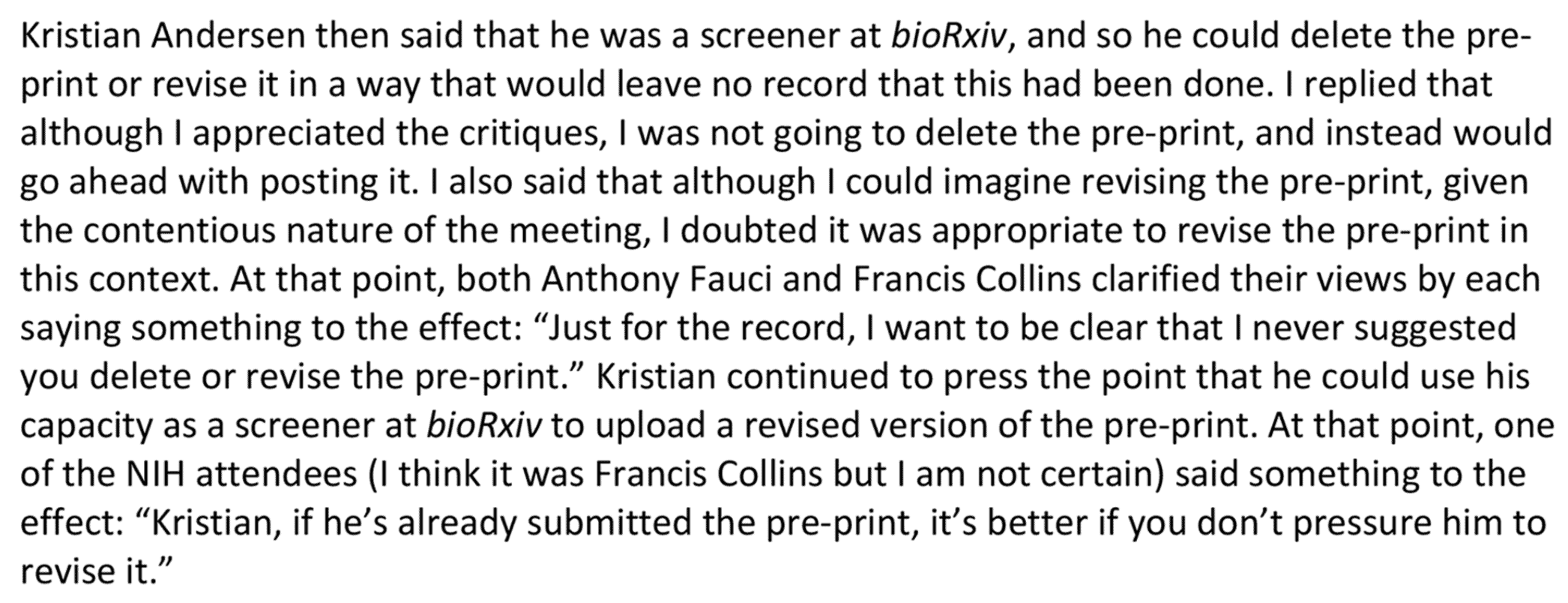
Bloom declined to delete his paper.
August 18, 2021: ‘Dr. Andersen has objectively weighed all of the evidence’
Andersen’s lawyer told Congressional Republicans that he weighed the evidence objectively and that Fauci did not attempt to change his views.
“Dr. Fauci did not, in Dr. Andersen’s view, attempt to influence Dr. Andersen or any other member of the ad hoc working group of international subject,” the letter read.

January 12, 2022: ‘That will just add fuel to the conspiracists’
Congressional staff and NIH negotiated an agreement to view unredacted copies of the emails obtained by BuzzFeed in June in camera. In other words, congressional staff could view the emails at NIH, transcribe them, and describe their contents, but not reproduce copies.
The fully unredacted notes starkly showed concerns among the authors about unusual features of the genome.
Garry insisted that the participation of the NIH did not influence their analysis in emails to The Intercept.
“Neither Drs. Fauci or Collins edited our Proximal Origins paper in any way. The major feedback we got from the Feb 1 teleconference was: 1. Don’t try to write a paper at all — it’s unnecessary or 2. If you do write it don’t mention a lab origin as that will just add fuel to the conspiracists,” Garry said in an email to the outlet.
After the story published, Garry emailed a follow-up comment: “One thing that could be misconstrued is that neither Dr Fauci or Dr Collins suggested in any way that we not write the Proximal Origin paper. Likewise, neither one suggested that we not mention the possibility of a Lab origin. These were comments from others in emails after the call.”
July 1, 2022: Lipkin revealed to be former EcoHealth partner
Lipkin, a coauthor of “proximal origin,” was found to have once been featured as a “partner” on the EcoHealth Alliance website.
Lipkin, once an EcoHealth Alliance partner, told colleagues in a 2017 email obtained by U.S. Right to Know that he worked directly with scientists at the Wuhan Institute of Virology.
“We could have joined in the development of this lab. It’s not too late to become engaged,” Lipkin said. “I’ve visited Wuhan and have active collaborations with scientists in Wuhan through USAID/PREDICT and the CAS.”
These conflicts are not reported in the paper’s conflict of interest section.
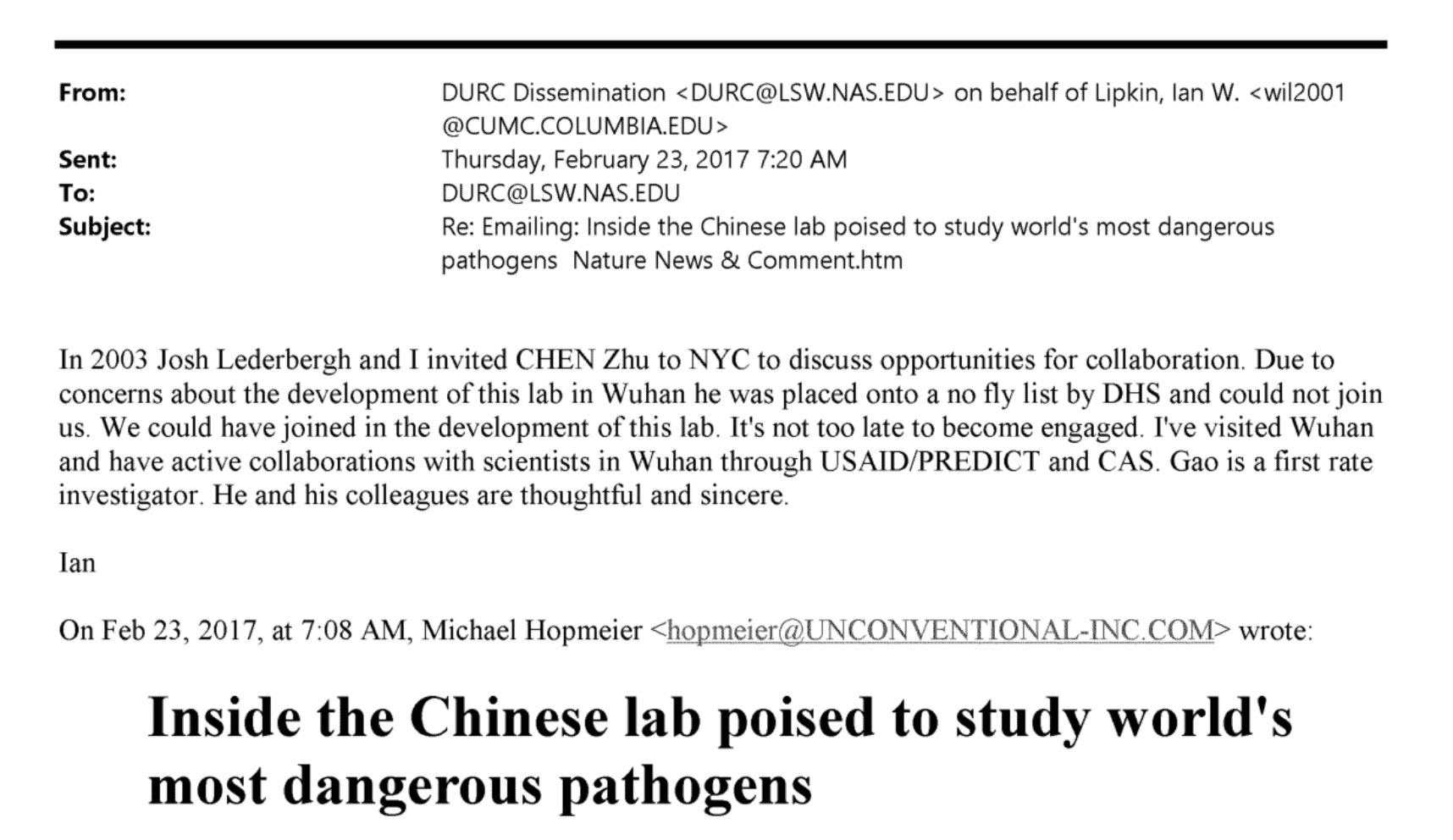
July 31, 2022: Tie between Holmes and Wuhan Institute of Virology
One hundred and sixty-three partial sequences describing SARS-like coronaviruses appeared on an NIH database, but quickly disappeared from the database’s search results. (These partial sequences remain searchable to people who know their accession numbers.)
Two of the authors are Shi, senior scientist at the Wuhan Institute of Virology, and Holmes, a coauthor of the “proximal origin” paper.
The uploads included partial sequences of RaTG13, a cousin virus to SARS-CoV-2.
“The really shocking thing about these submissions was that my name was on them … I couldn’t compute. I thought, ‘why am I on this?’” Holmes said in a September 2022 interview. “Then I looked back, and it turns out there was this paper that was never published.”
Holmes had contributed analysis and helped write an unpublished paper about bat coronaviruses in January 2018 at the request of a Shanghai scientist named Jie Cui, he said.
“It’s just some [phylogenetic] trees and some recombination analysis,” Holmes said. “They’re interested particularly in what they call the ‘southern lineage,’ and where there was SARS1, and where SARS1 bat viruses are found in Guangdong and Yunnan Province. … Is there a lineage that goes along that southern part of China?”
A handful of journals rejected the paper because it does not include full genomes. Cui struggled to obtain the full genomes. The paper was withdrawn in October 2018.
“This is why I completely forgot about it, because it was never published,” Holmes said.
Holmes has provided the partial sequences to the World Health Organization’s Scientific Advisory Group on the Origins of Novel Pathogens, which is investigating the origins of COVID-19.
The connection between Holmes and the Wuhan lab has gone undisclosed in Nature Medicine.
Meanwhile, Holmes has dismissed concerns that his contribution to this paper could cloud his analysis on the origins of COVID-19 as an “idiotic claim.”
“I genuinely forgot about this paper,” he added.
Correction, 4/11/23: A previous version of this article stated that the “proximal origin” article did not address the possibility of the virus emerging from serial passage. The article has been corrected to state that the “proximal origin” paper addresses the possibility of serial passage as less likely than the “much stronger and more parsimonious explanation” of a natural origin.
Correction, 12/8/22: This story inaccurately reported that it was not yet known that pangolins were not sold at the Huanan Wholesale Seafood Market at the time “proximal origin” was drafted in February 2020. In fact it had been reported by February 7, 2020, that pangolins were not in the market’s inventory.
Correction, 10/25/22: This story mischaracterized a 2015 coronavirus gain-of-function study as having moved forward after a pause on gain-of-function work on SARS, MERS, and influenza work was lifted in 2017. In fact NIH had granted an exception to the study authors during the pause.









